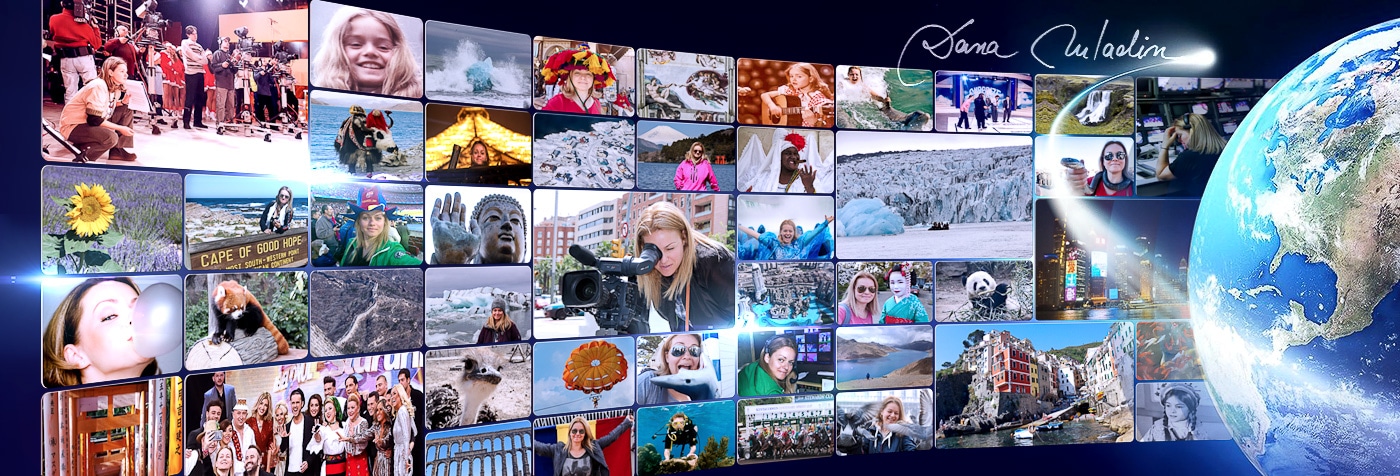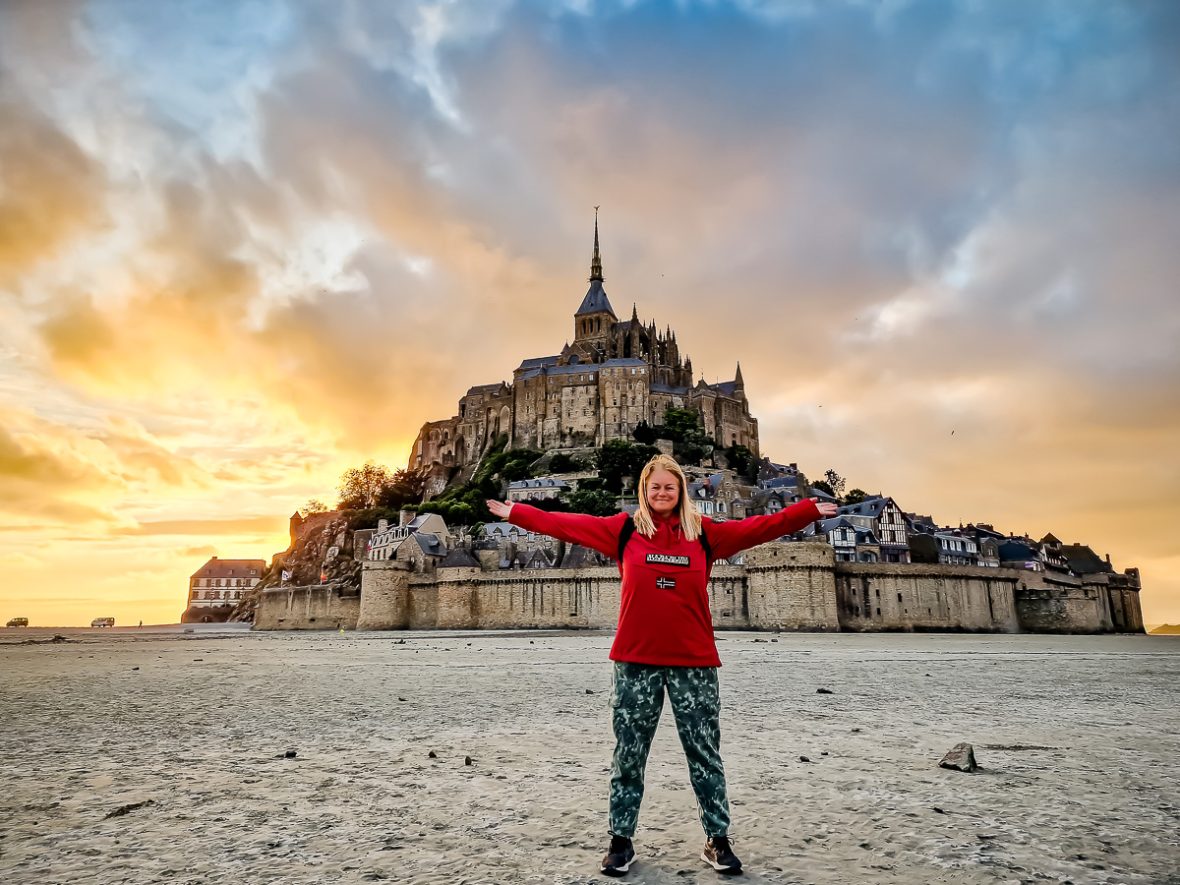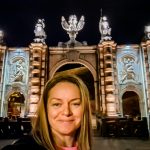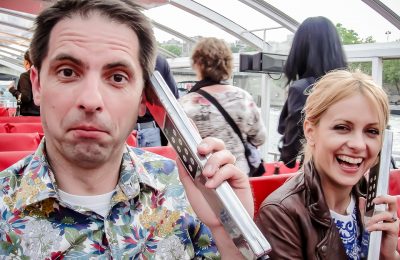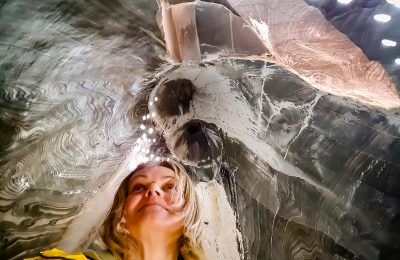My entire vacation in Normandy, France, was driven by a clear desire: to visit Mont Saint-Michel again!
A place I saw for the first and only time in the year… brace yourselves, we’re going back to another millennium: in 1986!!!
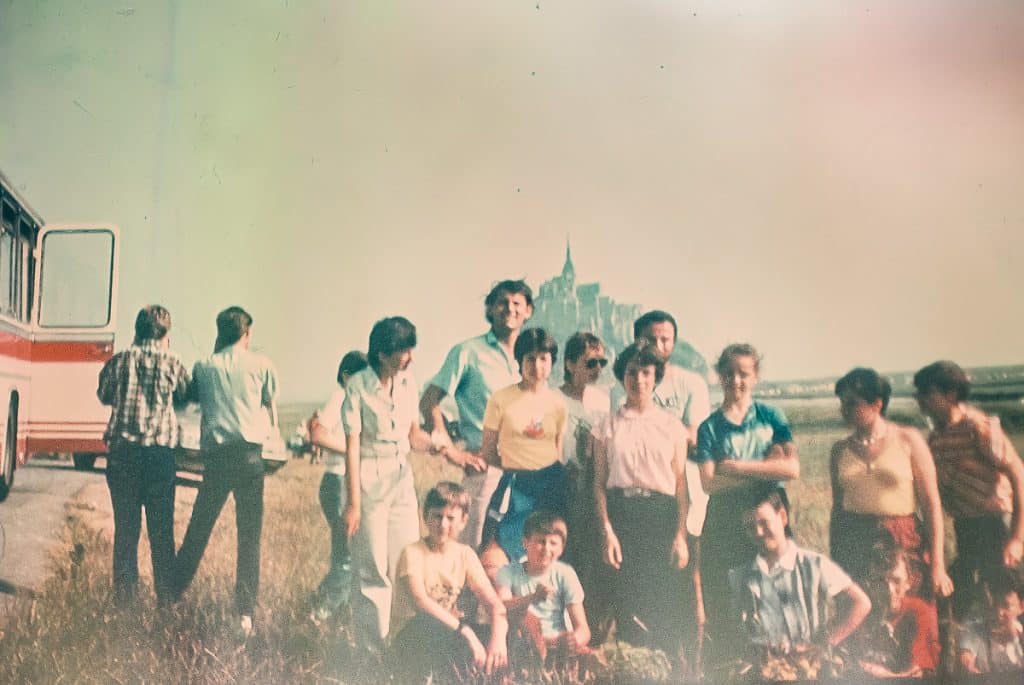
Nearly 40 years ago, I was fascinated by the imposing “castle” surrounded by waters, in front of which, as a child, I stood in awe, mouth wide open.
Over the years, I kept thinking about it, following it on social media :), wishing to see it again, but I never found the time for northwestern France.
This time, I did, and since I had no other plans in mind, I said to myself: “That’s it, I’m going to Mont Saint-Michel!”
After a journey through Normandy, which I’ll write about soon, I finally arrived there!
HOW TO GET TO MONT SAINT-MICHEL
Right up to its gate? Not by car, that’s for sure. This is the first major difference I noticed compared to my first visit here.
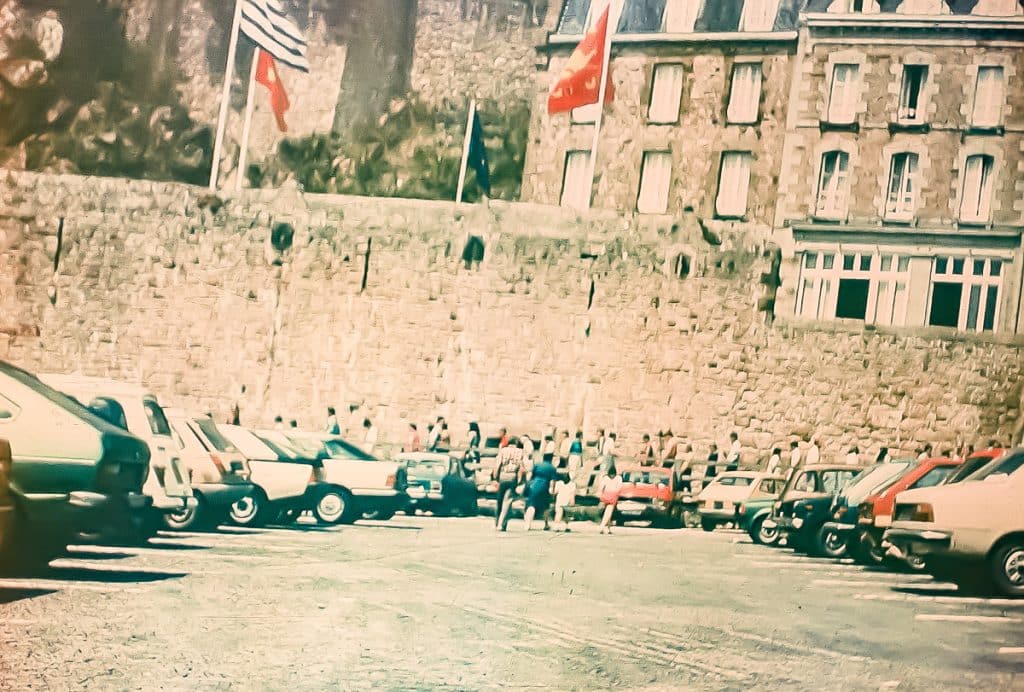
I remembered that almost 40 years ago, we took a bus that dropped us off in a long parking lot, packed with cars, right next to the Mont.
Now, car access here is strictly forbidden. You either leave it in a large parking area a few kilometers away, or, if you have accommodation nearby, in a zone with restricted access, you receive a code from the hotel and can park your car peacefully (though for a fee…).
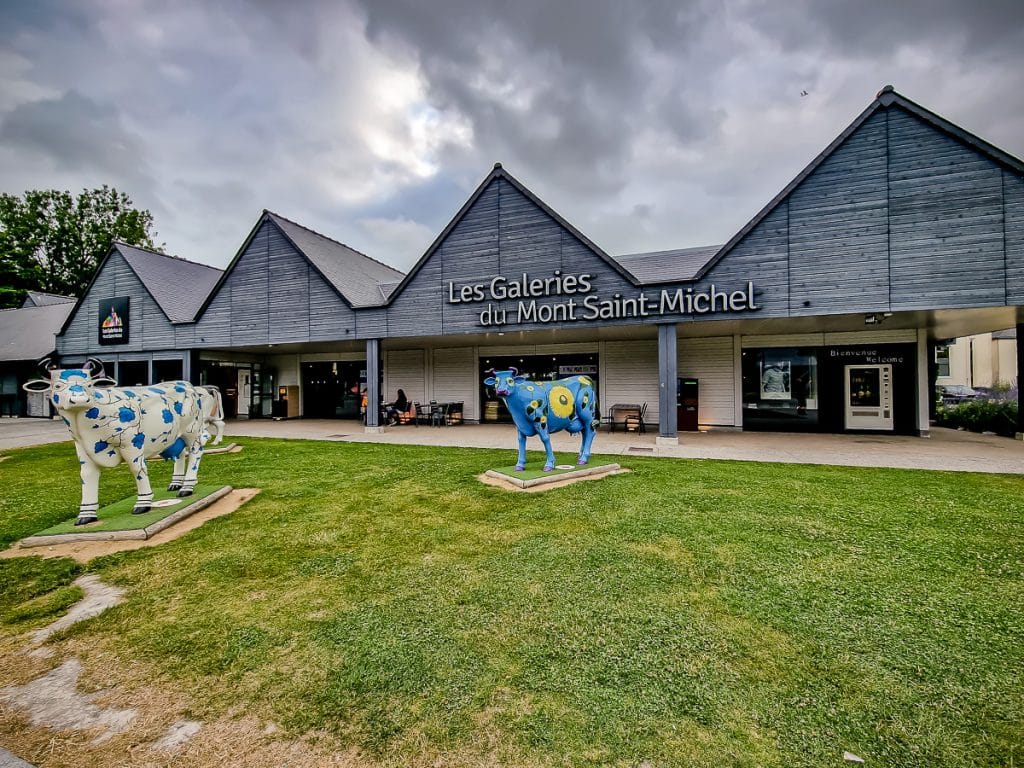
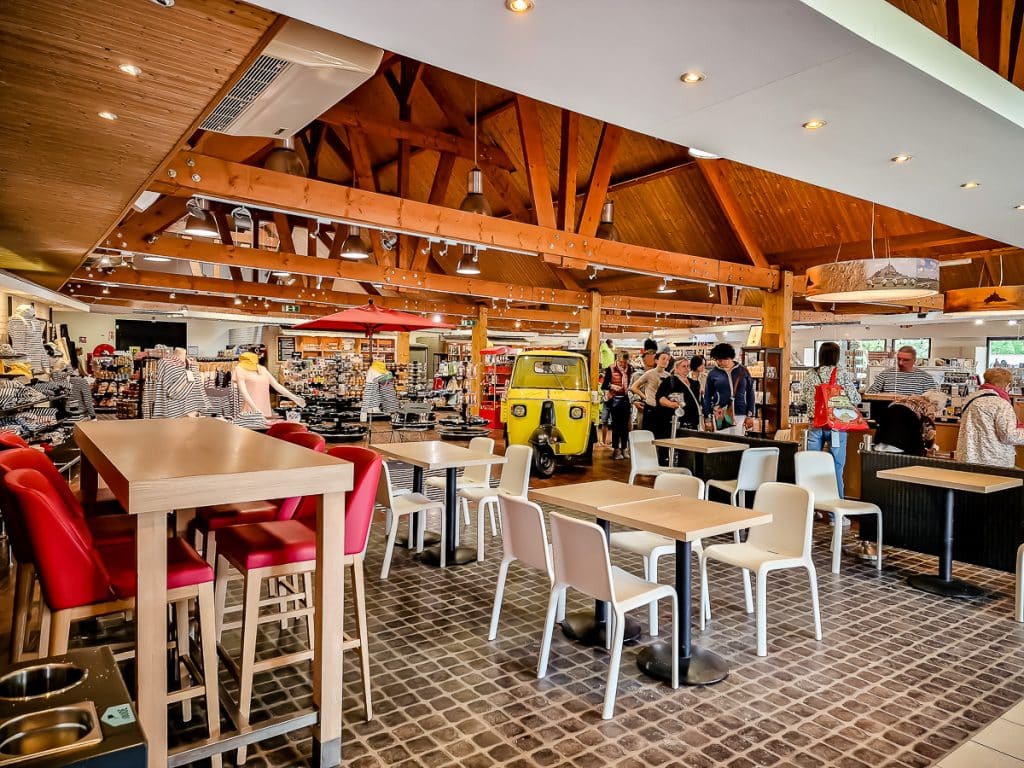
In this area I mentioned, there are a few hotels, restaurants, a shop, and… not much else.
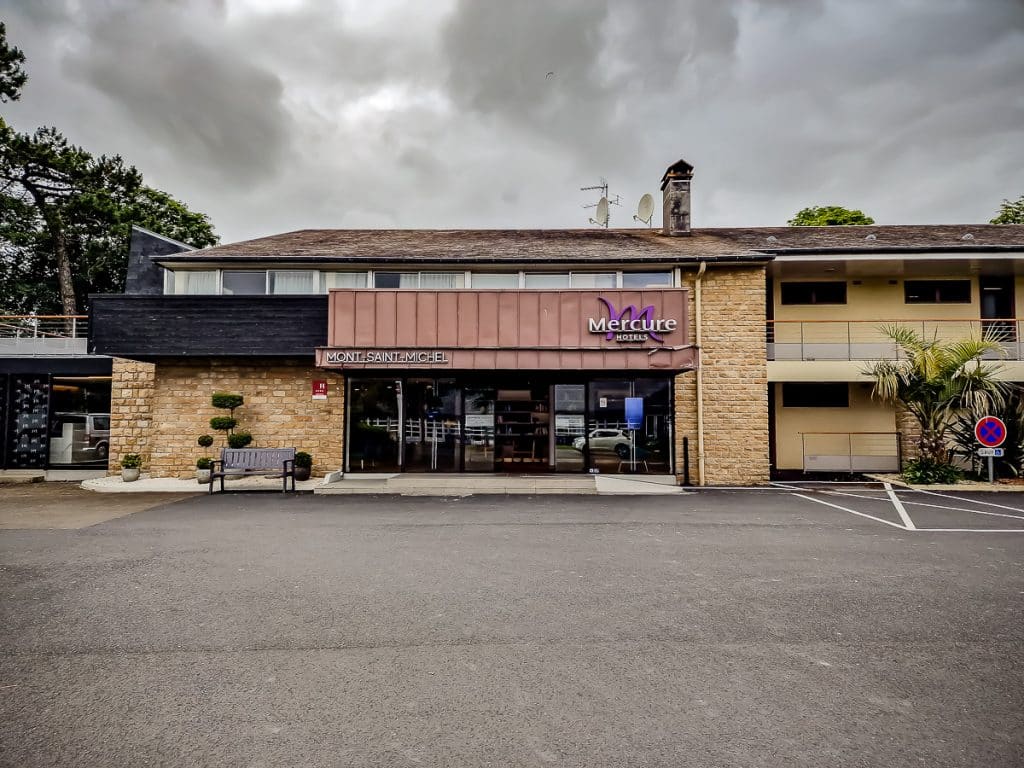
I stayed at Mercure. It was the first one I found online with a good rating and reasonable price. On-site, I discovered another one, Relais Saint Michel, located right before the bridge to Mont Saint-Michel, with the advantage of offering views of the island!
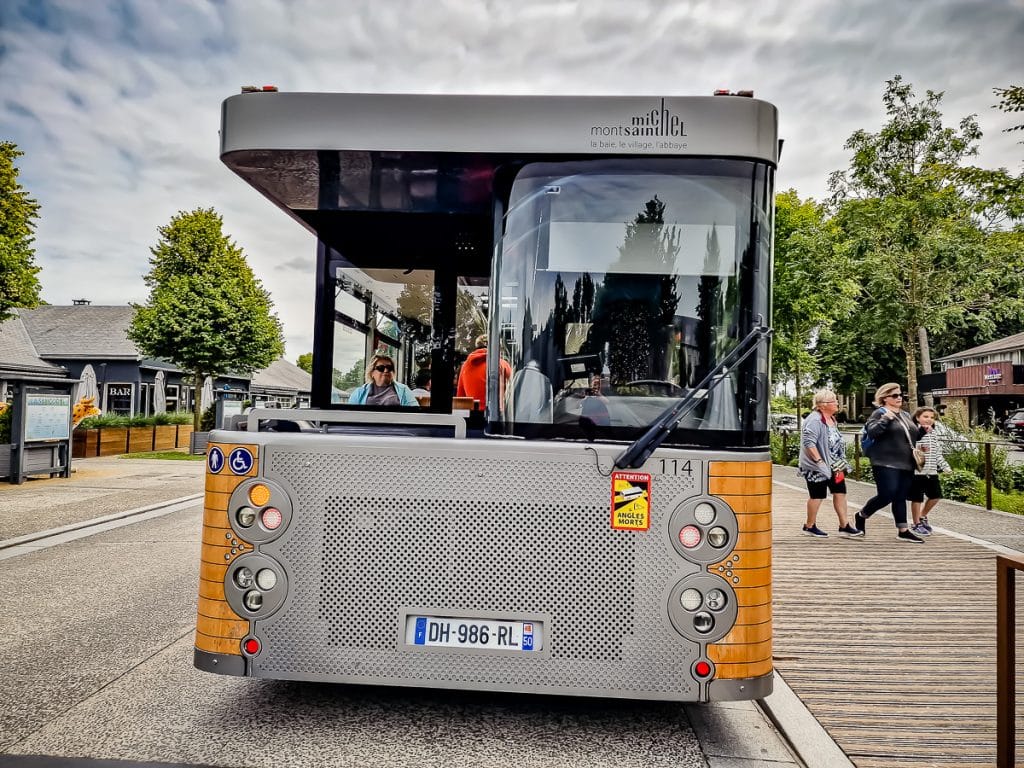
Once you’ve dealt with your own/rented car, you head towards Mont Saint-Michel on foot, via the footbridge that leads to it – 2 kilometers – or you can take a charming shuttle bus, a service called “Le Passeur”, which runs from early morning to late at night (7:00 AM to 1:00 AM from July to October, 8:30 AM to 10:00 PM in the off-season, and 7:30 AM to 11:00 PM during the mid-season, like June). It’s free, you don’t pay anything.
One end of it is right at the large parking lot outside the restricted access area, and the other end is just three stops away, at Mont Saint-Michel.
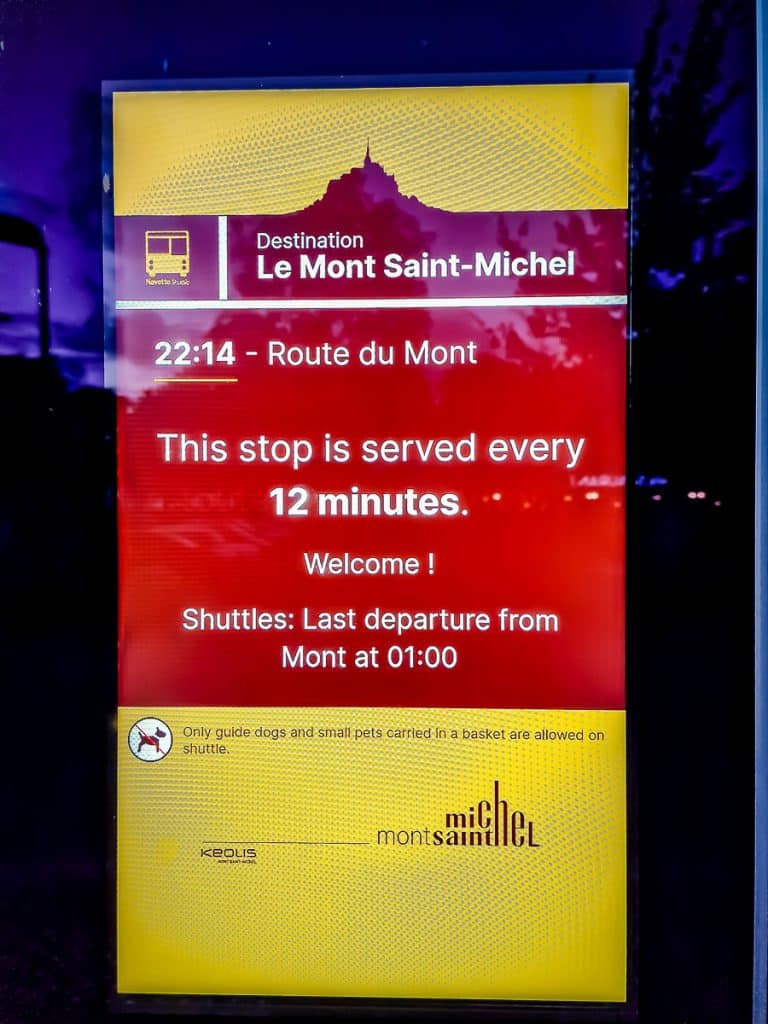
During the day, the bus runs every 4 minutes. In the evening, less frequently – every 12 minutes.
The schedule is always displayed at the station.
VISITING MONT SAINT-MICHEL
It’s 9:15 PM. I throw my bags into the room and literally run, as if the Mont will move if I don’t get there in the next few minutes. It’s 16 degrees outside (on the last day of June!).
I take advantage of the fact that the bus stop is right in front of the hotel and hop on the first one that comes.
The bus passes through the barrier and onto the bridge leading to the Mont.
When I see it growing larger before my eyes, I feel a wave of emotion I haven’t experienced in a long time when seeing a place in this world!
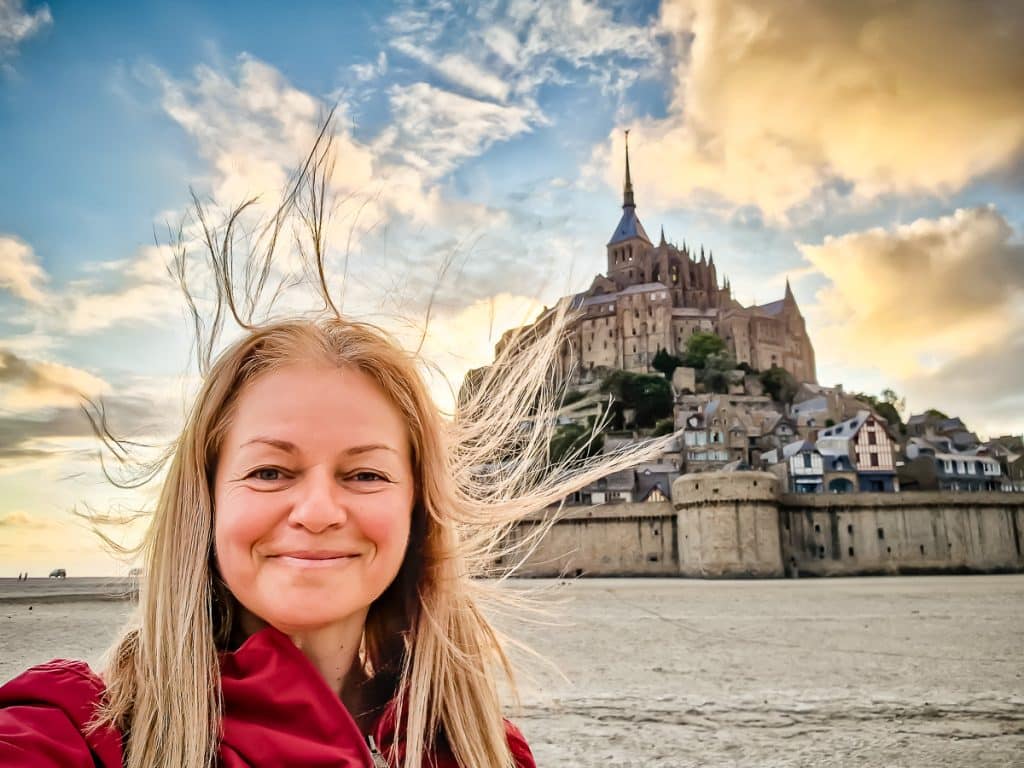
Oh, how happy I am to be here! I feel like a child, I could squeal with excitement!
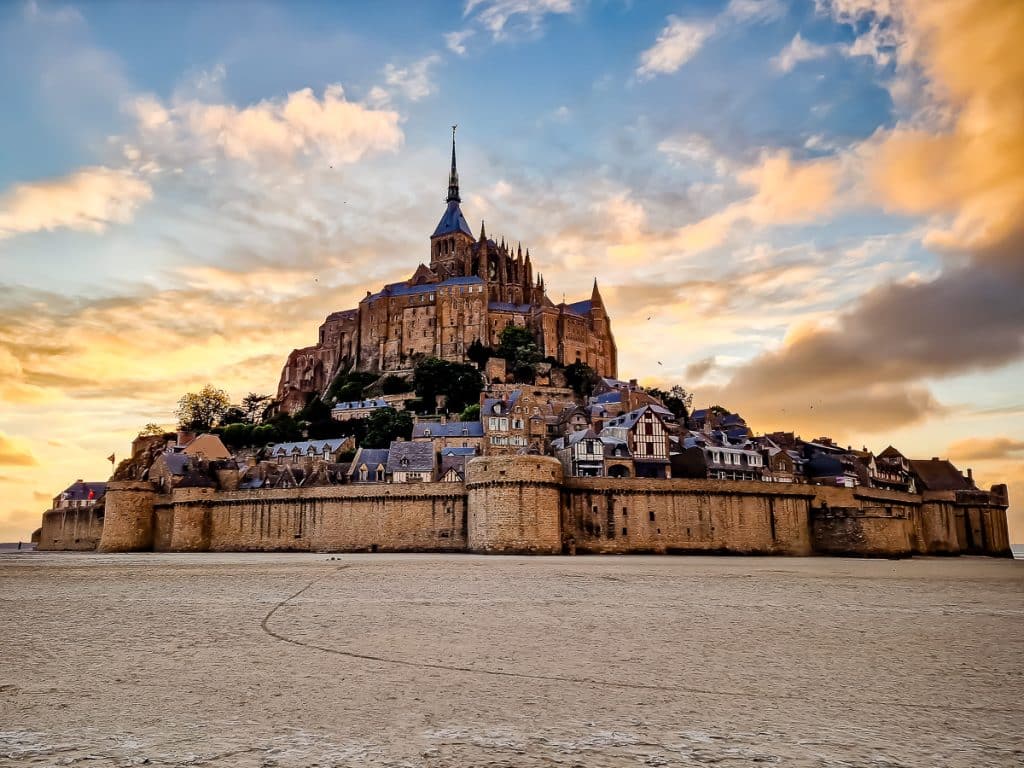
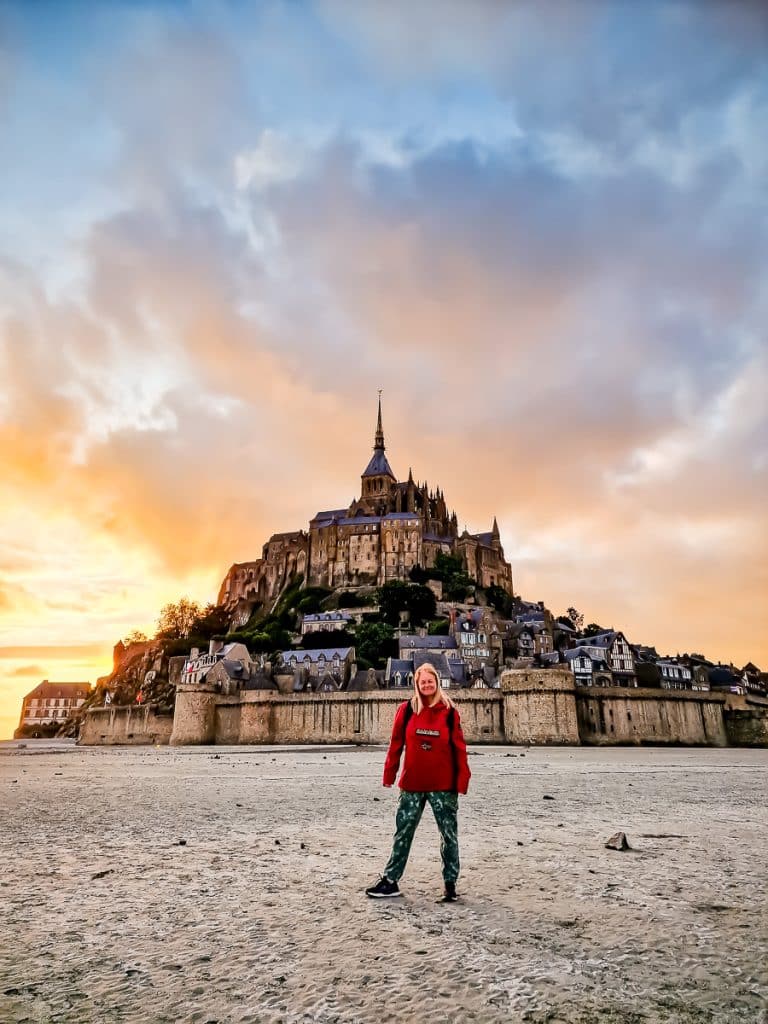
The sun sets slowly, and Mont Saint-Michel looks like something out of a fairy tale!
I step onto the sand and walk as if I were on my own property.
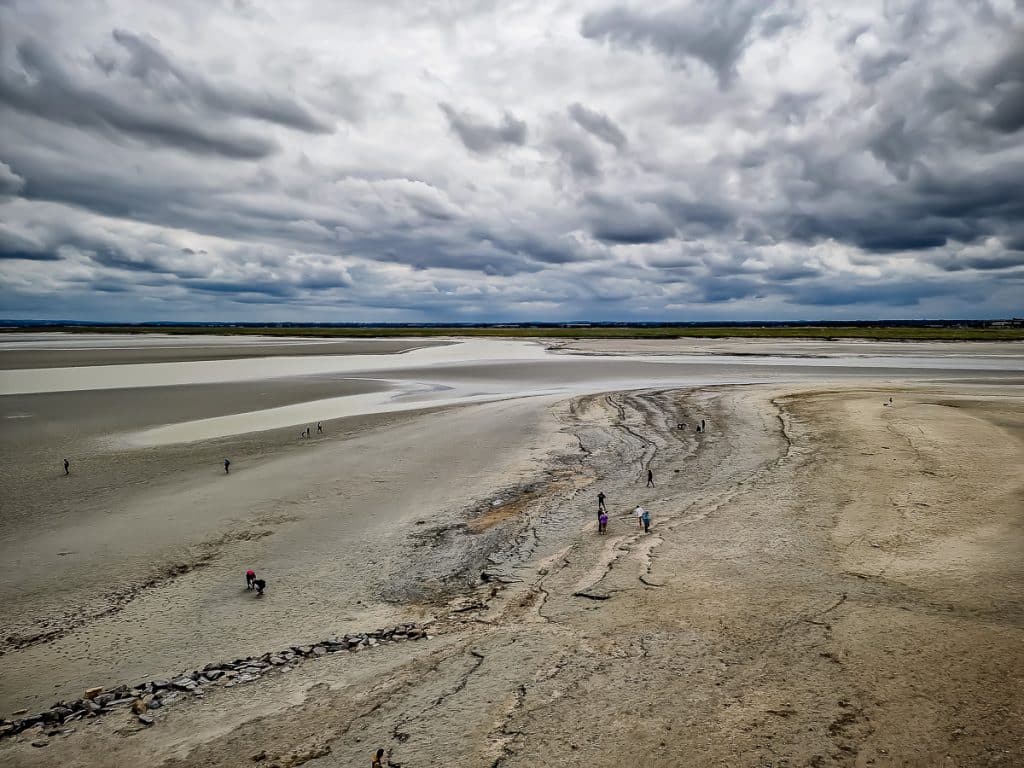
This place is fascinating, especially because the tides here are the highest on the continent, moving at incredible speed and being both strong and dangerous! The highest recorded speed is 6.1 km/h. The difference between low tide and high tide is 50 feet.
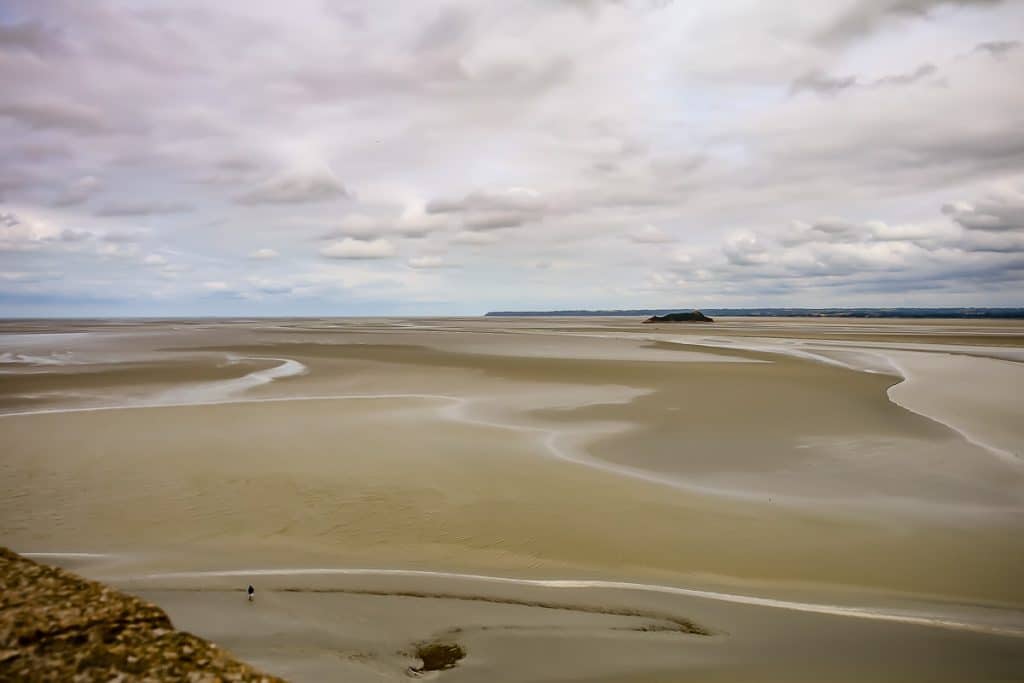
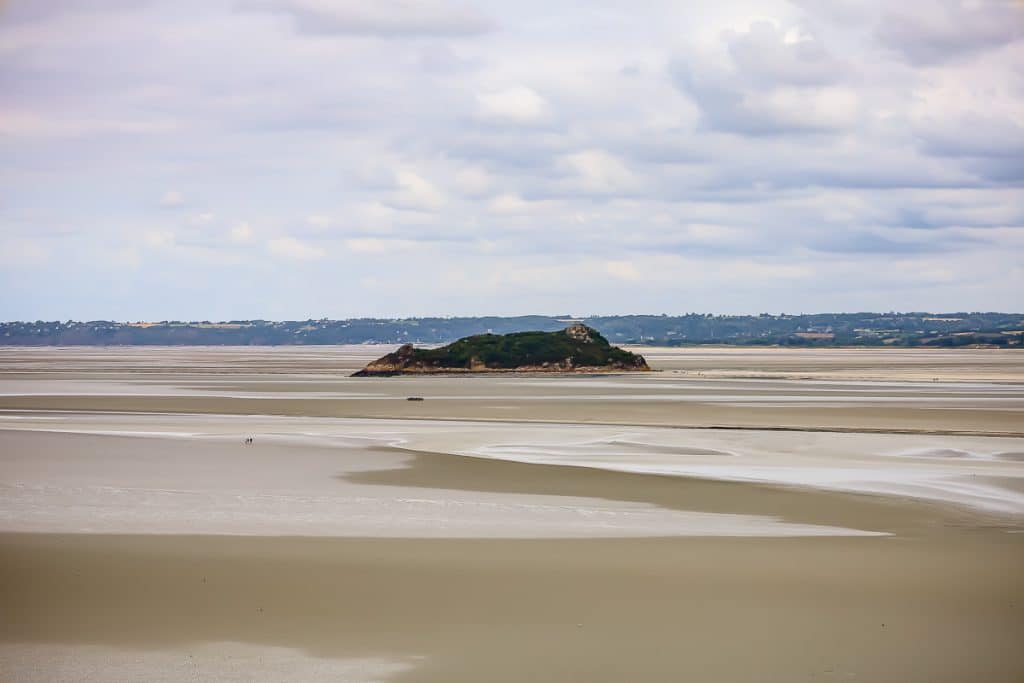
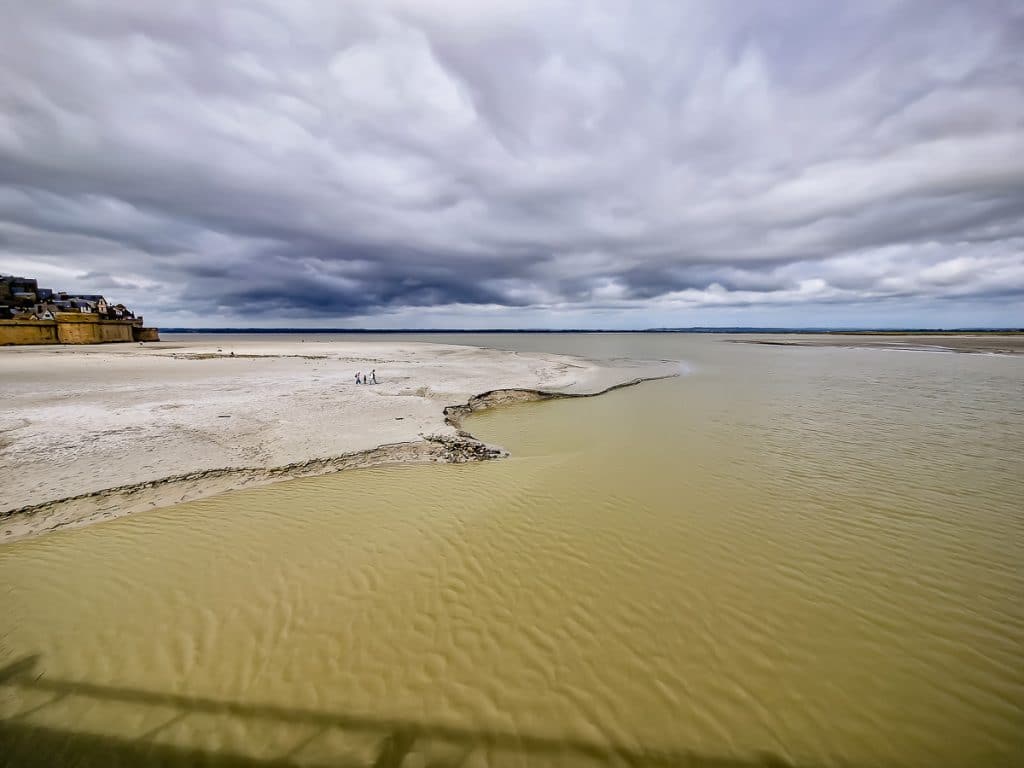
Mont Saint-Michel is practically a peninsula during low tide and an island during high tide.
I would have loved to see it surrounded by water, but that only happens a few days a year. I even received a tidal calendar for the entire year of 2024! That’s how I realized I’d need to stay here for almost 2 more months to witness Mont Saint-Michel transform from a peninsula into an island.
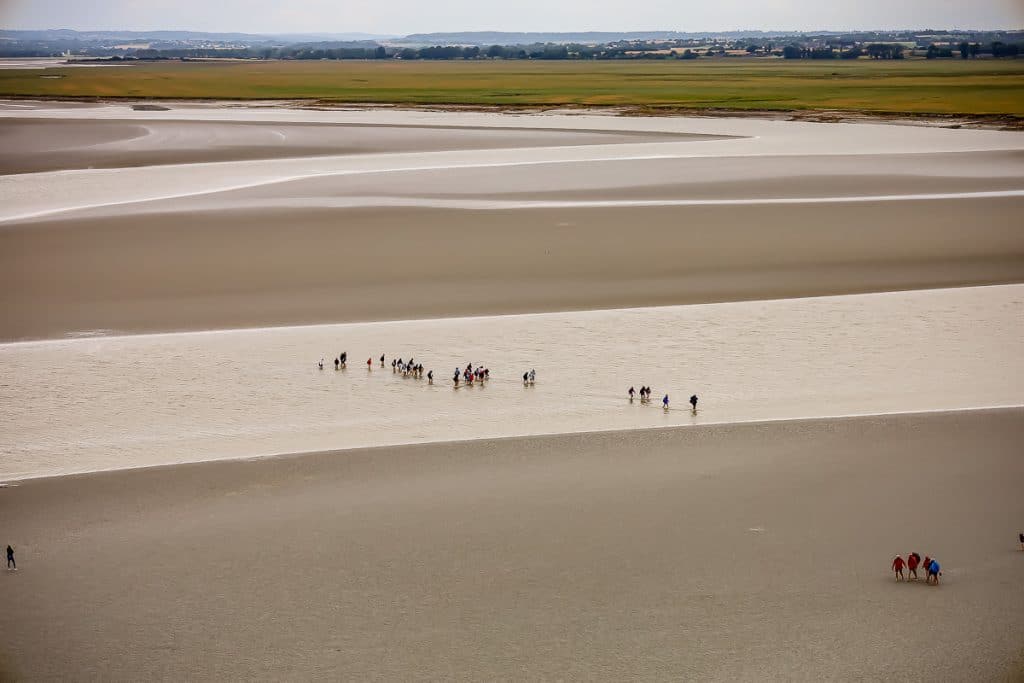
During low tide, the Mont is surrounded by 17 kilometers of sand and meadows, where flocks of sheep often graze. And we, the tourists, take advantage… (Not of the sheep, but of the sand.)
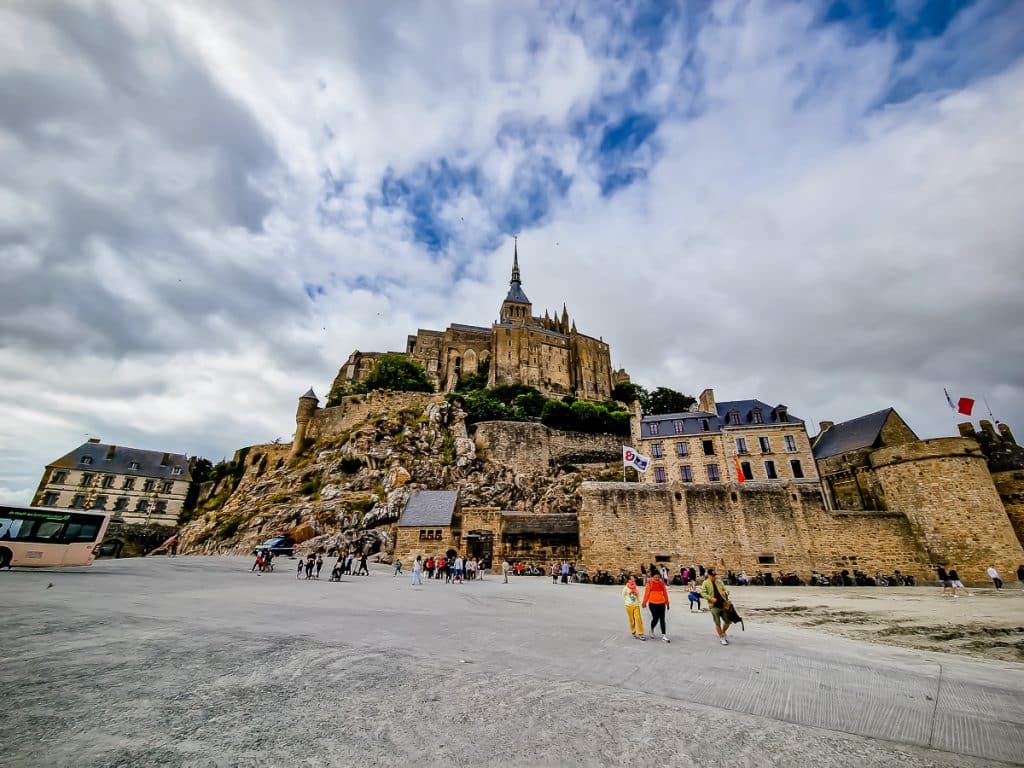
The tide was a massive natural defense for Mont Saint-Michel, making it the only fortress that wasn’t invaded by the British during the Hundred Years’ War!
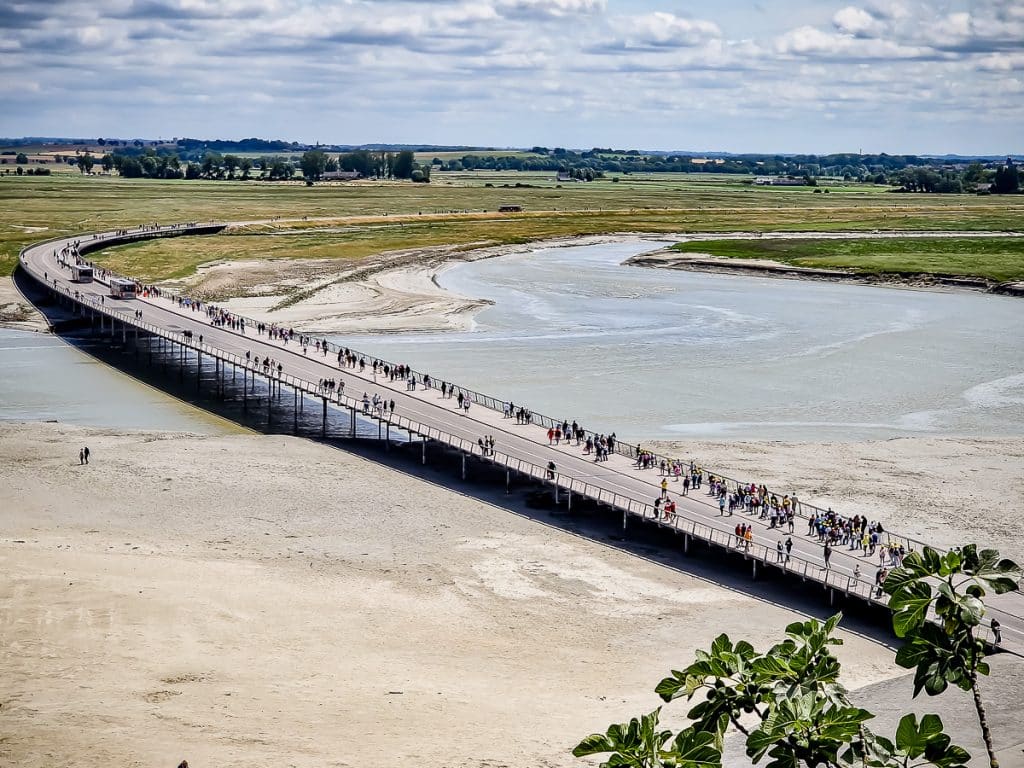
Thanks to the footbridge, the Mont is accessible almost all year round, except during periods of high tide. On these days, Mont Saint-Michel is completely surrounded by water for about 1-2 hours at the peak of high tide, making access impossible.
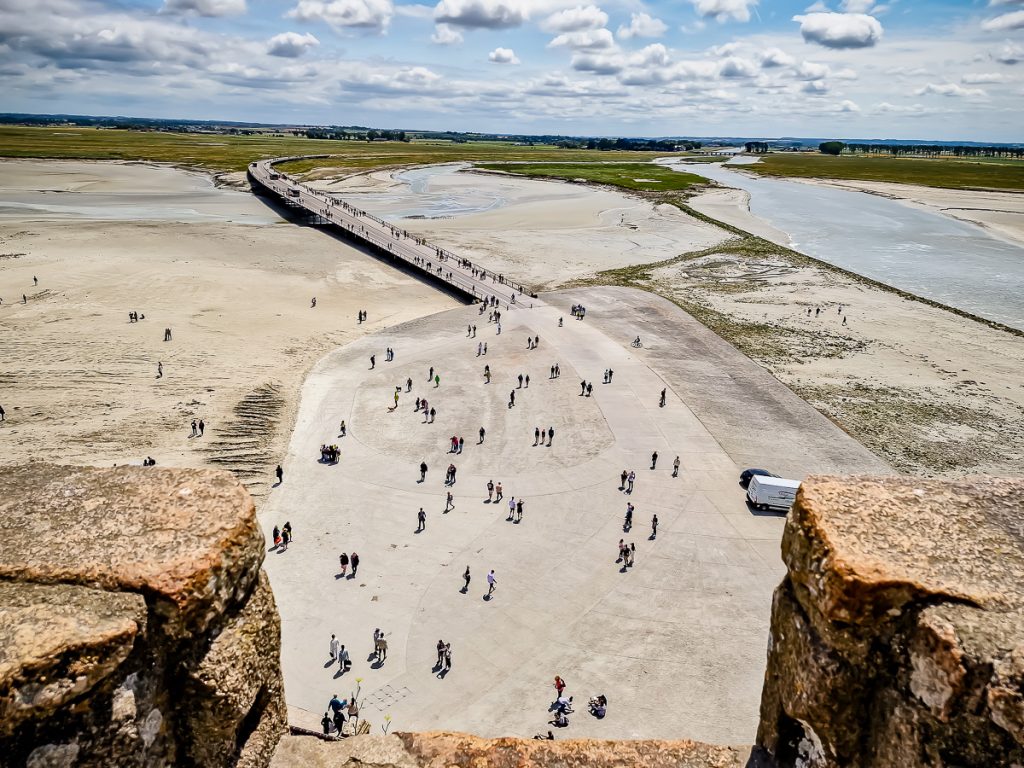
The footbridge is never covered by water; however, the concrete esplanade, approximately 100 meters long, is submerged during high tides.
This is why there is a protocol issued by the authorities for the shuttle bus: it must stop on the bridge, about 300 meters from the entrance. That’s its endpoint, and from there, it returns without turning around – because there’s no space to do so…
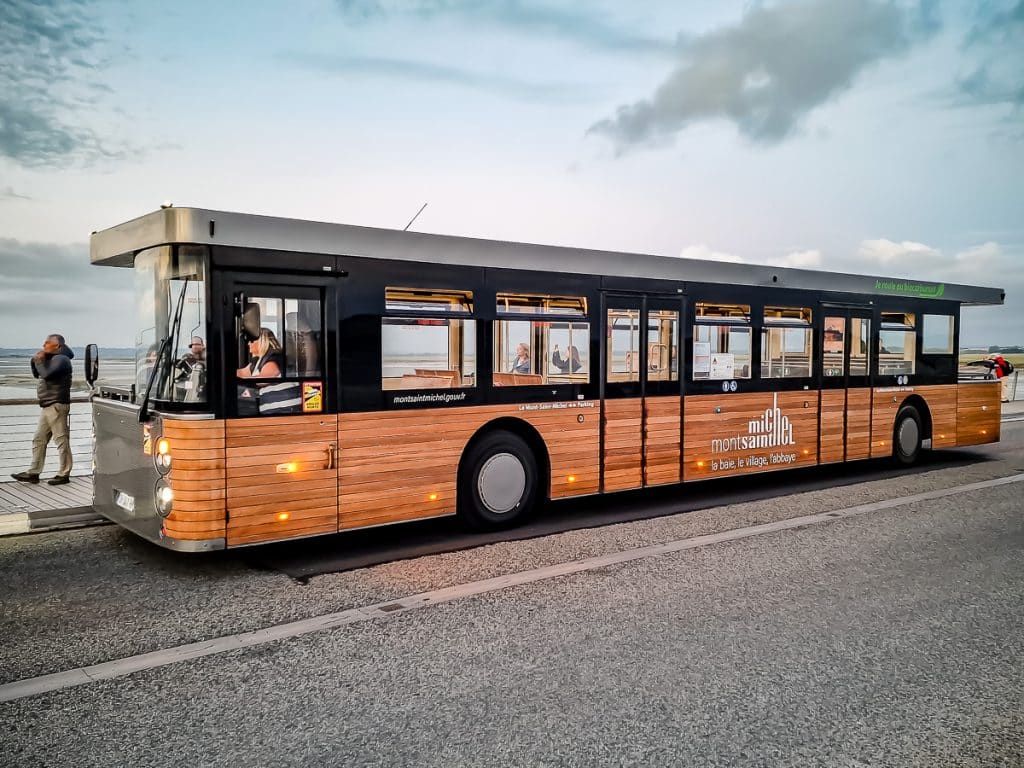
Aha, now I finally understand why it has a double driver’s cabin.
After dropping off the passengers, the driver gets out and moves to the other cabin. This way, regardless of the water level, the shuttle operates according to schedule.
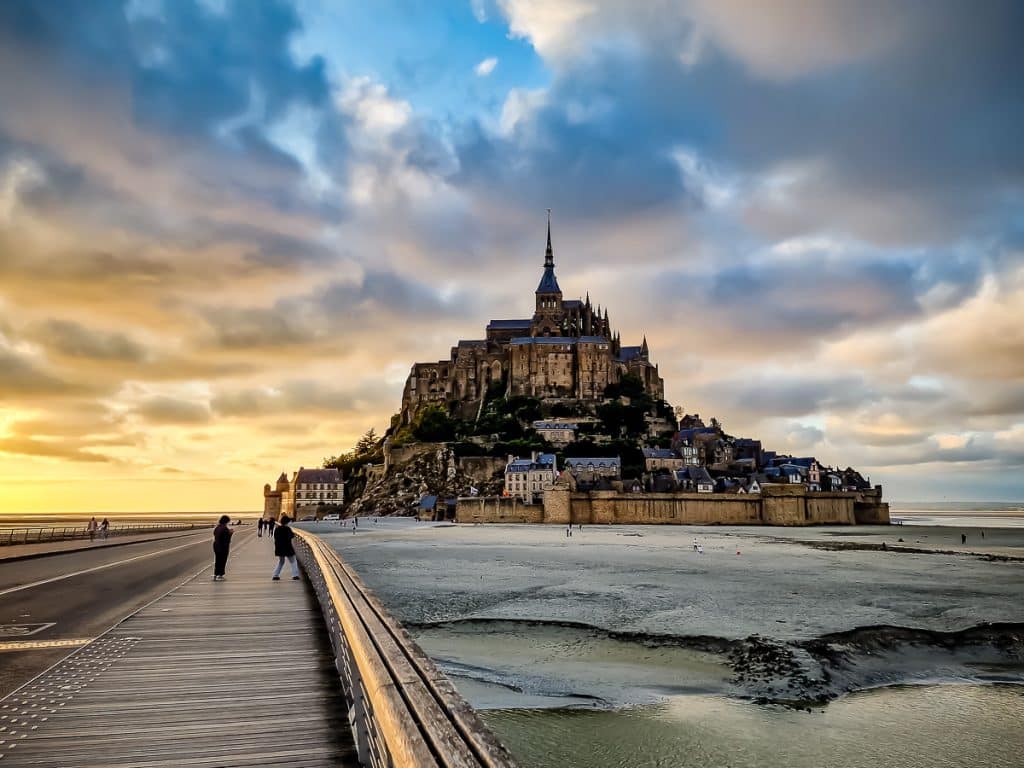
I linger on the footbridge for quite a while, taking thousands of photos and videos, as this sunset seems determined to leave us all in awe!
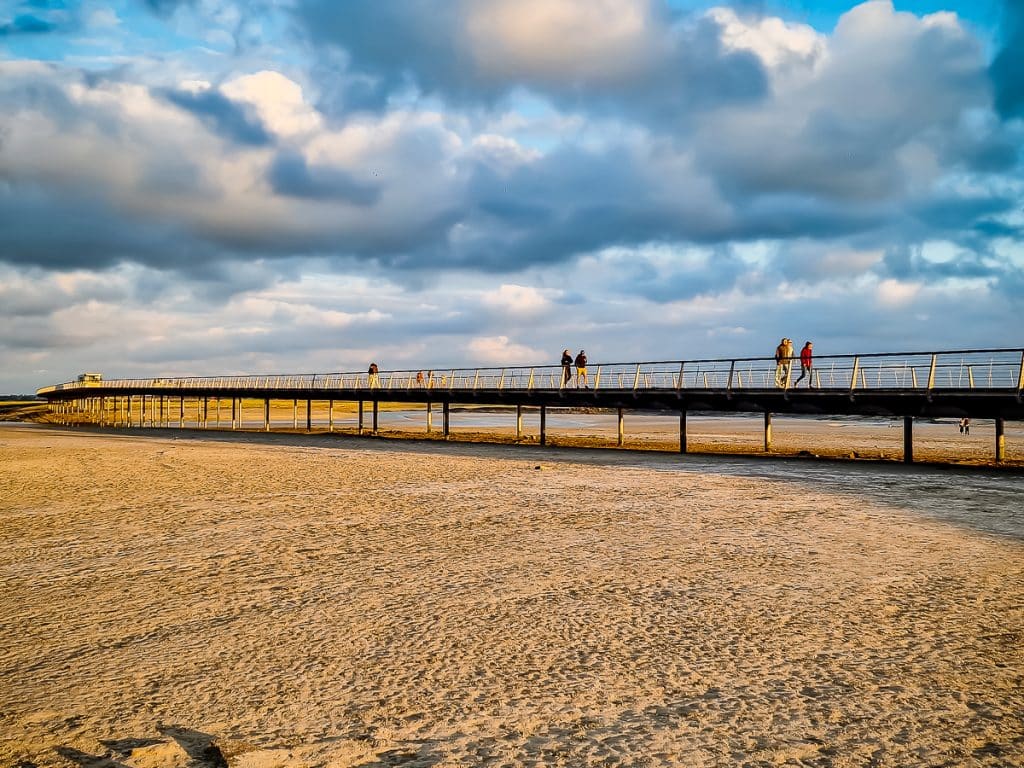
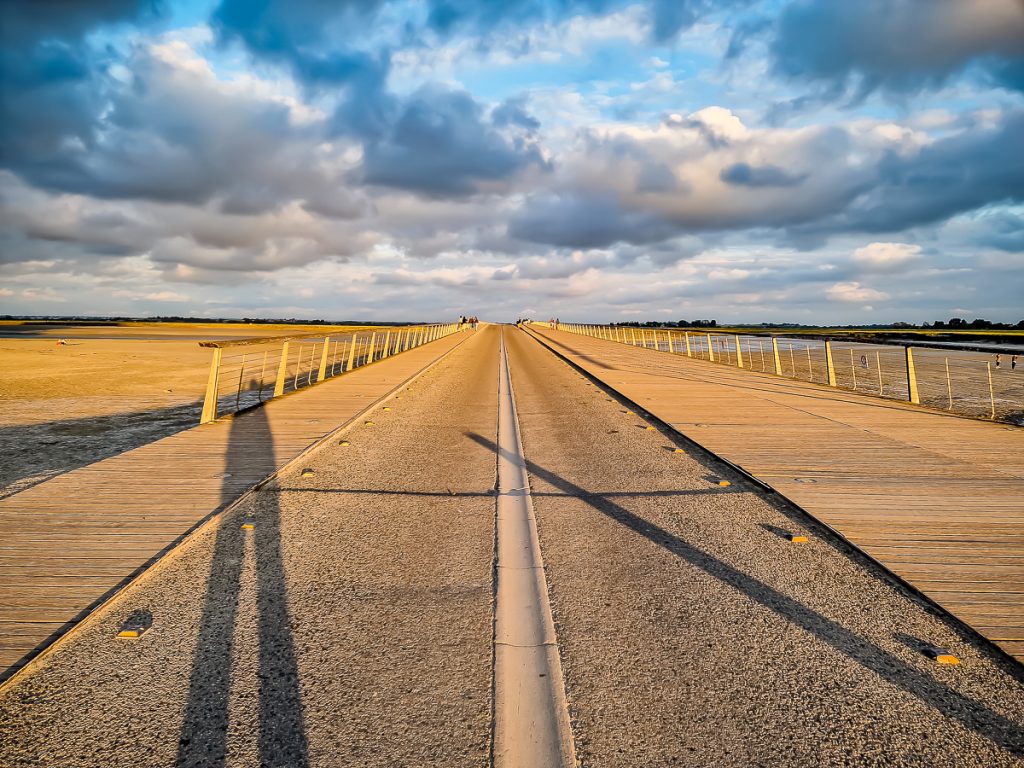
I take photos of the bridge from every angle, trying to dig into my memory, to “see” how packed with cars it was many years ago, compared to how… breathable everything is now, with pedestrian zones on both sides, where you can peacefully walk the 2 kilometers from Mont Saint-Michel to the hotels area.
Memory is one thing, but a photo from a Kodak film back then shows it clearly:
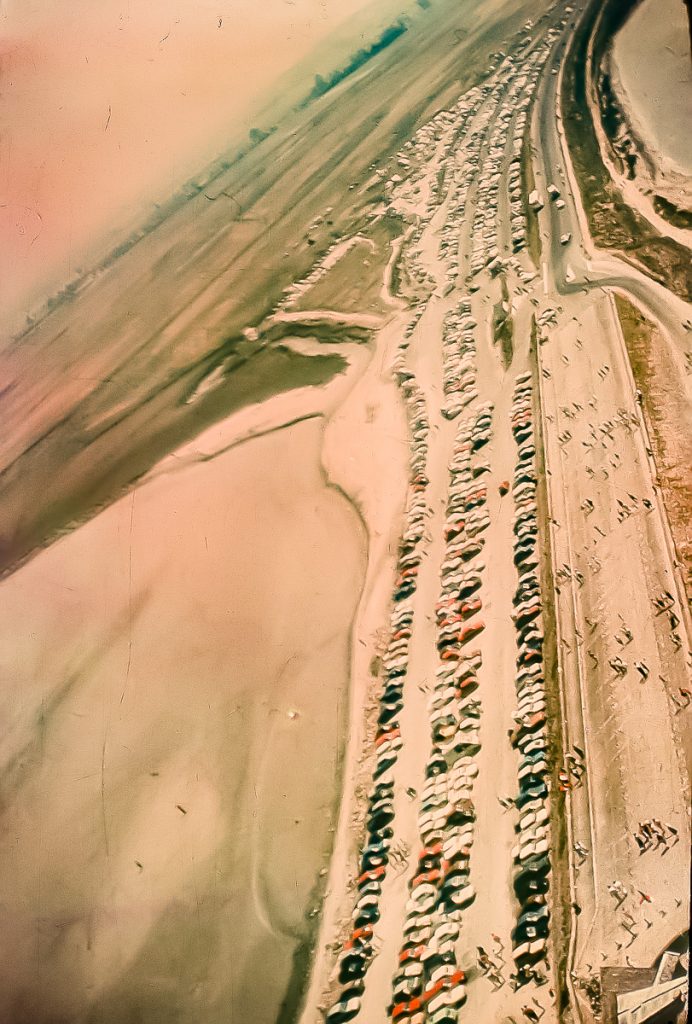
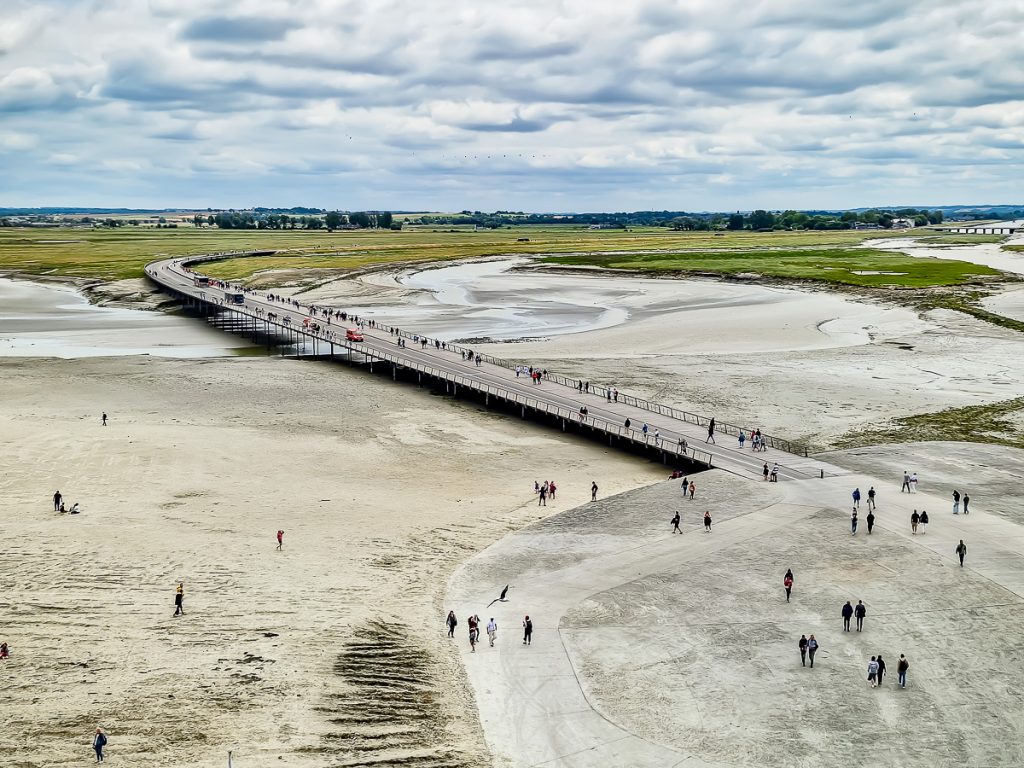
It is a shocking difference between my two visits, right?…
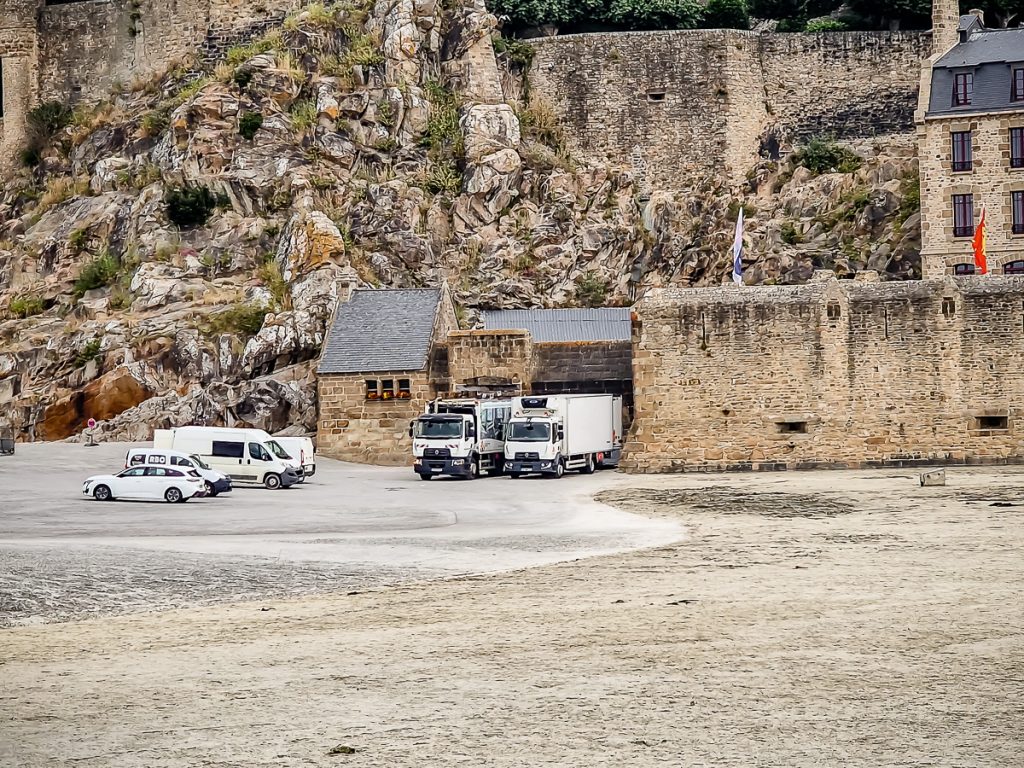
As I get closer, I spot a few cars right at the gate. Wait, how’s that possible?? I thought it was forbidden!
I find out that these are vehicles with special permits to get here: delivery trucks, garbage collection vehicles, utility vehicles.
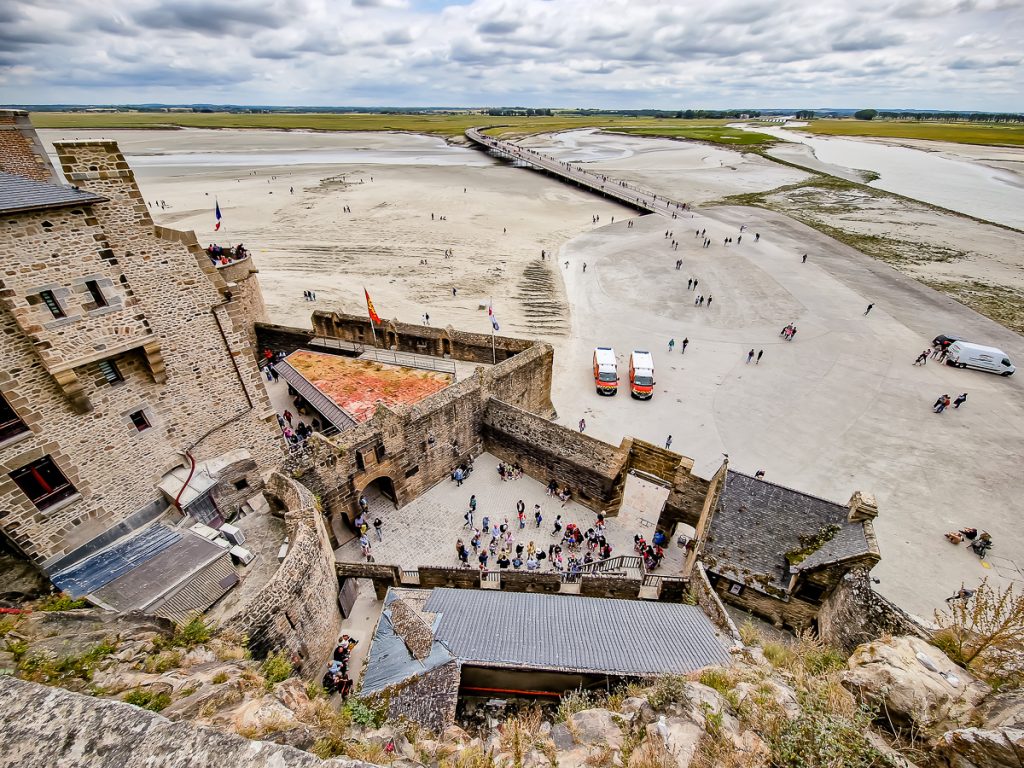
Firefighters and ambulances are also allowed to come right up to the gate.
Here comes a “public bus”, line 2. It shuttles between Mont Saint-Michel and the nearest train station, in the small town of Pontorson, about 10 km away (where, by the way, you can also find accommodation options).
Bus 3 catches up to me. Wait, how many do you have??
It’s also allowed to pull up to the entrance. It’s exclusively for employees and residents. Residents??
IS MONT SAINT-MICHEL INHABITED?
Yes, Mont Saint-Michel is inhabited!
But before I tell you how many residents live here, I’d like to share what I’ve learned about this fascinating place – through reading, asking questions, listening to guides, seeing it “live”, and reading some more.
Hold on a sec! I’m quickly running to a corner inside the fortress, where people has gathered to watch the sun set into the sea. It’s just past 10 PM.
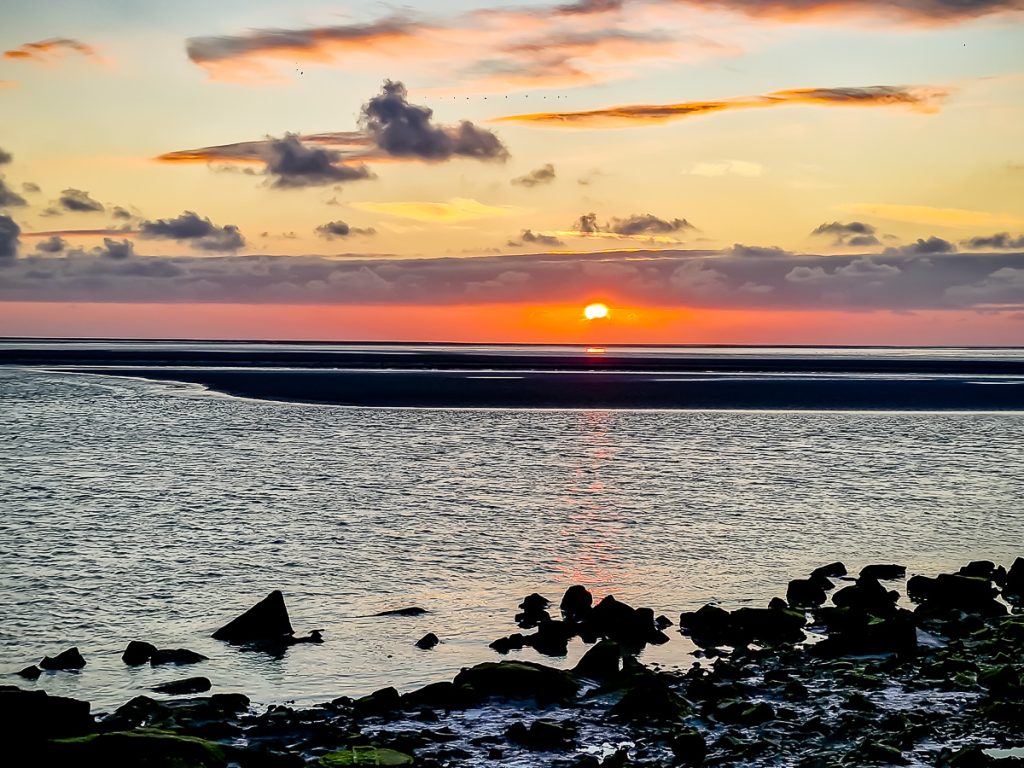
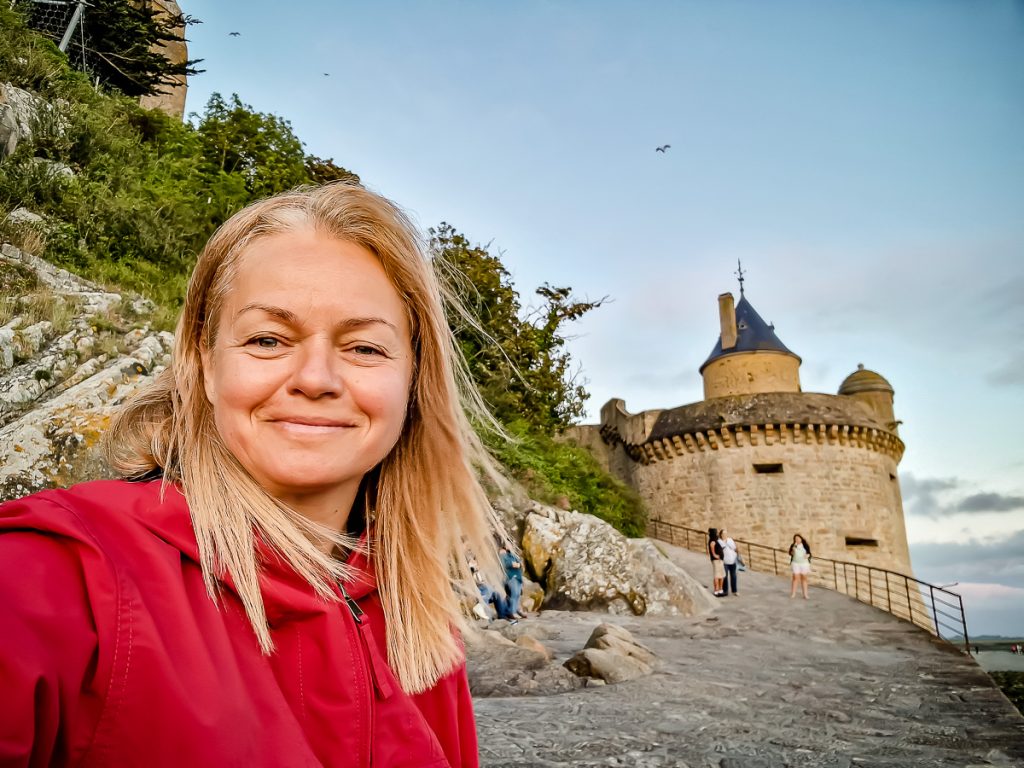
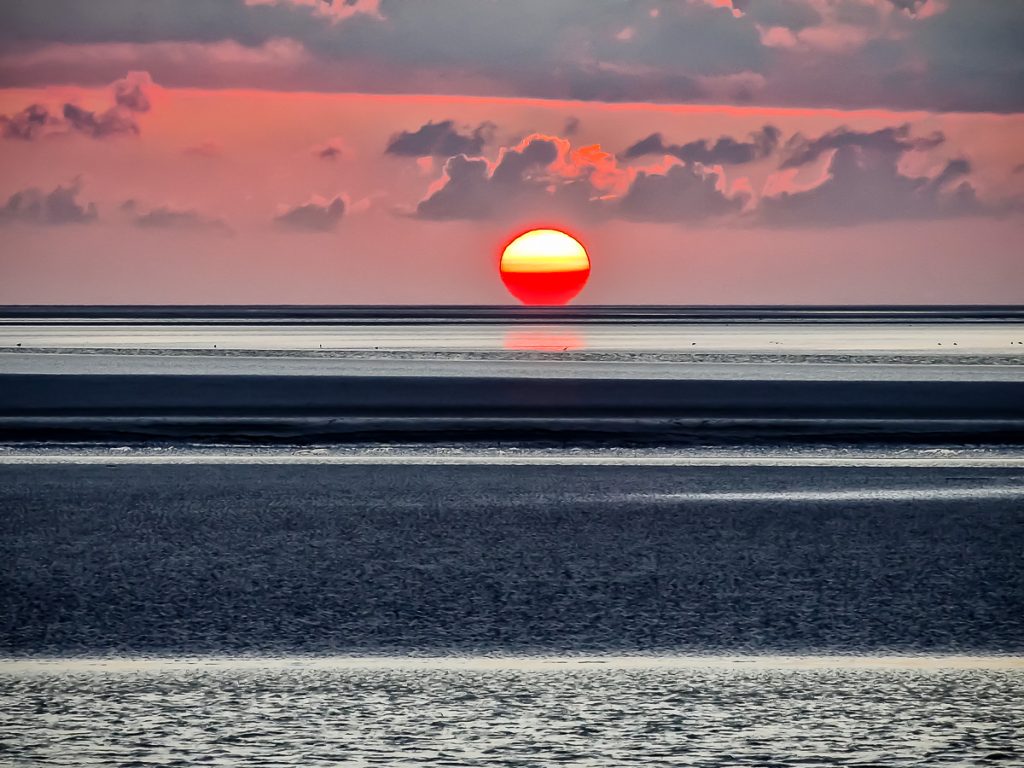
ABOUT MONT SAINT-MICHEL
Did you know it’s the second most visited tourist destination in France, after the Eiffel Tower?! I just found that out too…
Included in the UNESCO World Heritage list in 1979, Mont Saint-Michel is located between Normandy and Brittany. Apparently, there’s even a bit of a dispute between the two regions, like “It’s mine,” “No, it’s mine!”…
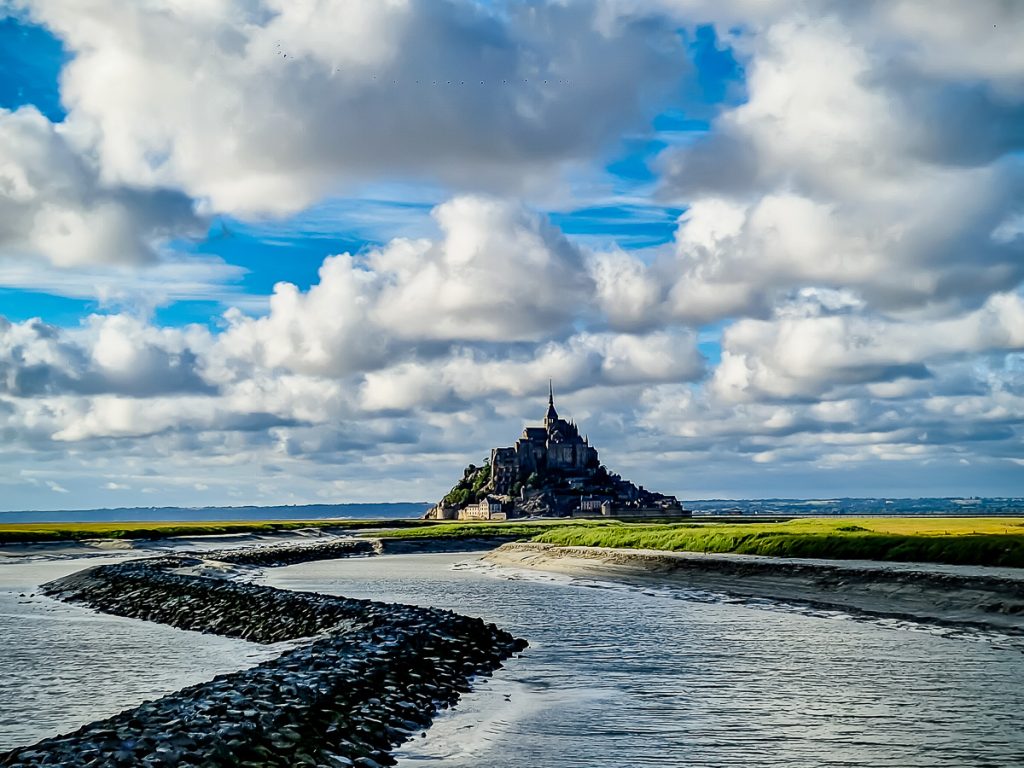
However, it is officially considered part of Normandy, thanks to the Couesnon River, which forms the boundary between Normandy and Brittany. Mont Saint-Michel is on its Norman bank. And that’s how things got sorted out 🙂
Legend has it that in the year 708, Archangel Michael appeared in a dream to Aubert, the Bishop of Avranches, asking him to build a place of worship in his honor on the isolated rock nearby. The man didn’t act on it – he carried on with his life, thinking it was just a dream.
But guess what? Michael appeared to him again in a dream. And when the second time didn’t convince him, Michael appeared a third time, poking him on the head to make it clear he was serious.
That’s how the bishop was finally convinced to start work on the place of worship.
What’s fascinating is that in a church in Avranches, the little town “across the way”, there’s the bishop’s skull, which has… a hole in it. It’s said to be exactly where Archangel Michael touched him with his finger to get his attention.
Over time, the place became significant for pilgrims, scholars, dukes, and kings, and it kept developing.
By 1879, as hordes of tourists were already visiting, a causeway was built to make access easier.
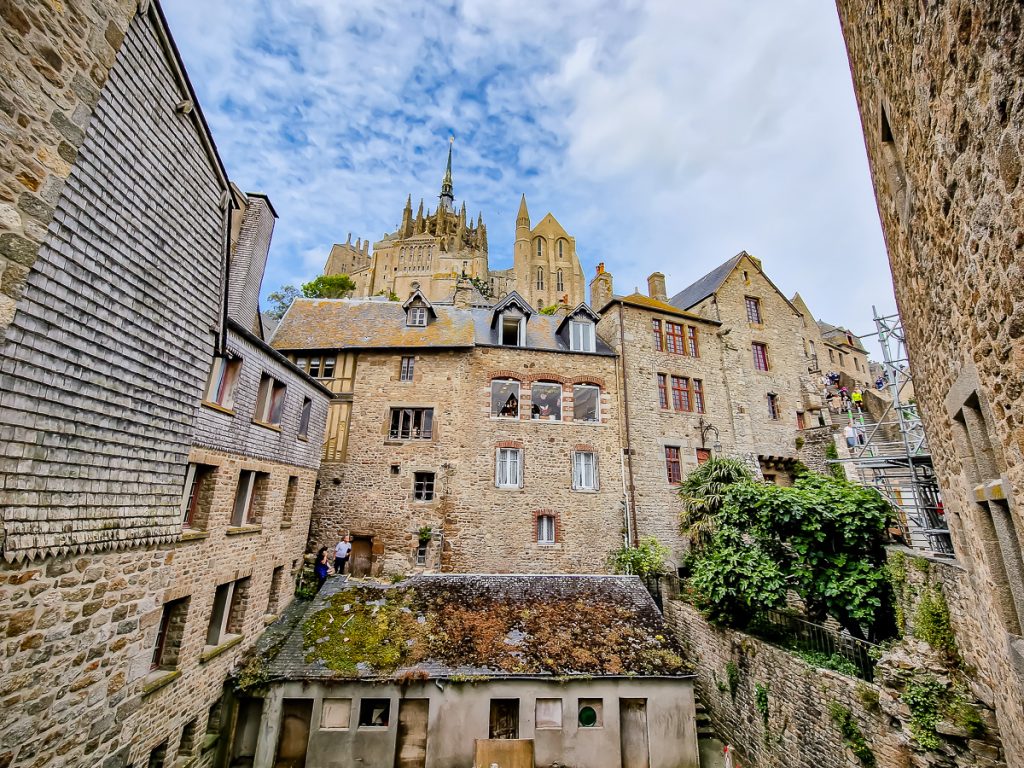
To reach the abbey, which stands 80 meters high atop Mont Saint-Michel, you’d pass and still pass through the village, along narrow streets lined with 15th- and 16th-century houses, many of which have been turned into inns, boutiques, souvenir shops, and restaurants.
MONT SAINT-MICHEL. INSIDE THE WALLS.
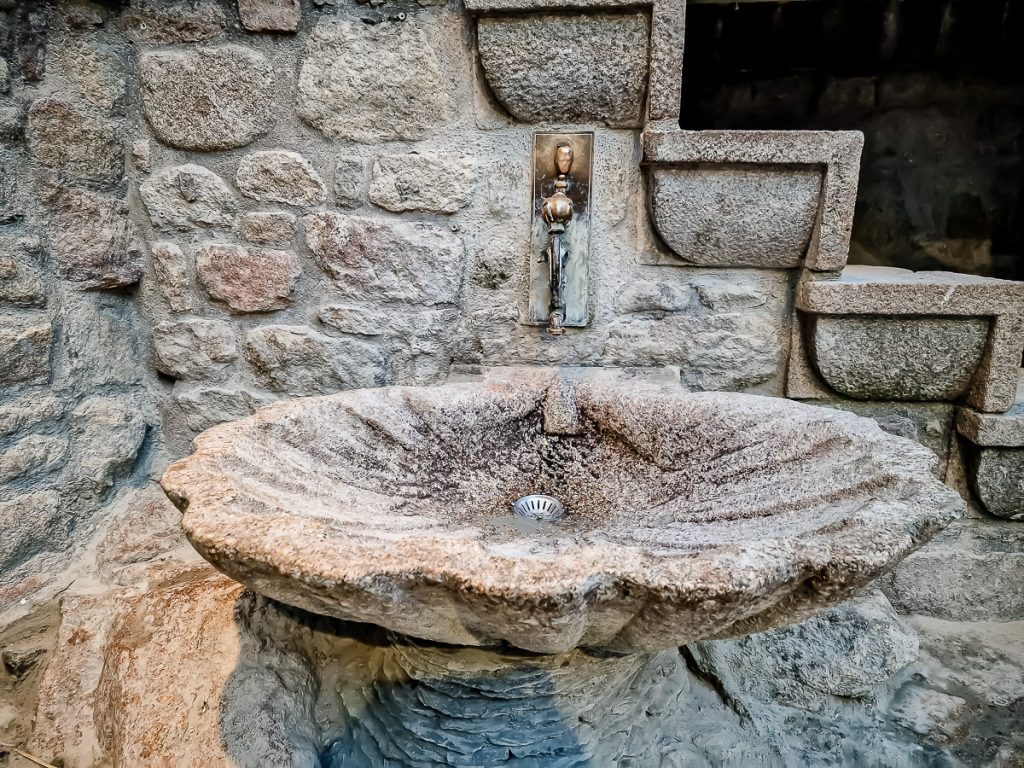
First things first, fill up your water bottle right at the fountain by the entrance. That way, you won’t have to spend money on water after sweating your way up and down the narrow streets of the citadel…
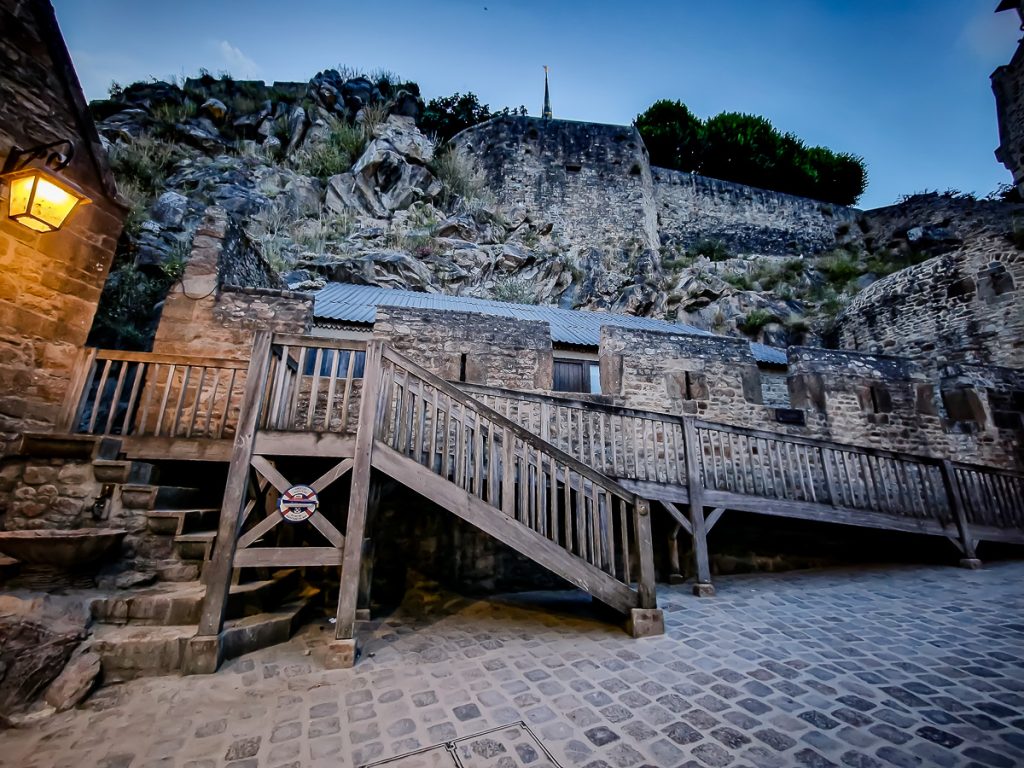
There are also toilets here, at the entrance, built up high to stay out of the way of the tides. So, if you’ve got a small bladder, empty it here 🙂
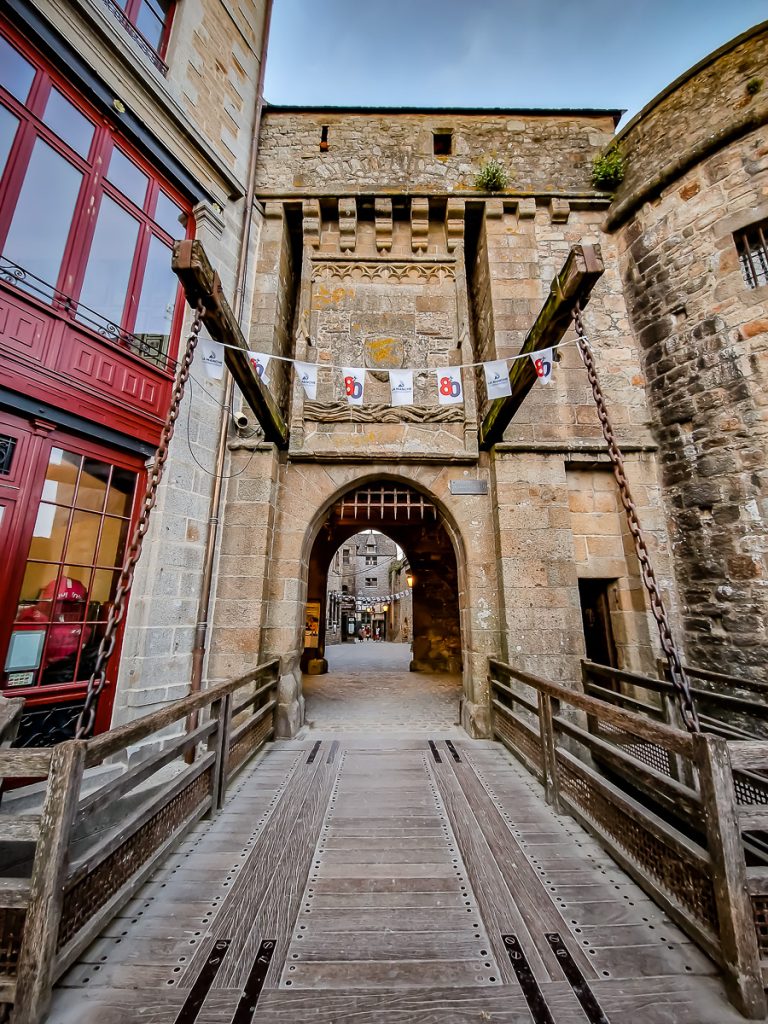
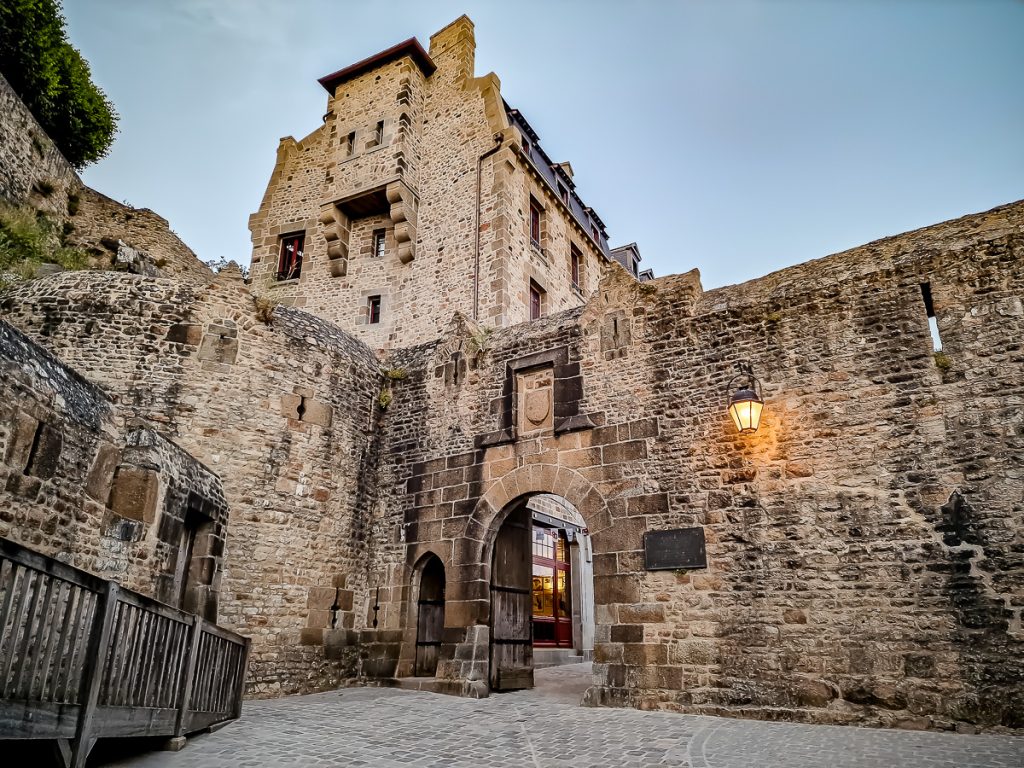
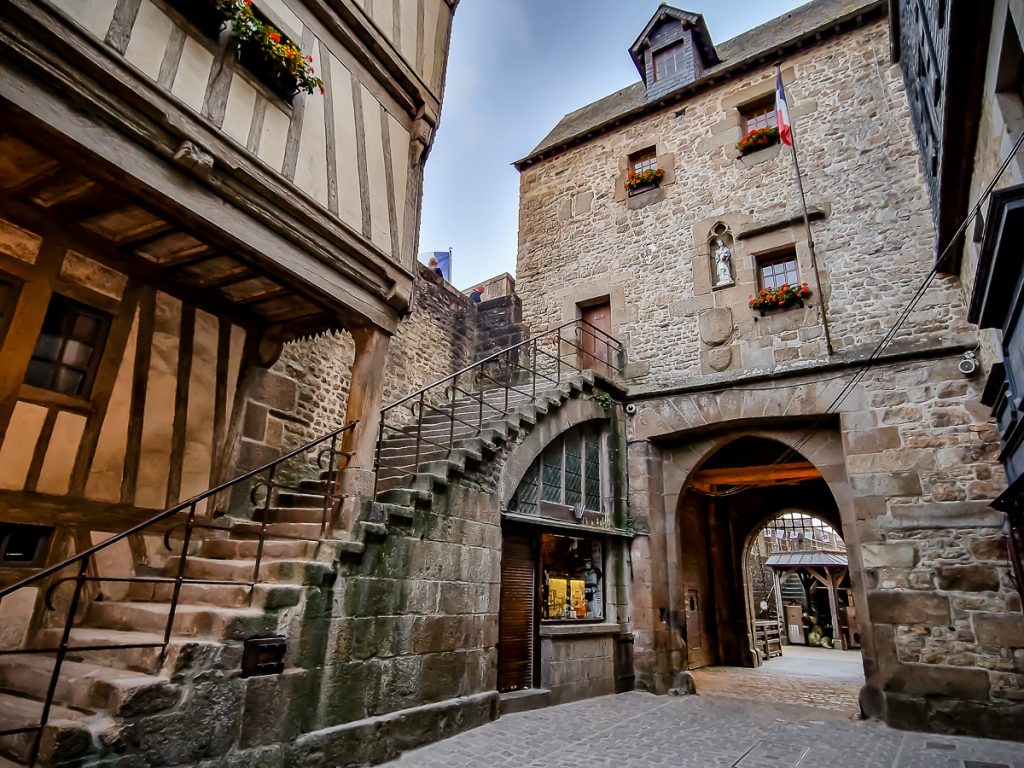
You’ll pass through three successive gates – Avancée Gate, Boulevard Gate, and King’s Gate – before reaching the village’s main street, called La Grande Rue.
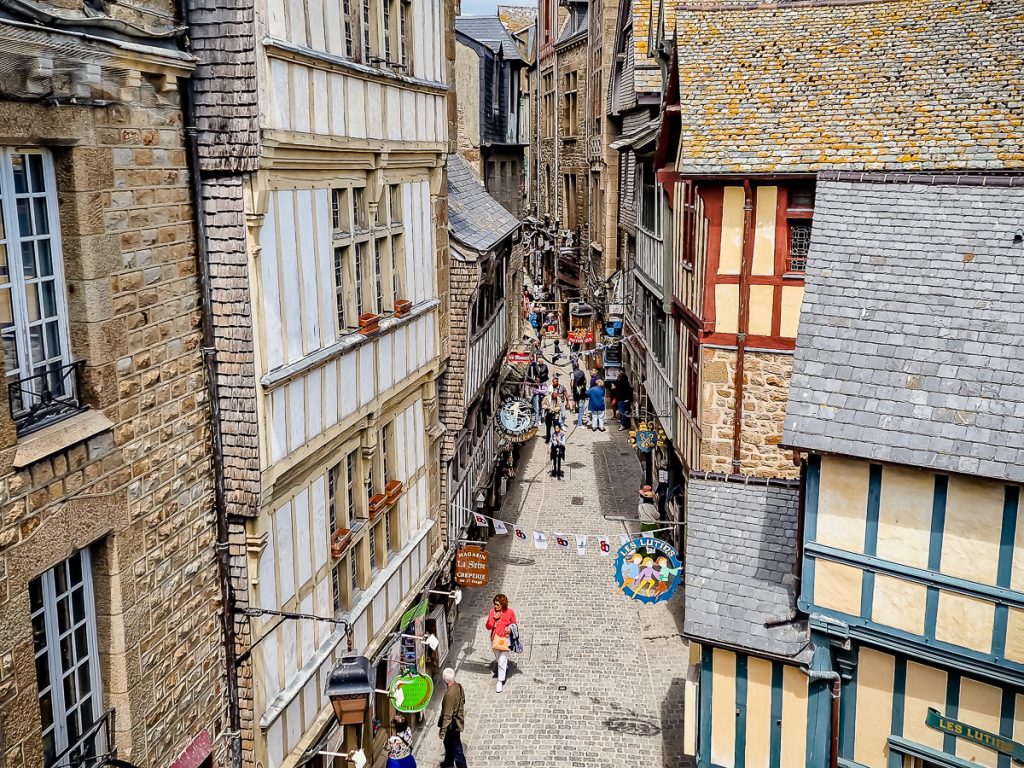
Do you know how many people live in Mont Saint-Michel?
As of the last census in 2021, the commune of Mont Saint-Michel had no more and no less than 25 residents! But wait! The commune includes not only the interior of the walls but also the area outside the walls, along the coast.
Practically, within the walls, only 7 nuns and 3 monks live – members of the Monastic Fraternities of Jerusalem – along with 6 lay residents. Just six.
I understand that, in total, there are 100 registered voters, probably counting those who have left for work elsewhere.
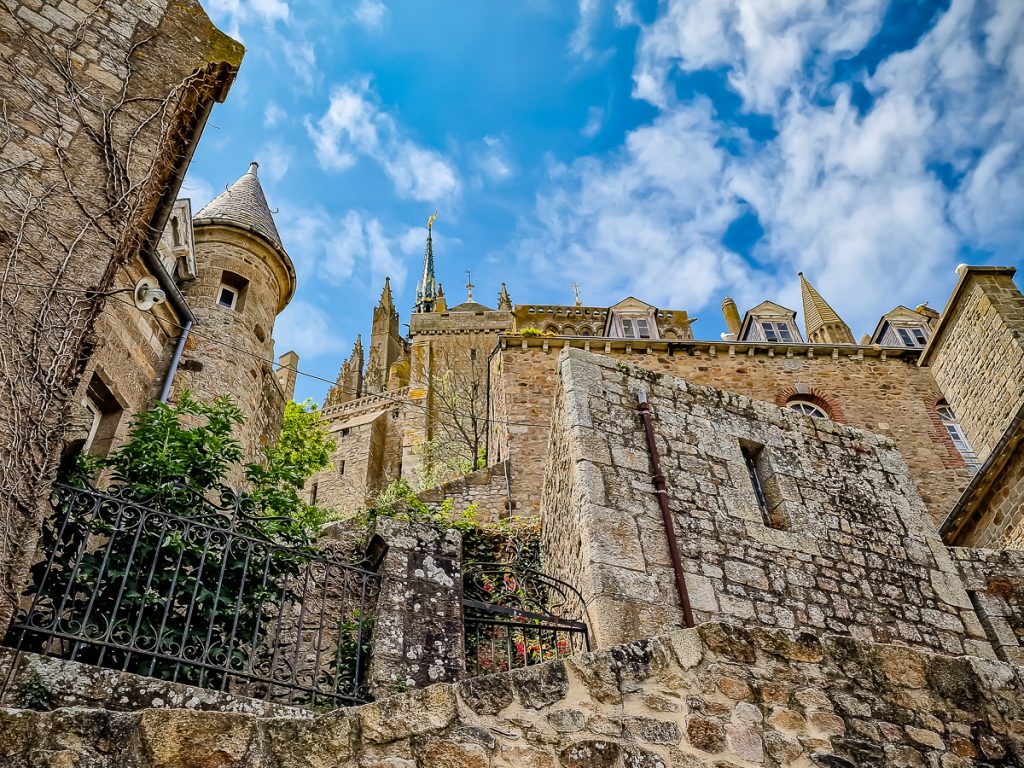
In Mont Saint-Michel, there are more employees than residents, more businesses than homes…
There used to be a primary school here, but it was closed in 1972.
Now, it’s a tourist town where it seems almost unimaginable that anyone could live here permanently.
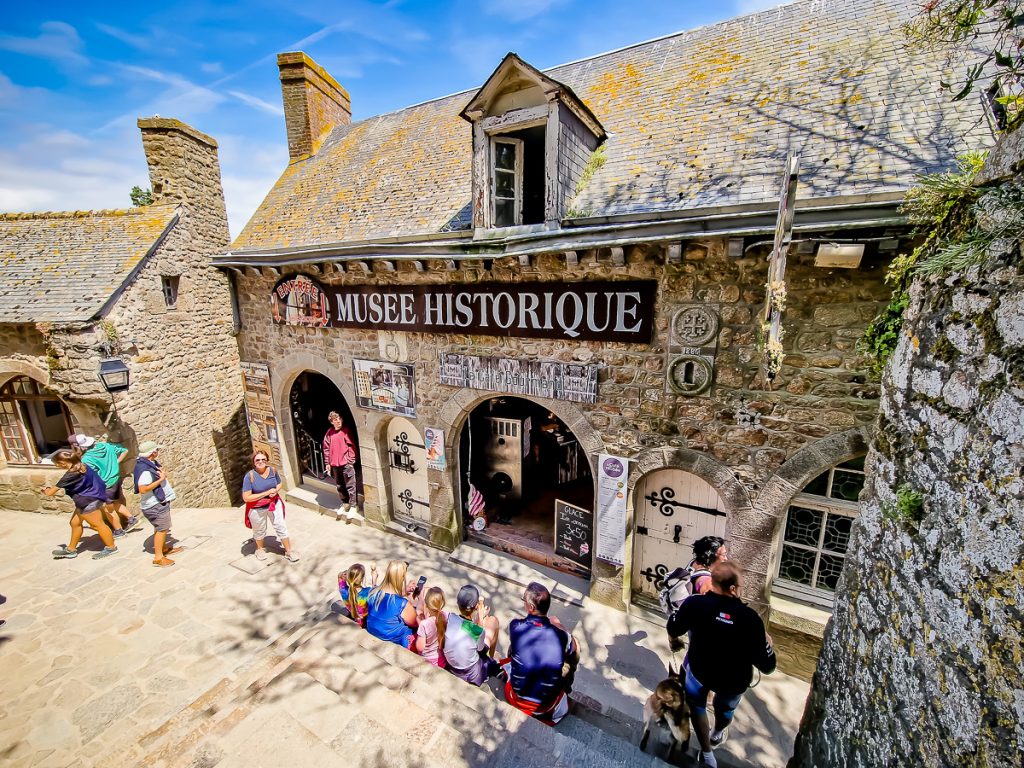
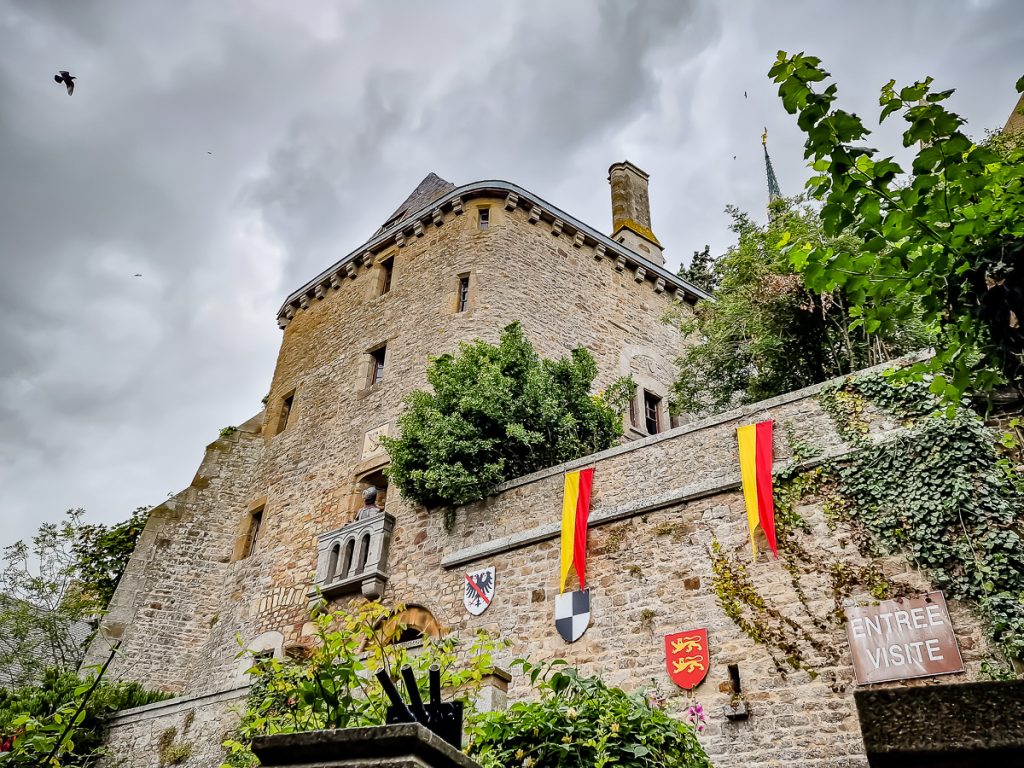
Everywhere you look, there’s a small shop, a restaurant, a guesthouse, a gelato place, a museum… (Apparently, there are 4 museums here. You can see collections of weapons, paintings, a periscope, learn about tides, or visit a knight’s house.)
Many of the houses hide small enclosed gardens, where people grow various plants, just as they did in the past, a good survival resource during sieges…
The northern side of Mont Saint-Michel, steeper, has remained in its natural, wild state.
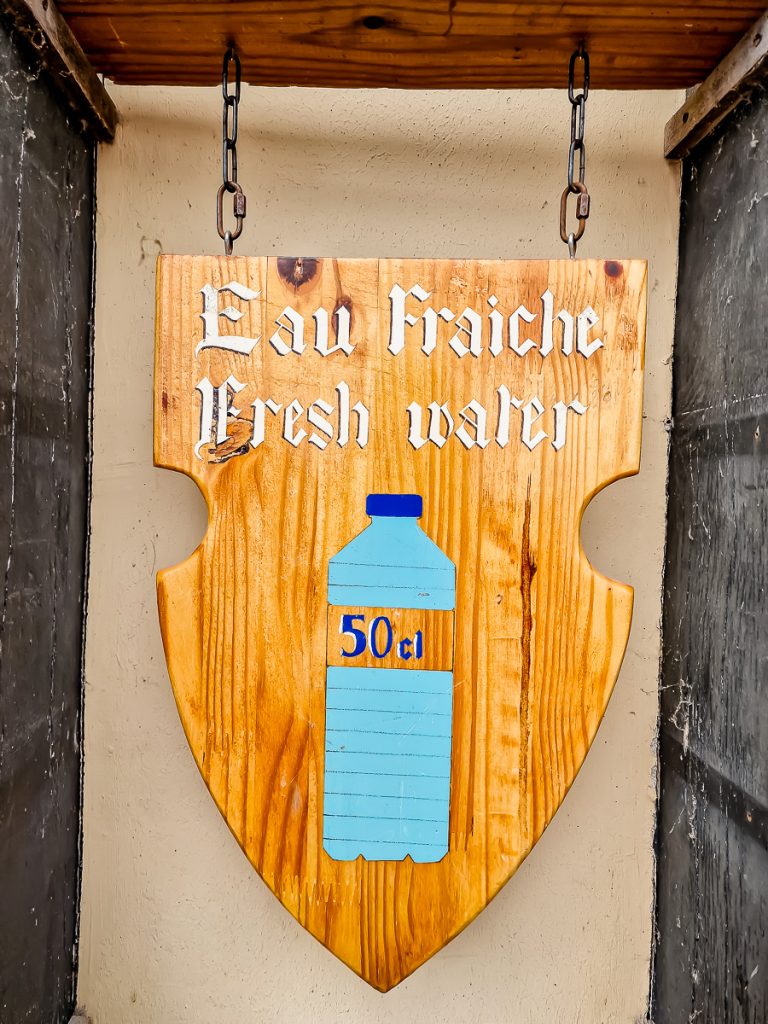
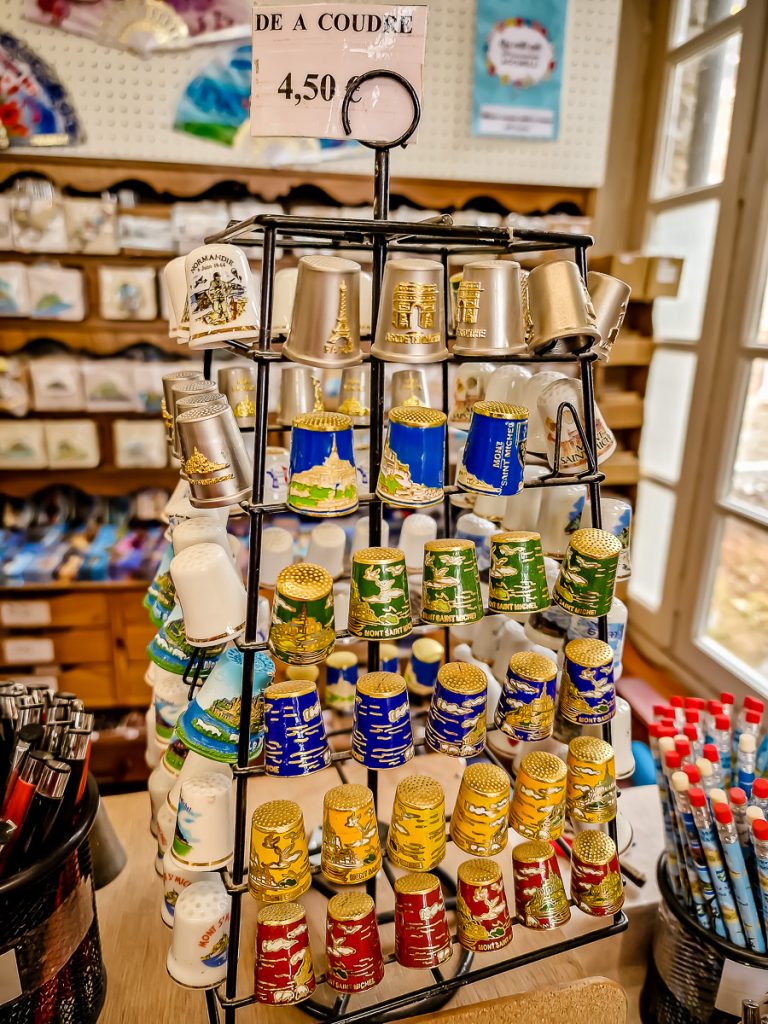
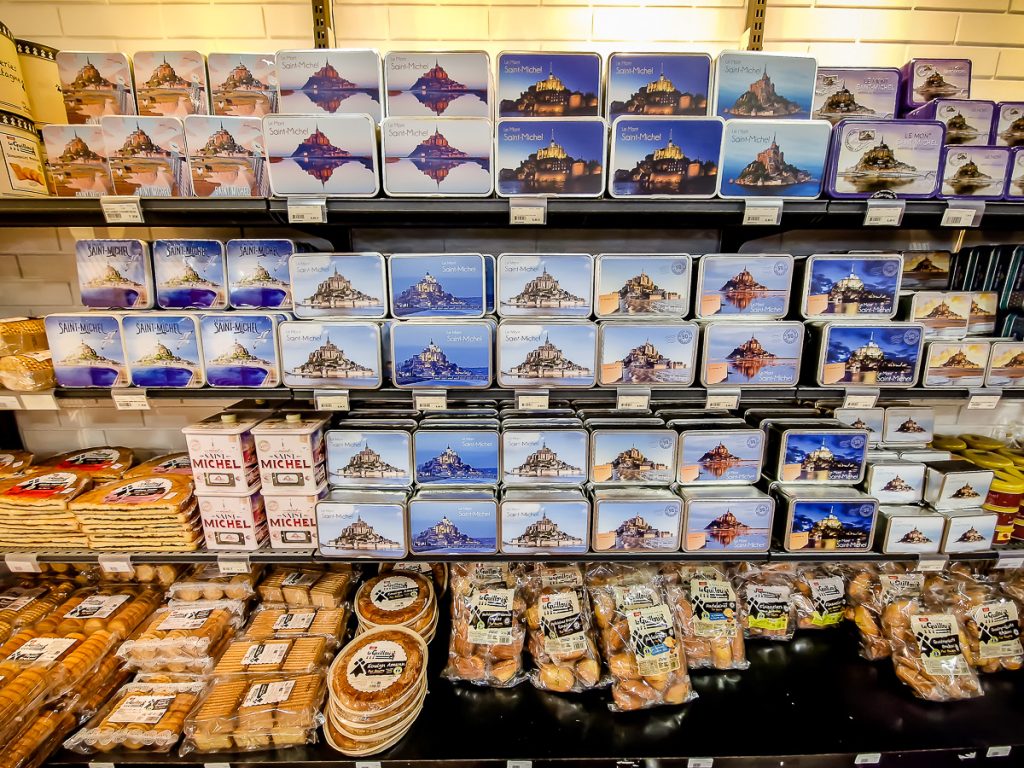
I understand there are about 50 shops, restaurants, and hotels/guesthouses in Mont Saint-Michel. Plenty of places to shop, eat, and take a nap…
It’s a fortress with gates open 24/7, which I didn’t expect. In my mind, the gates would close at night.
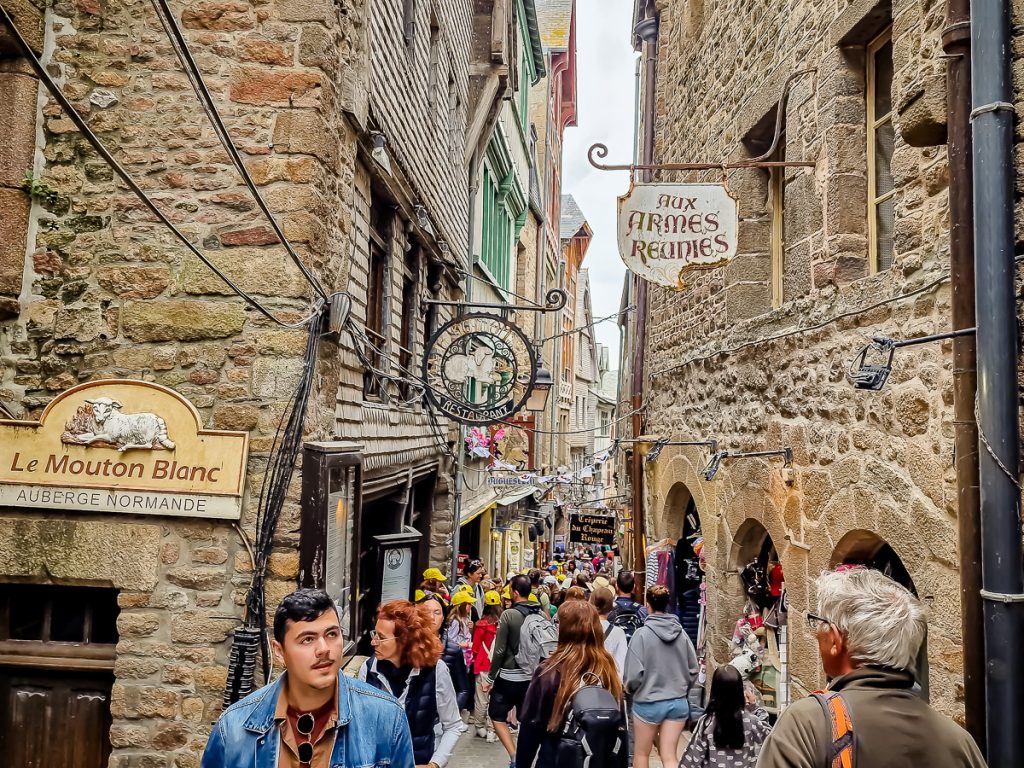
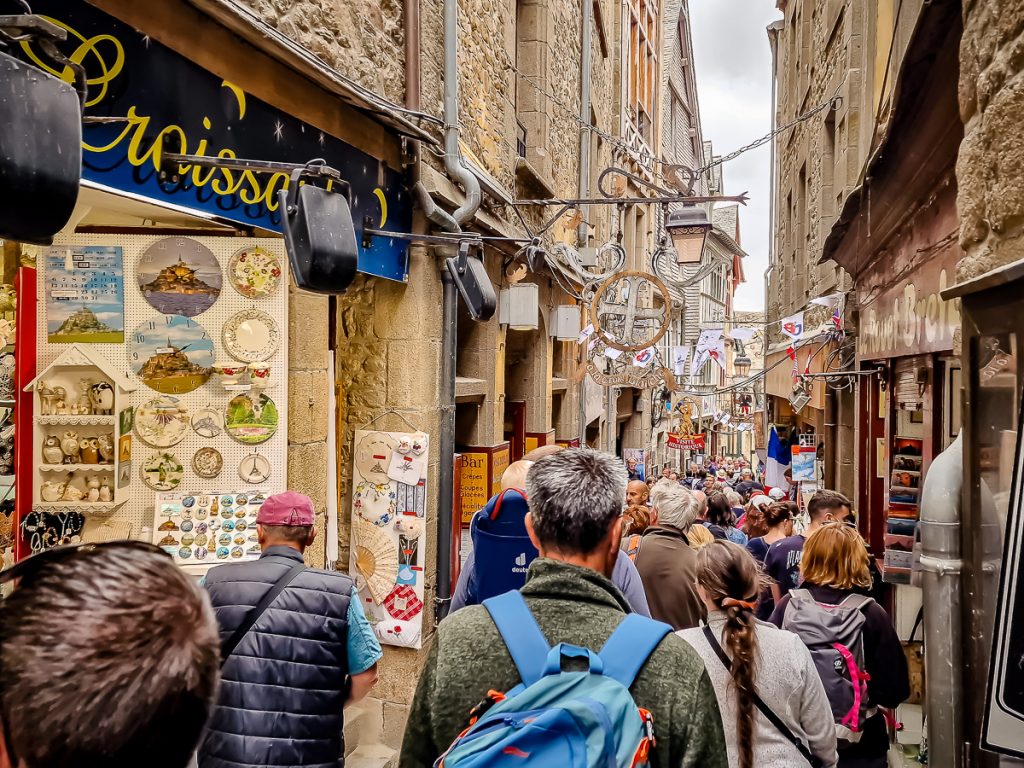
During the day, it’s bustling! Especially on the main “alley”, too narrow for the flood of tourists.
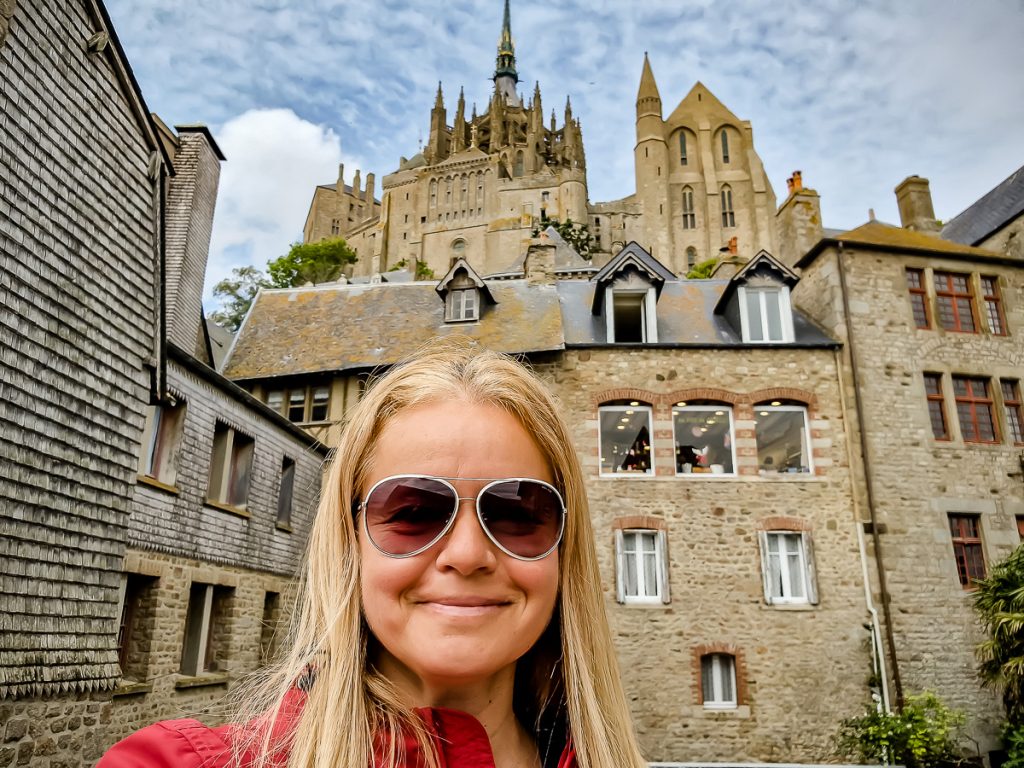
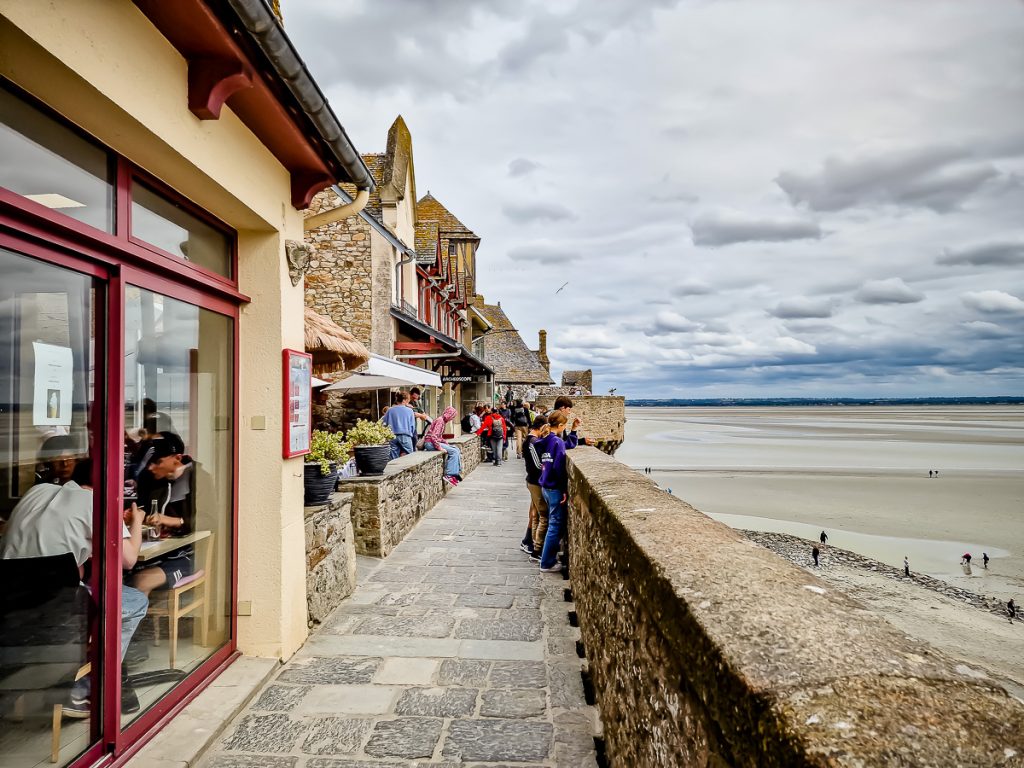
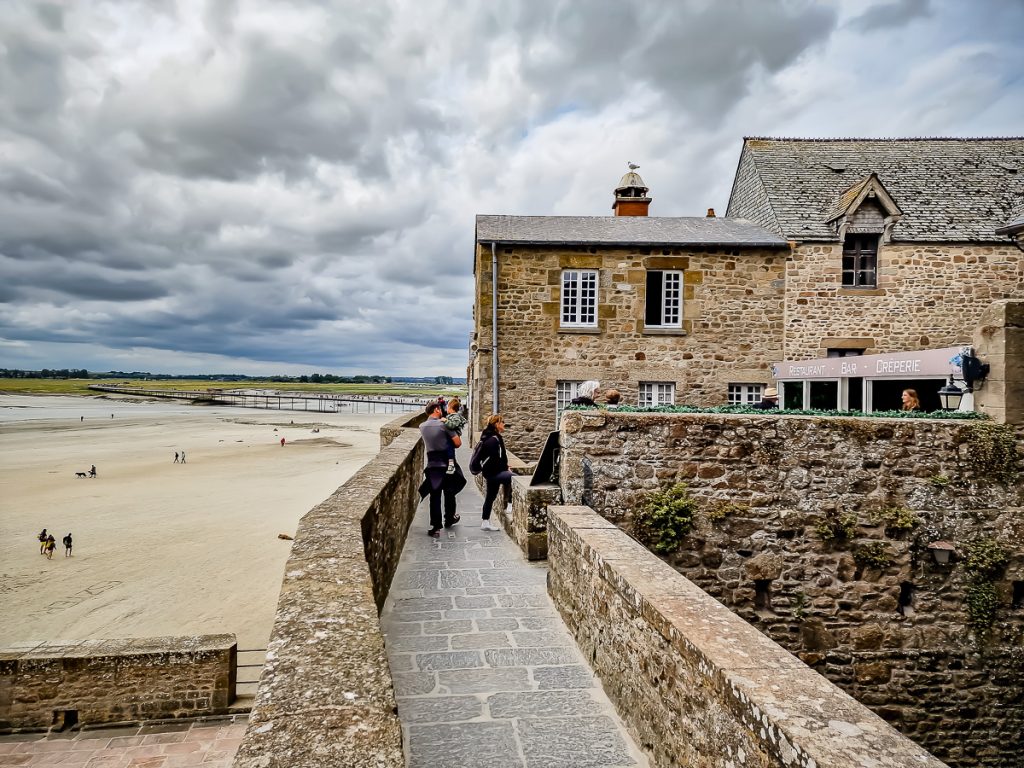
What’s cool is that you can escape the chaos of the main street by walking along the defensive walls, where you get beautiful views of the bay and all of Mont, with its stone houses.
(The defensive wall system, with its seven towers, was built during the Hundred Years’ War, turning Mont Saint-Michel into an impregnable fortress, with the tides also playing a role.)
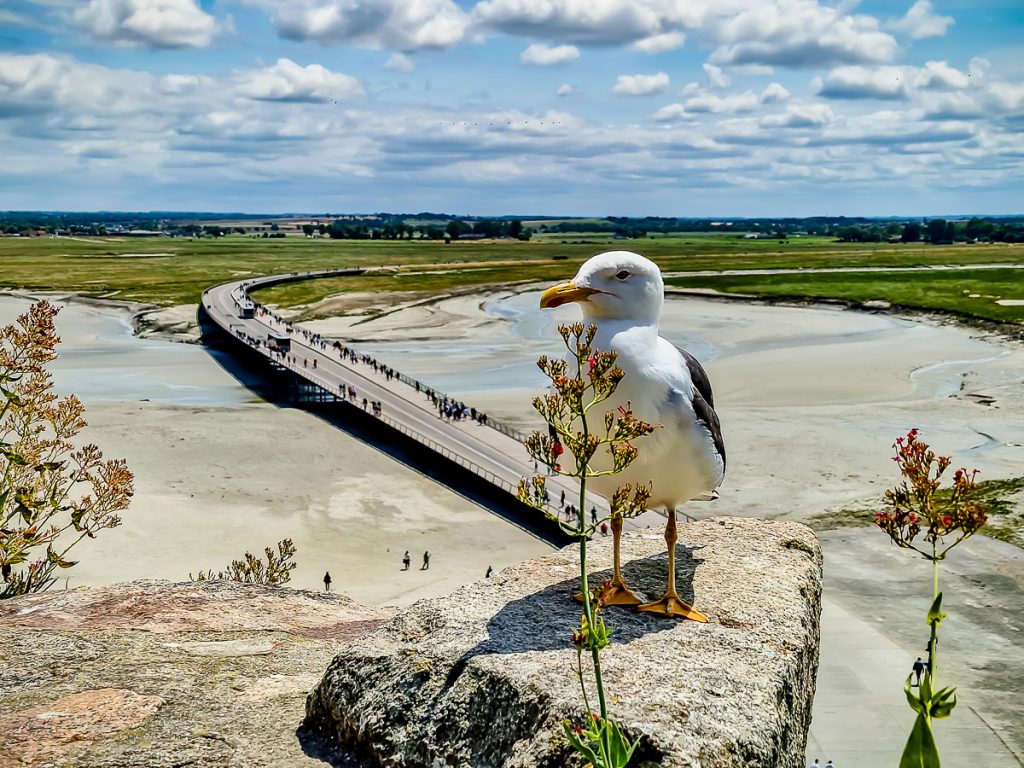
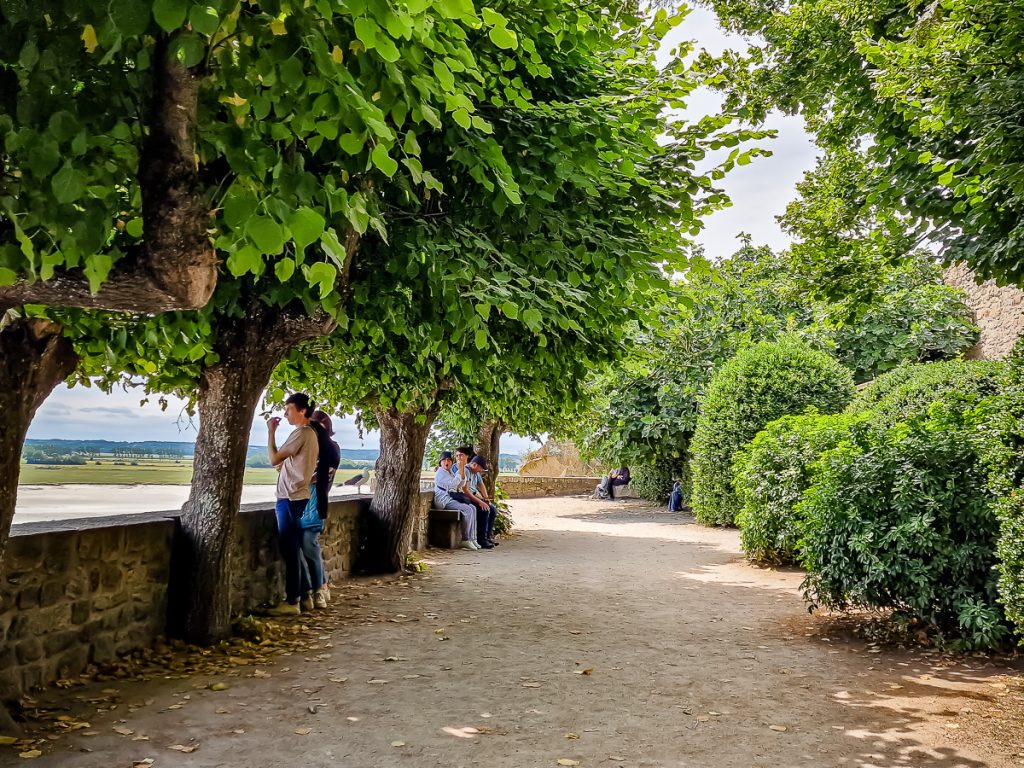
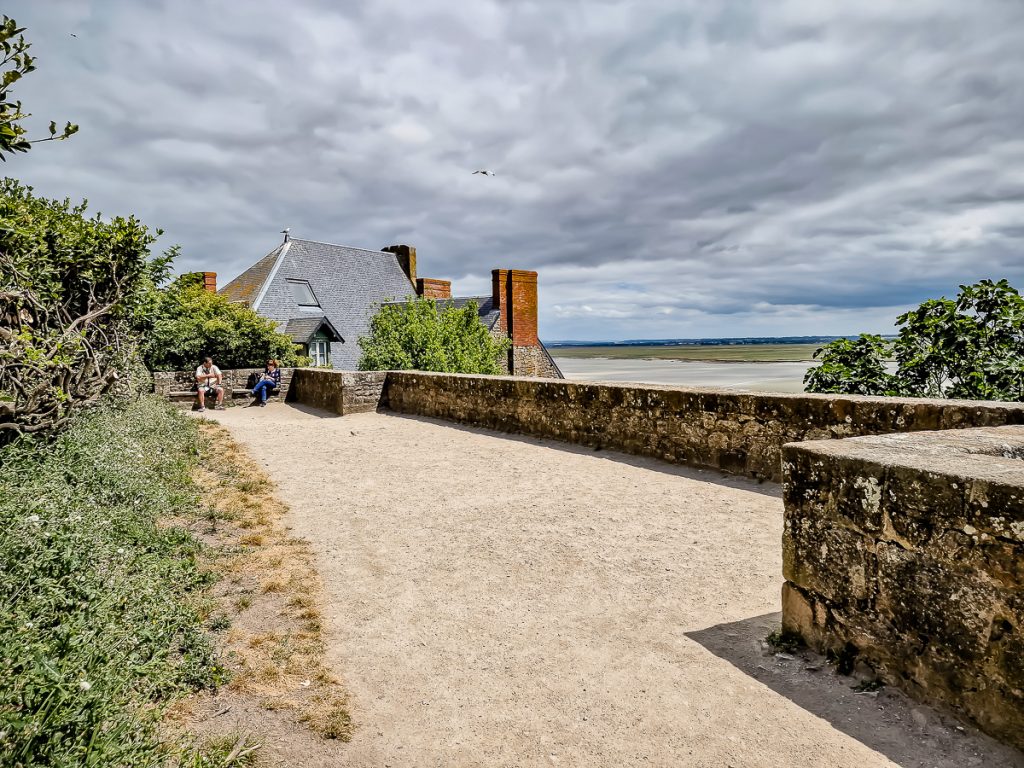
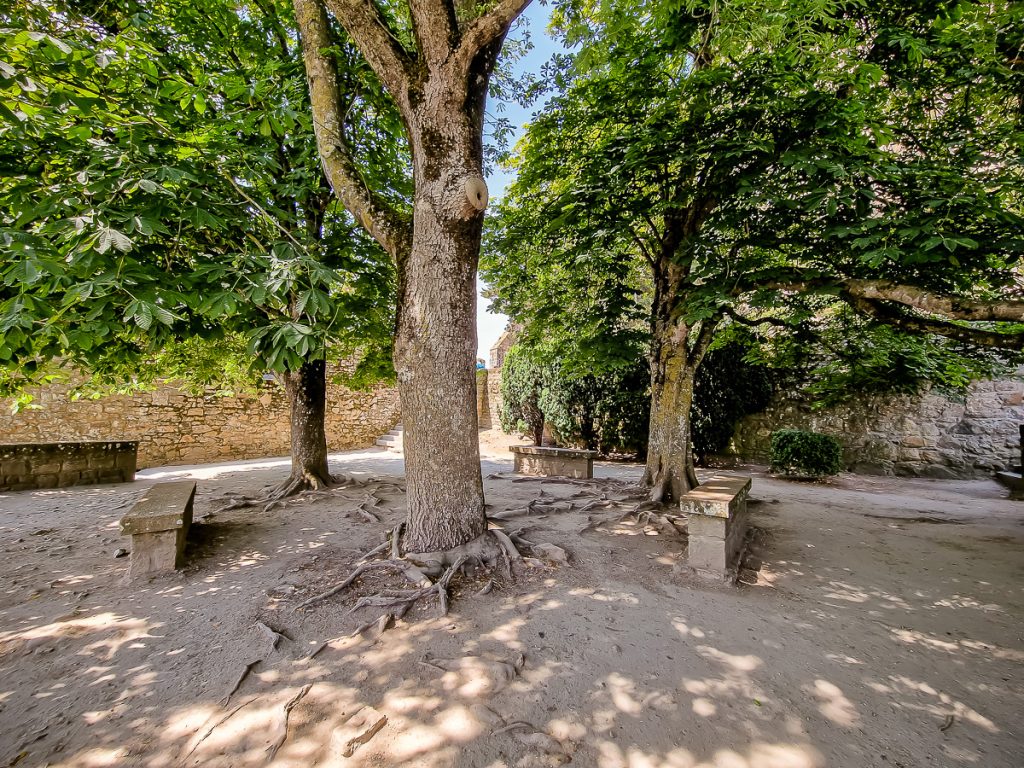
At any level you reach on this massive rock, there are terraces with stunning views! And you can rest your bones on stone benches or even on the wall itself.
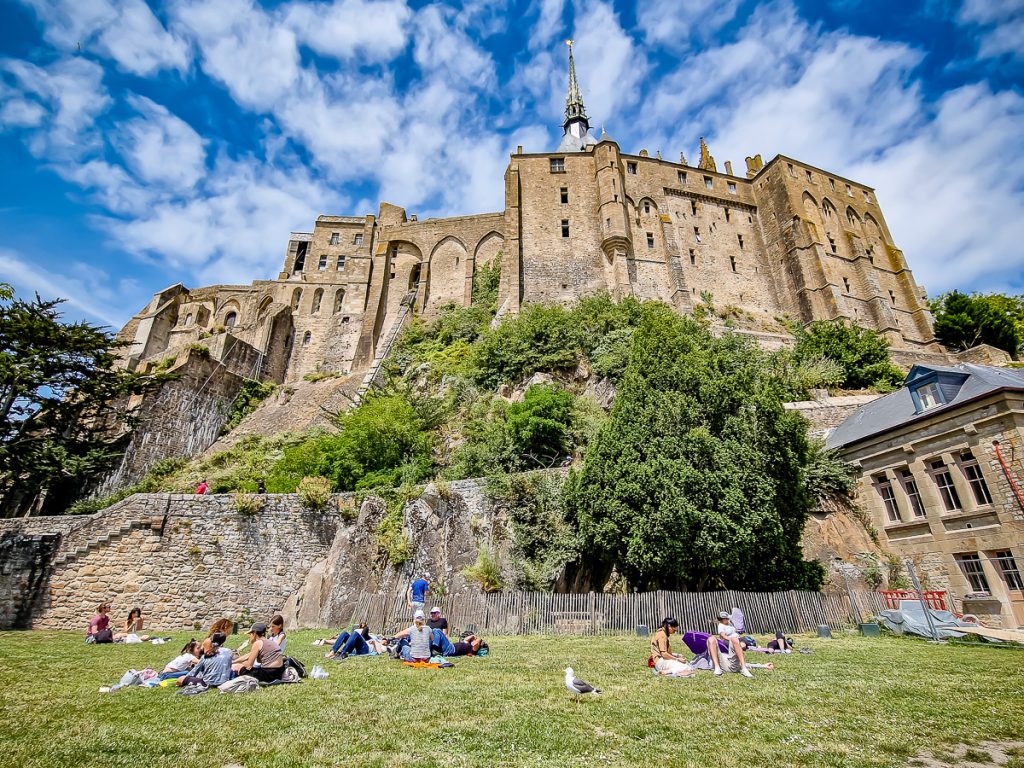
A few patches of grass are brought to life by tourists sitting as if at a picnic, reminiscing, eating a sandwich, or gossiping about their enemies.
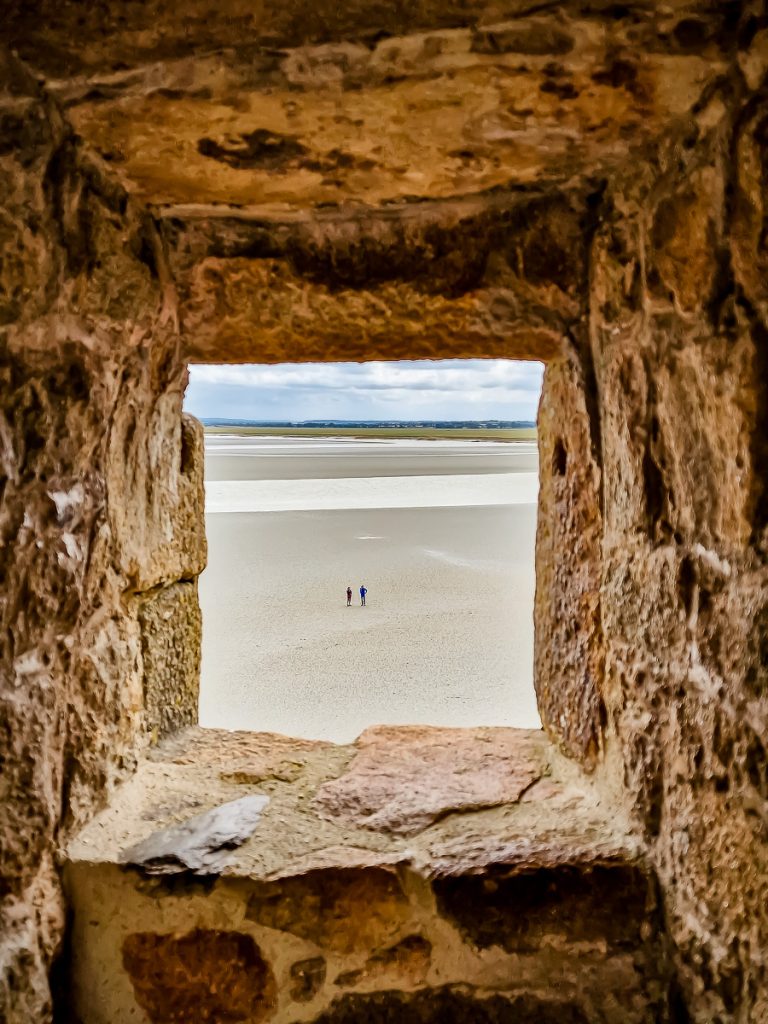
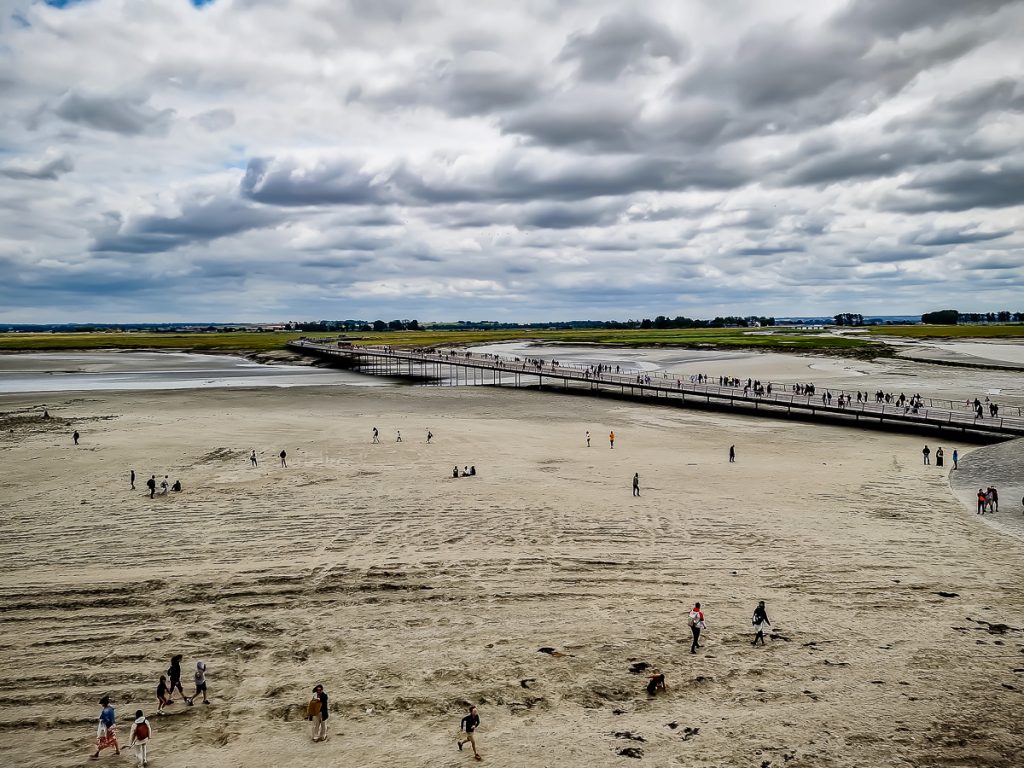
From above, I see what I also walked on: an area of sand and clay, hard as rock. But as soon as the water comes, this whole area softens…
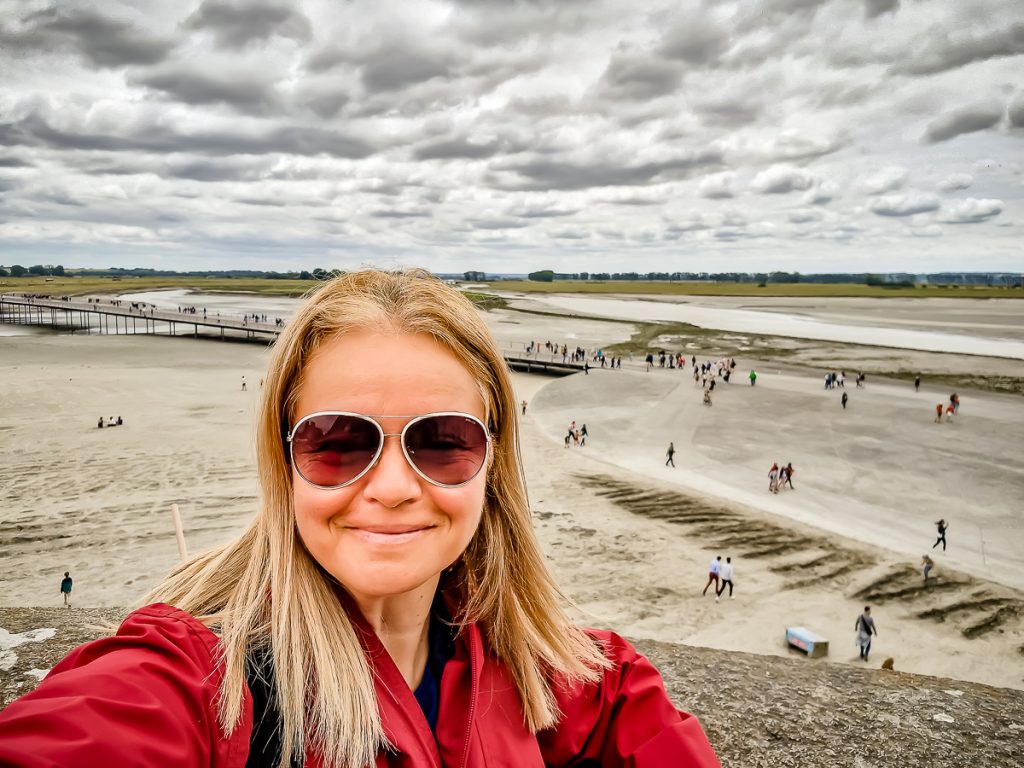
After two million selfies from every wall, from every terrace facing the sea, I head for the narrow streets that climb and keep climbing… Singing along: “To the Abbey, let my legs carry me” 🙂
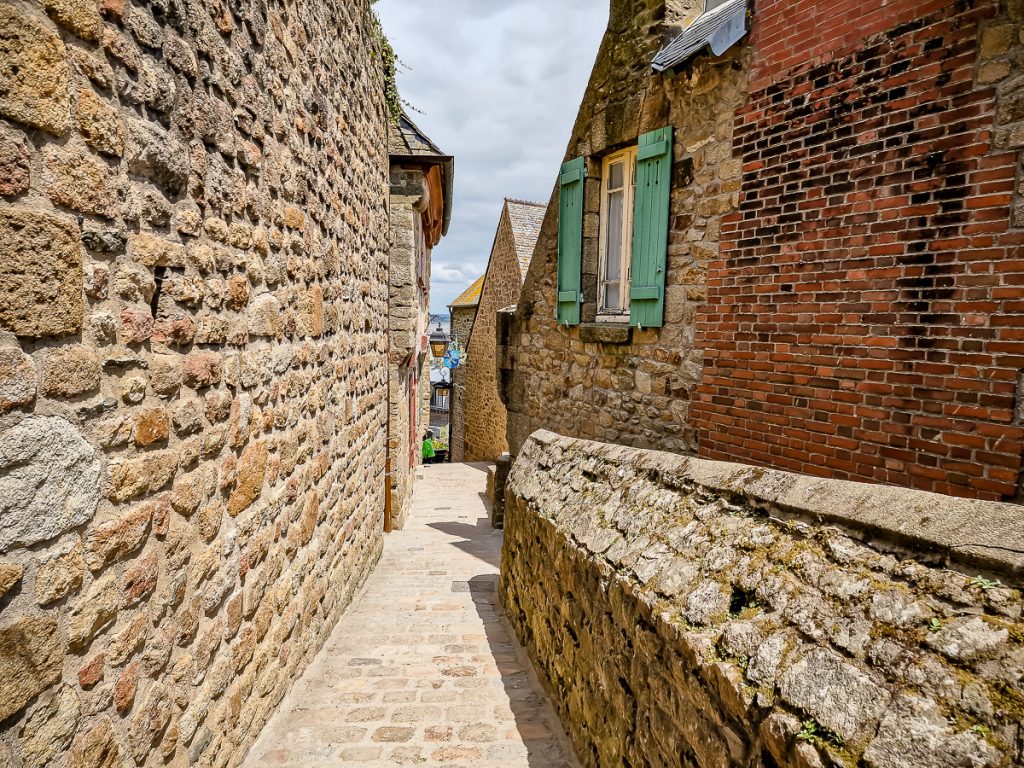
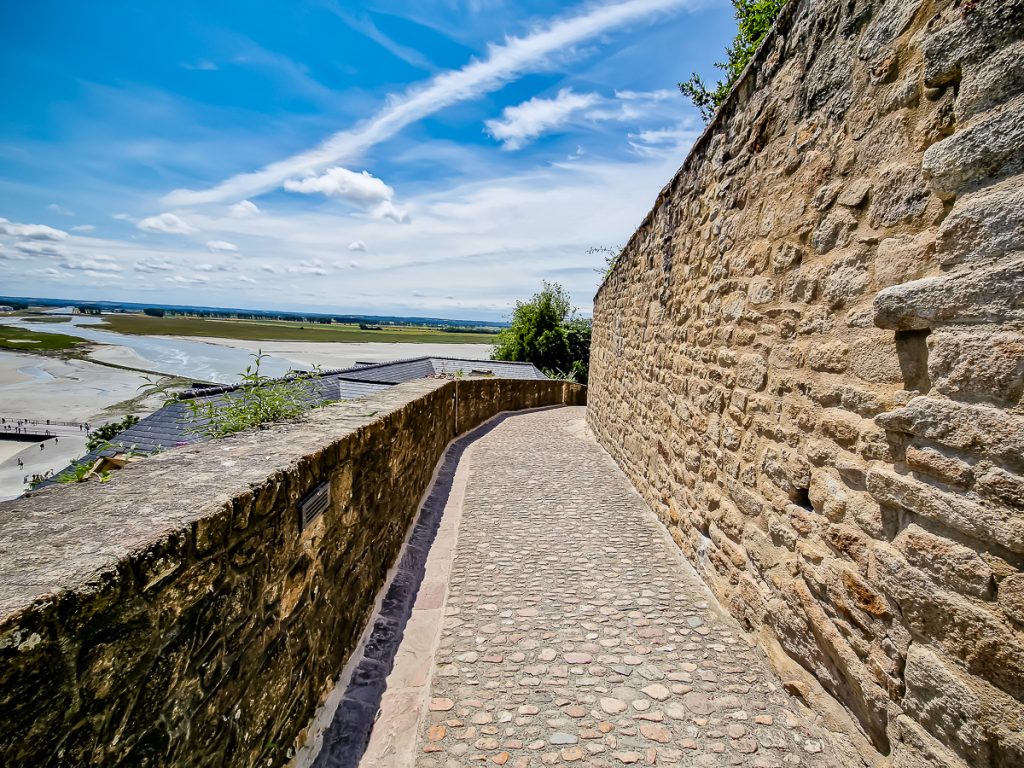
What’s cool here is that there’s hardly anyone around. A big difference compared to the bustling main street!
I come across the parish church of Saint Peter, built in the 15th-16th centuries.
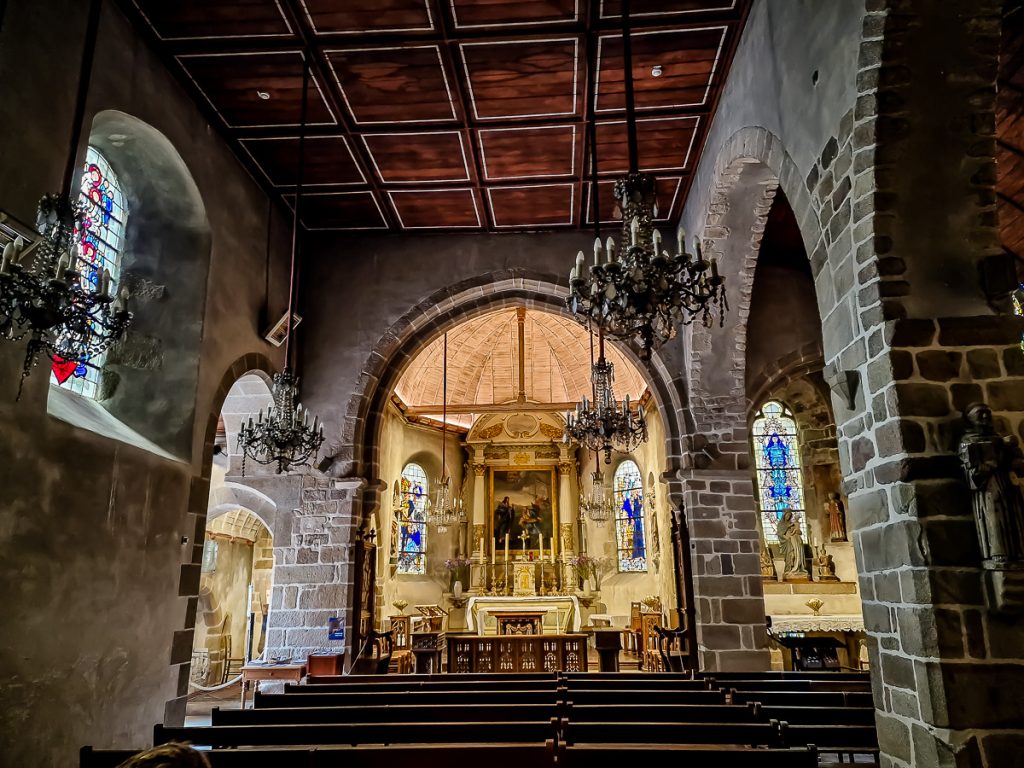
Pilgrims on their way to the Abbey would pass by this little church dedicated to Saint Peter, the keeper of the keys to heaven’s gates. They felt even more spiritually charged as they approached the Abbey, seen as an image of heaven on earth.
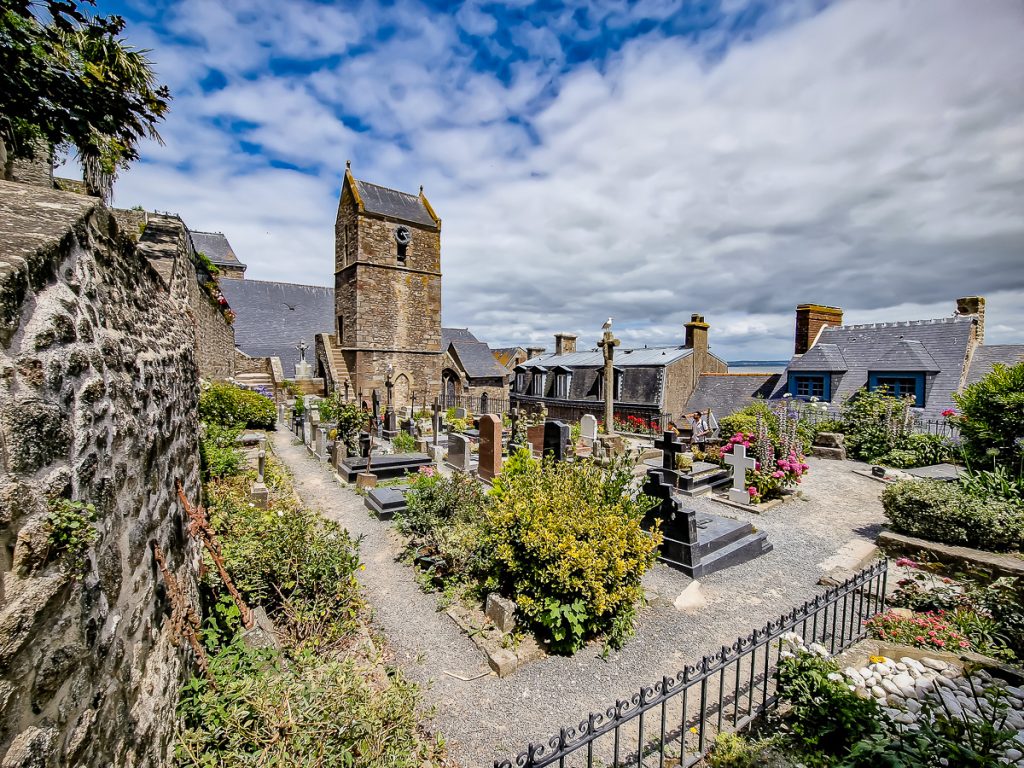
The village cemetery is right next to the church. Here lies buried Madame Poulard, a lady I’ll tell you more about shortly.
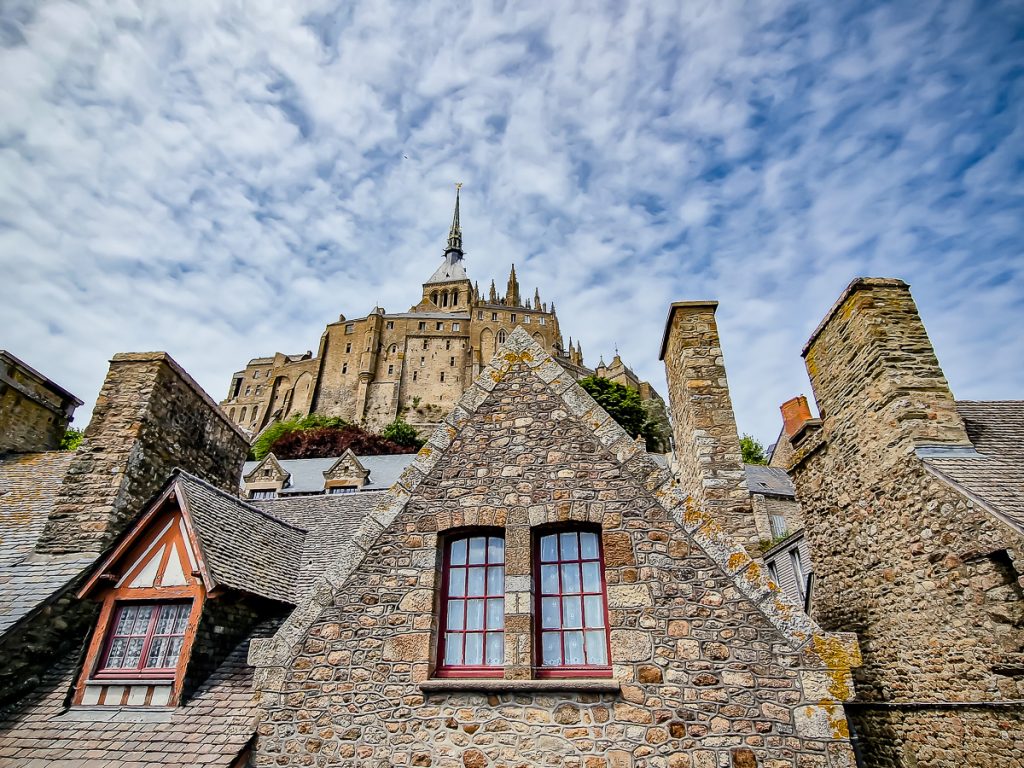
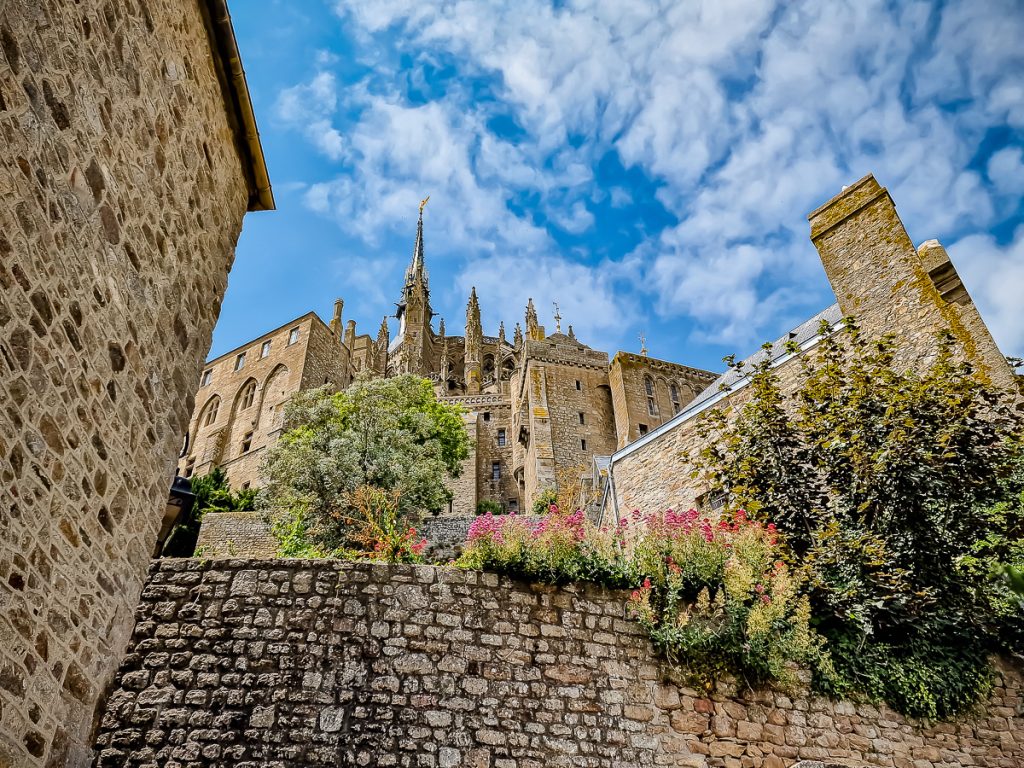
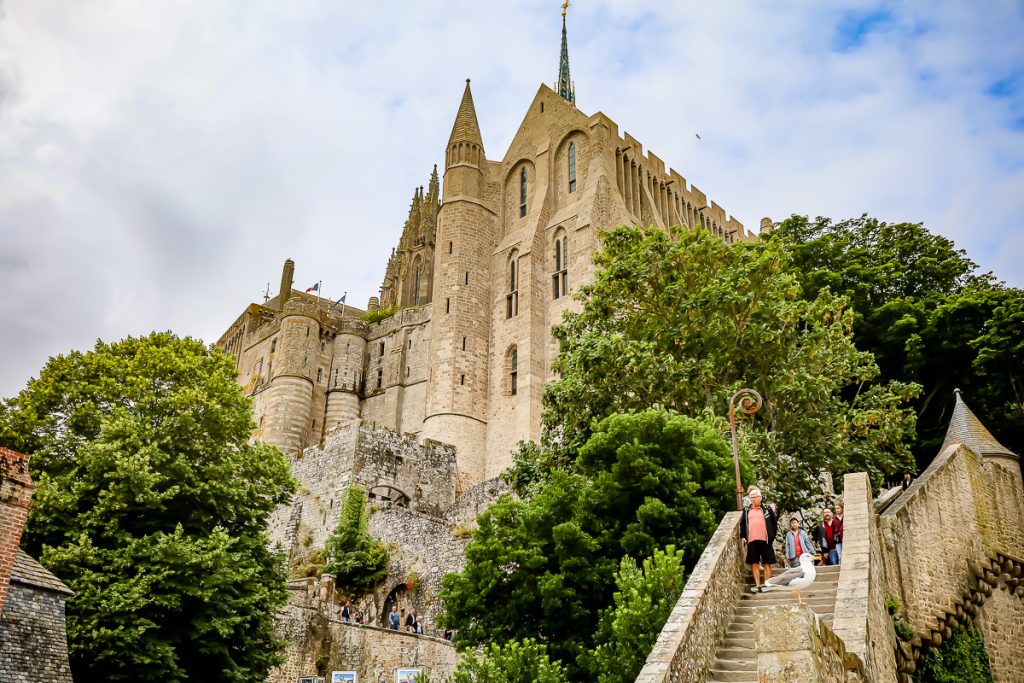
I can see the Abbey perched up high from nearly every angle.
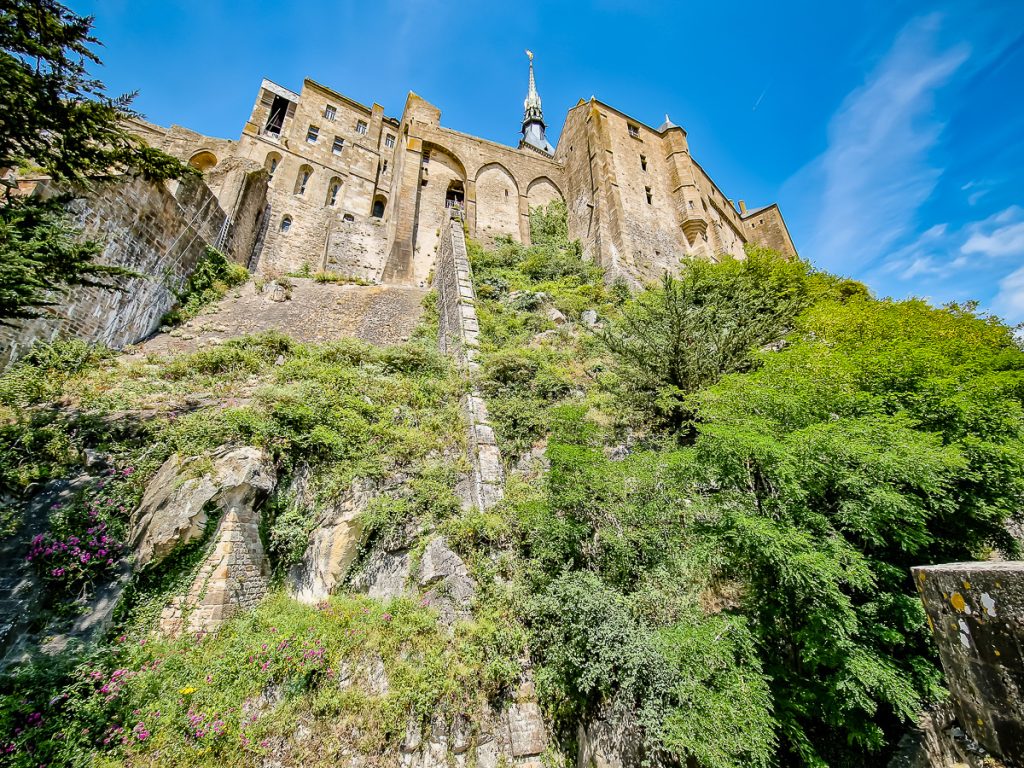
I wonder what that “channel” coming out of one of its windows means. Will I find out, now that I’ve got my ticket to visit it?…
MONT SAINT-MICHEL ABBEY
From the entrance of Mont Saint-Michel to the top, at the Abbey, it takes about 15 minutes on the main path, without detours or stops.
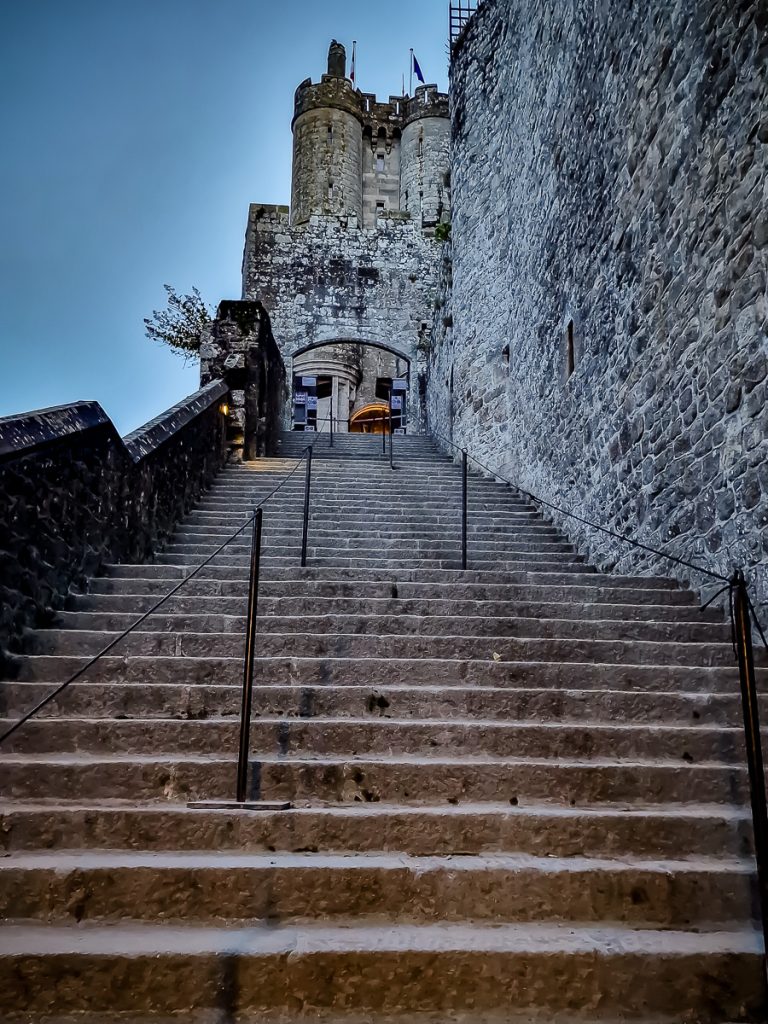
At the top of the rocky hill, sheltered from the chaos below, after gasping your way up the last two sets of unfriendly stairs, you reach the Abbey (ticket required).
Right next to its walls are the cells where the few monks and nuns still reside today.
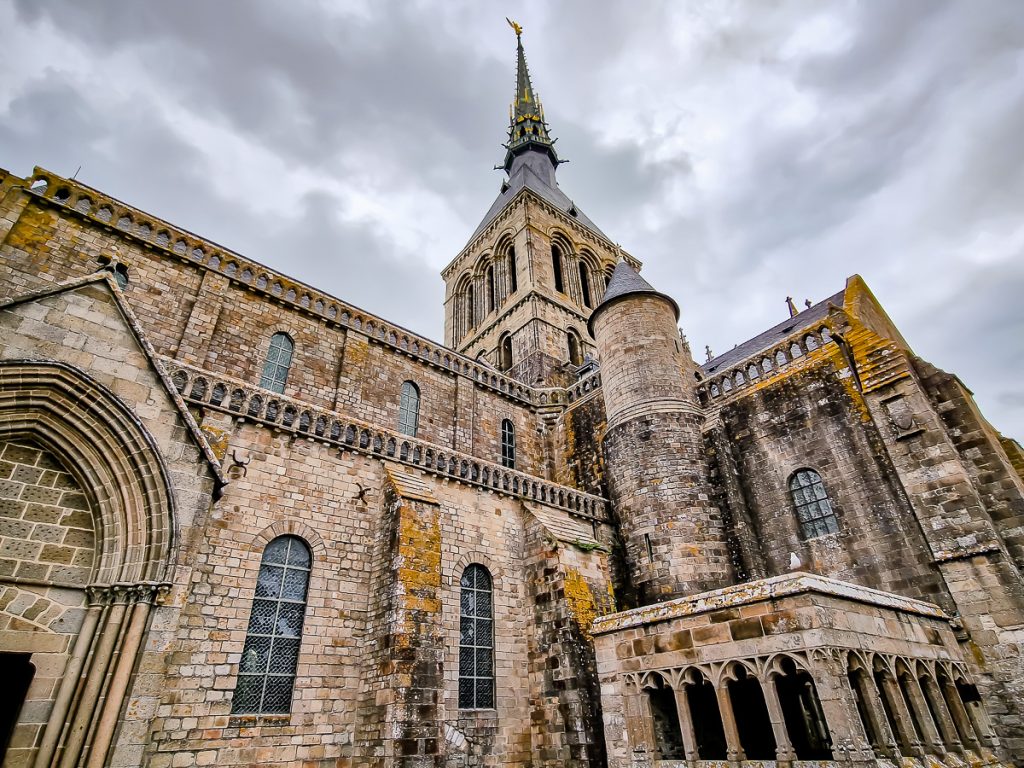
This place swallows you in its silence, making you feel isolated from the rest of the world.
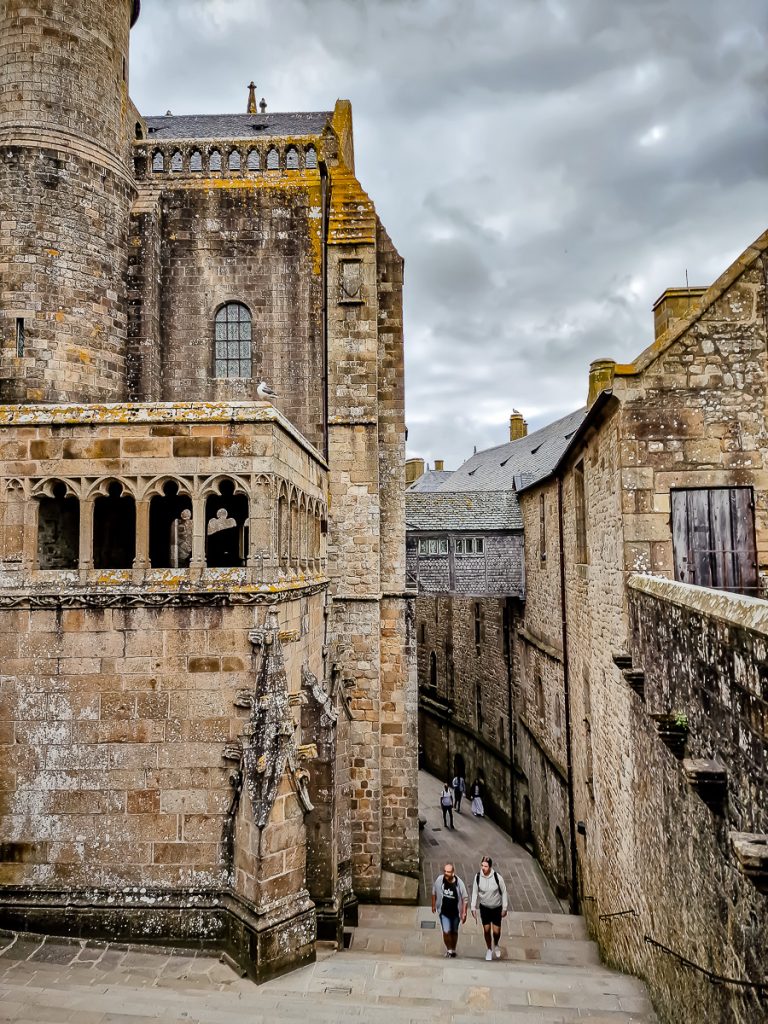
I read some statistics stating that less than a third of the millions of tourists who visit Mont Saint-Michel actually make it up here, to the Abbey. That explains the peace and quiet…
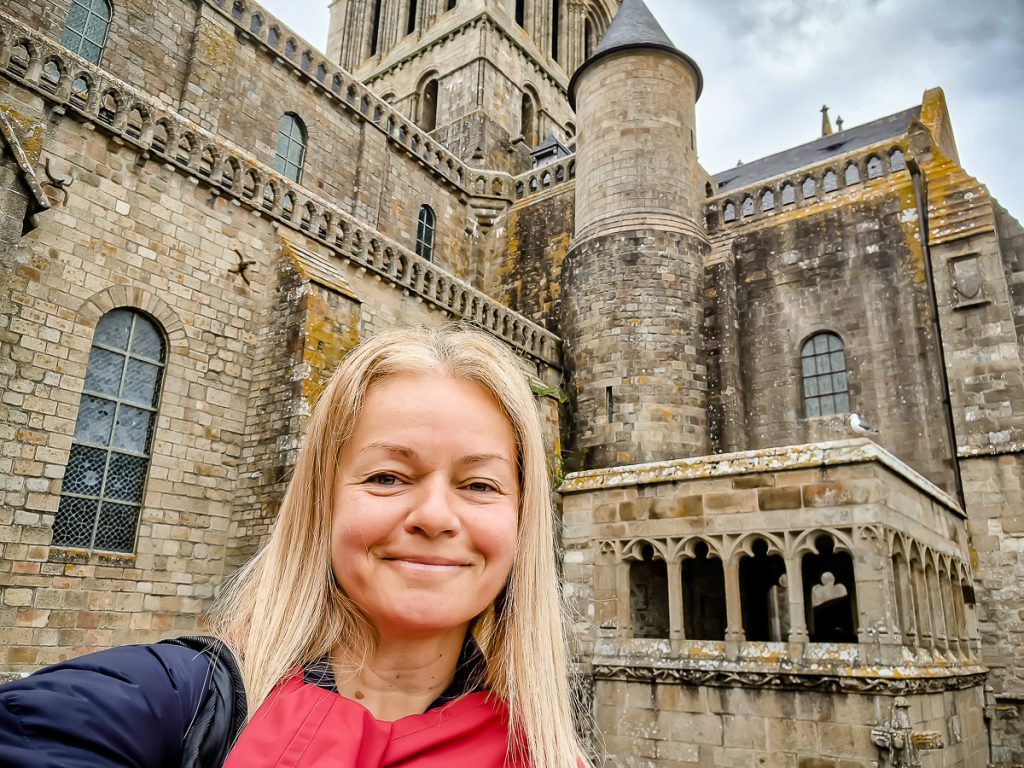
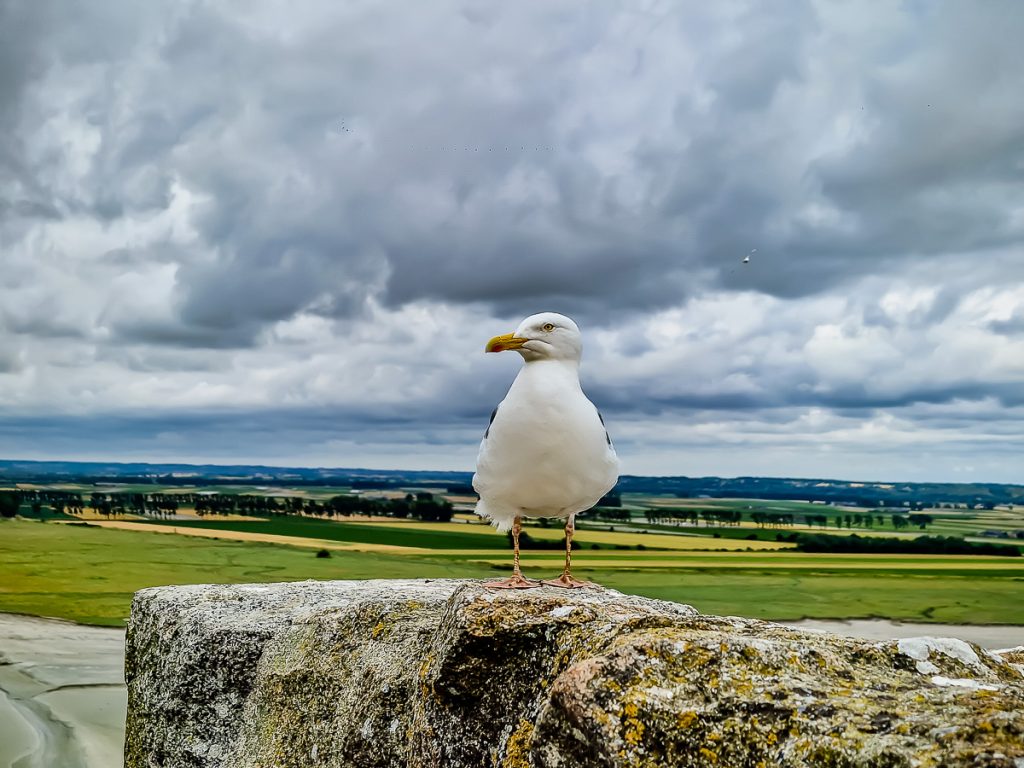
I signed up for a guided tour. It’s like a trip back in time, as I visited this place almost 40 years ago! But I only remember an inner garden. That’s why I’m flipping through old photo albums. I’m curious to see how I perceived the Abbey back then versus now. I’m sure I won’t see it as clearly this time, as my eyesight has gotten worse 🙂
Before the guide gathers us all, I take more photos:
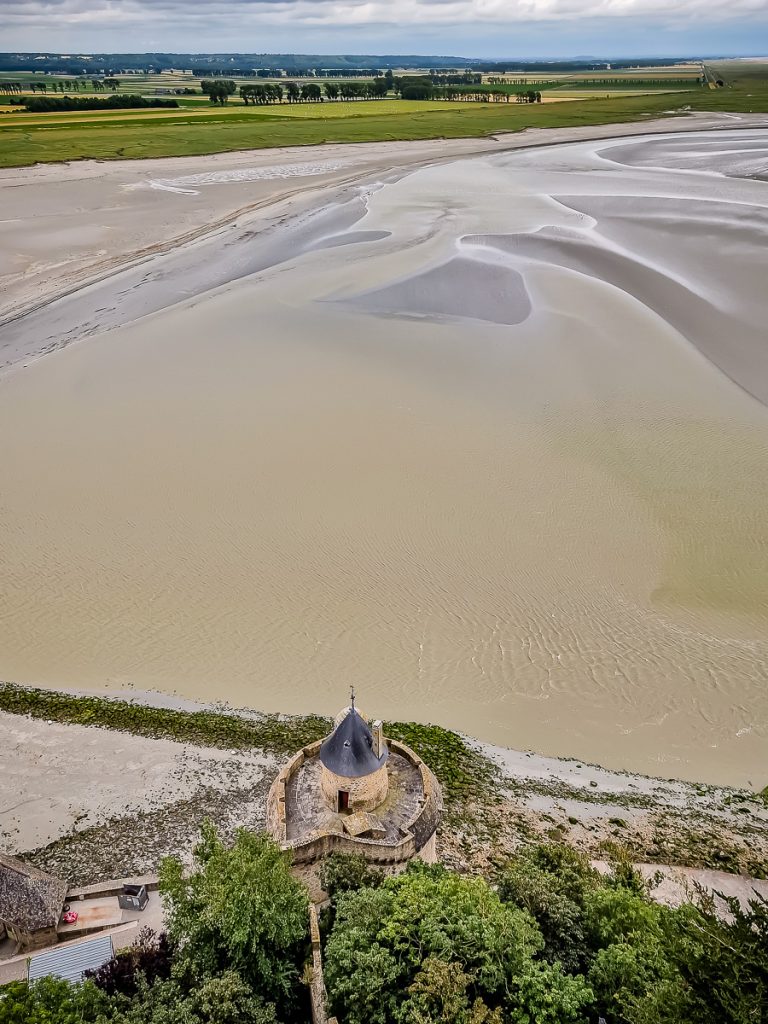
This is the Gabriel Tower, gazing over Brittany…
Its name comes from the king’s lieutenant, Gabriel du Puys, who built it around 1524. At one point, it even had a windmill at its top. It also served as a lighthouse for ships.
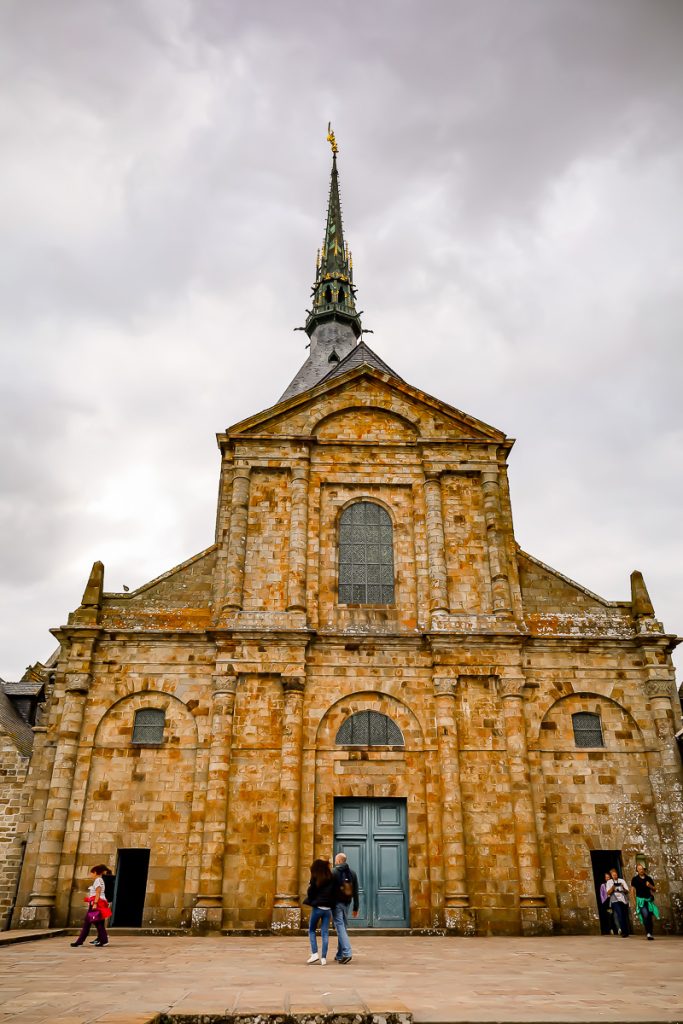
And this is the Abbey church, with a wide terrace about which we learn, as the tour begins, that it used to be much smaller, because the old church covered a larger area. However, during a storm, lightning destroyed it.
It’s freezing up here!!! I put on everything I packed in my backpack. Jacket over jacket, a towel turned into a scarf, hood up, and I’m still shivering.
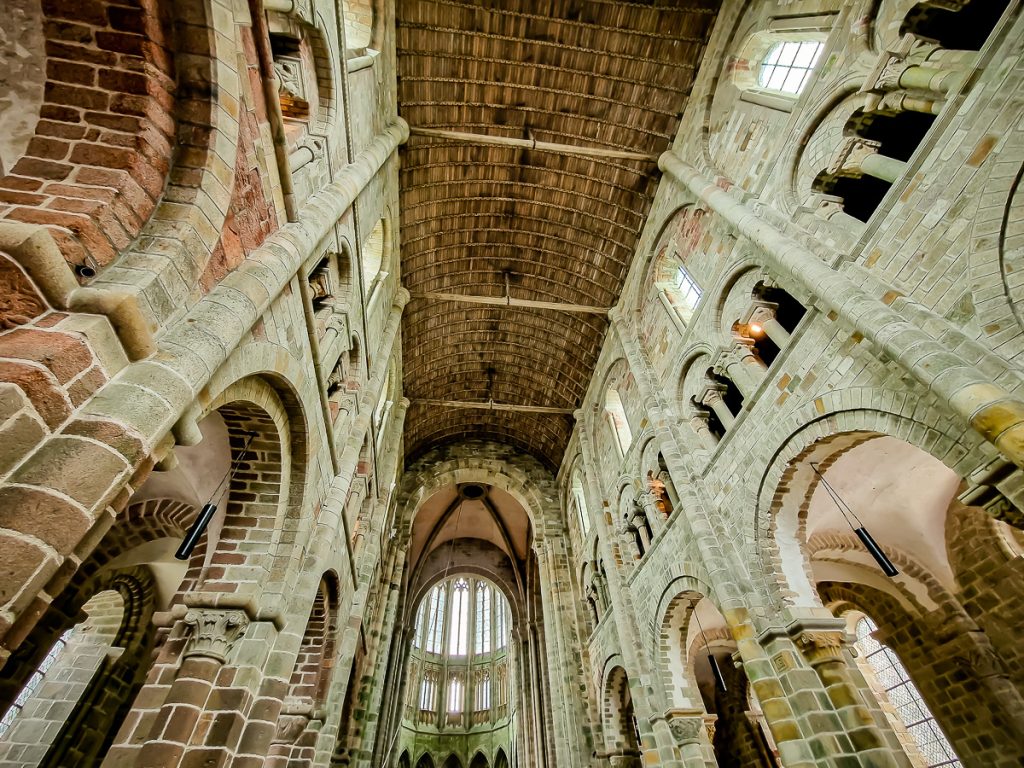
We enter the church and start learning more details.
The Abbey has three superimposed levels, and the visit proceeds by descending, moving from one hall to another.
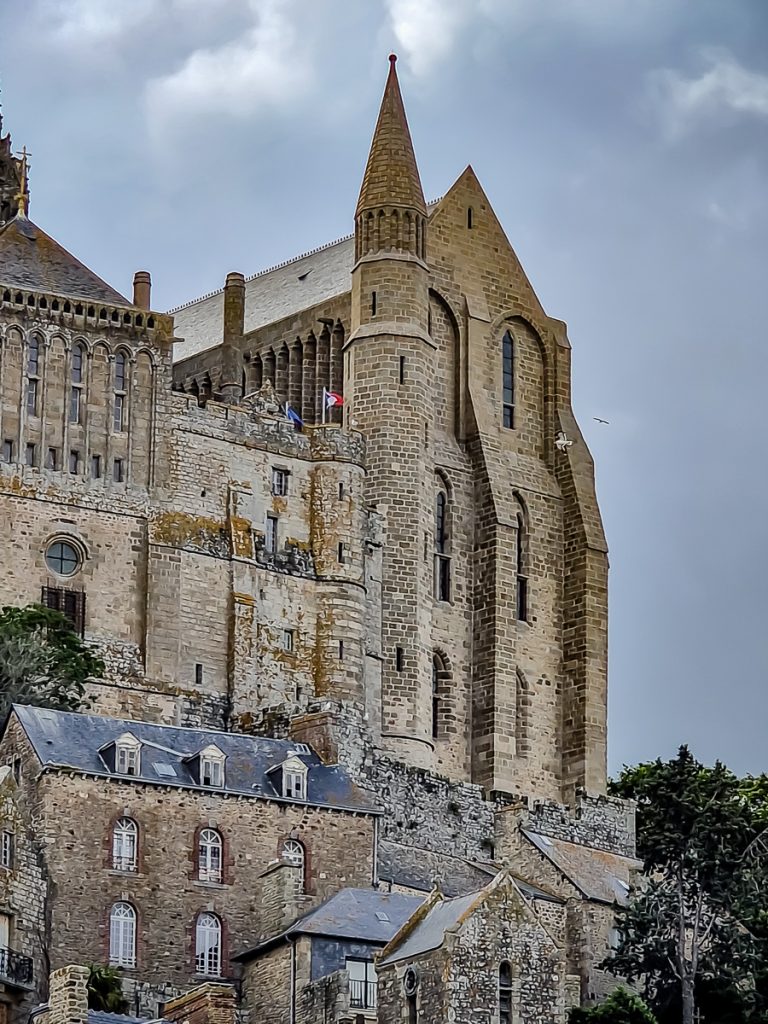
The Gothic wing of the monastery is called “La merveille” (The Wonder), a true masterpiece of Norman medieval architecture, perched on the mountain in a way that seems to defy gravity.
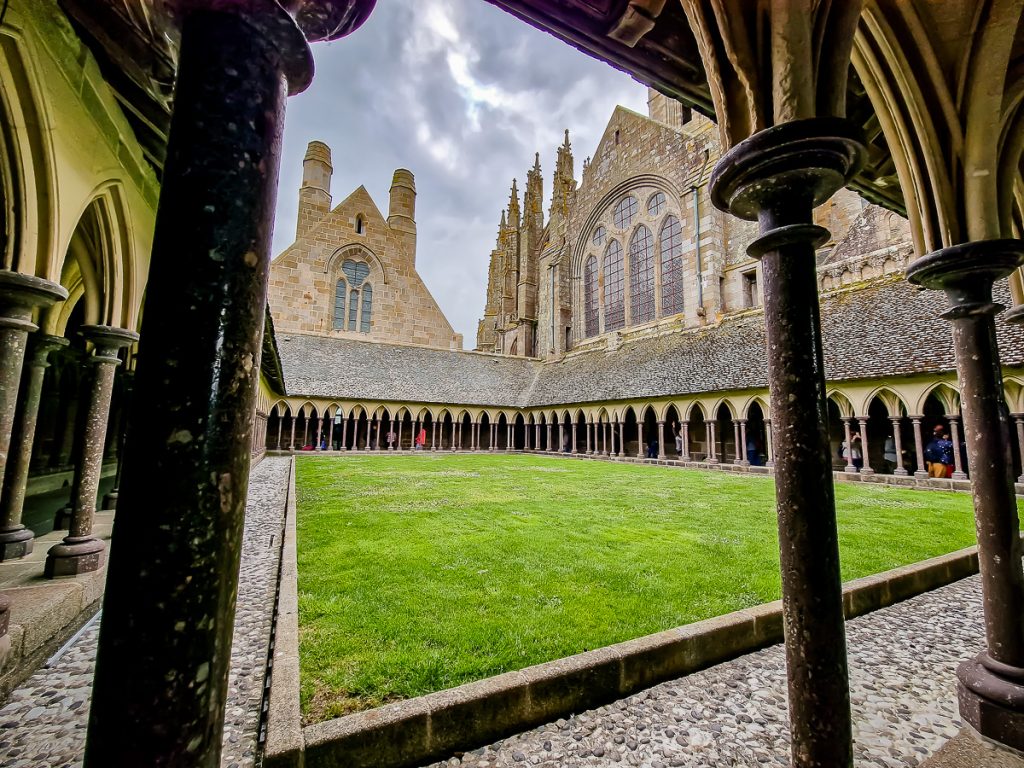
Here it is my inner garden at the top of Mont Saint-Michel!!!
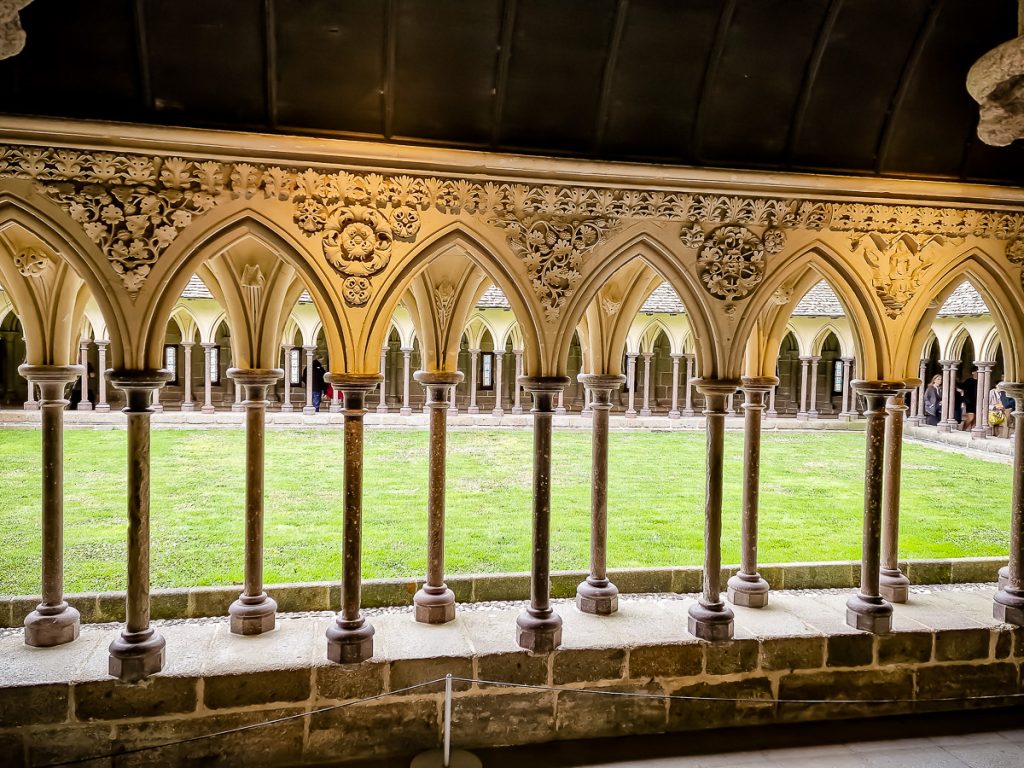
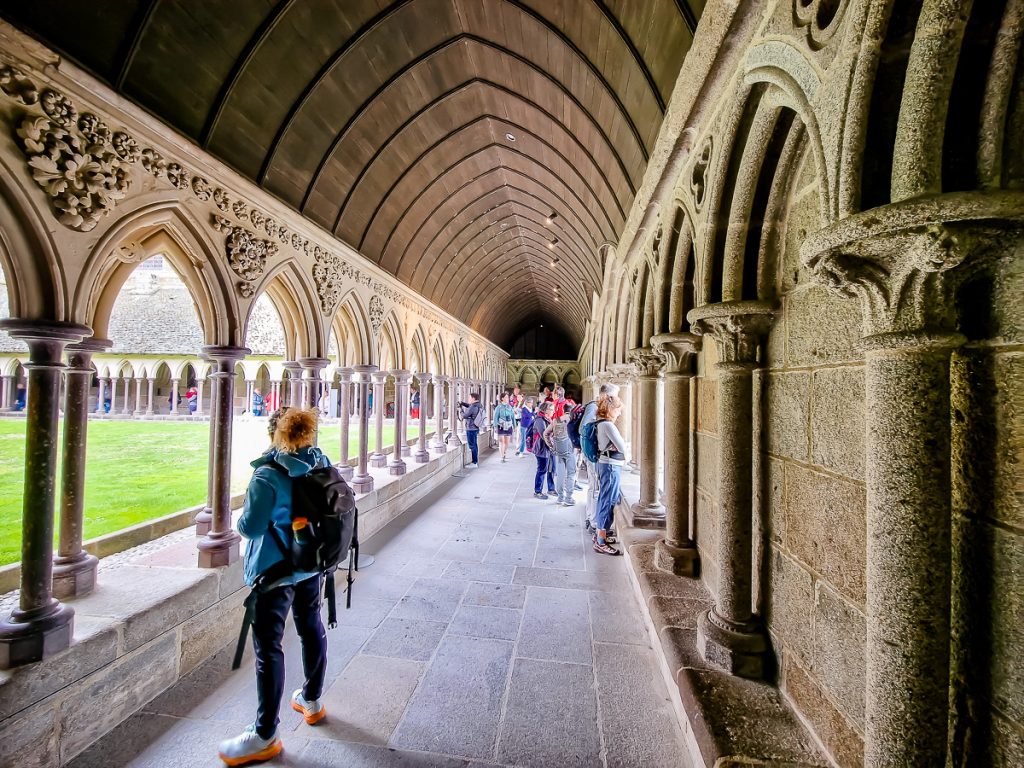
The only part that stuck in my memory since 1986.
It’s actually an inner courtyard, a place for monks to pray and meditate.
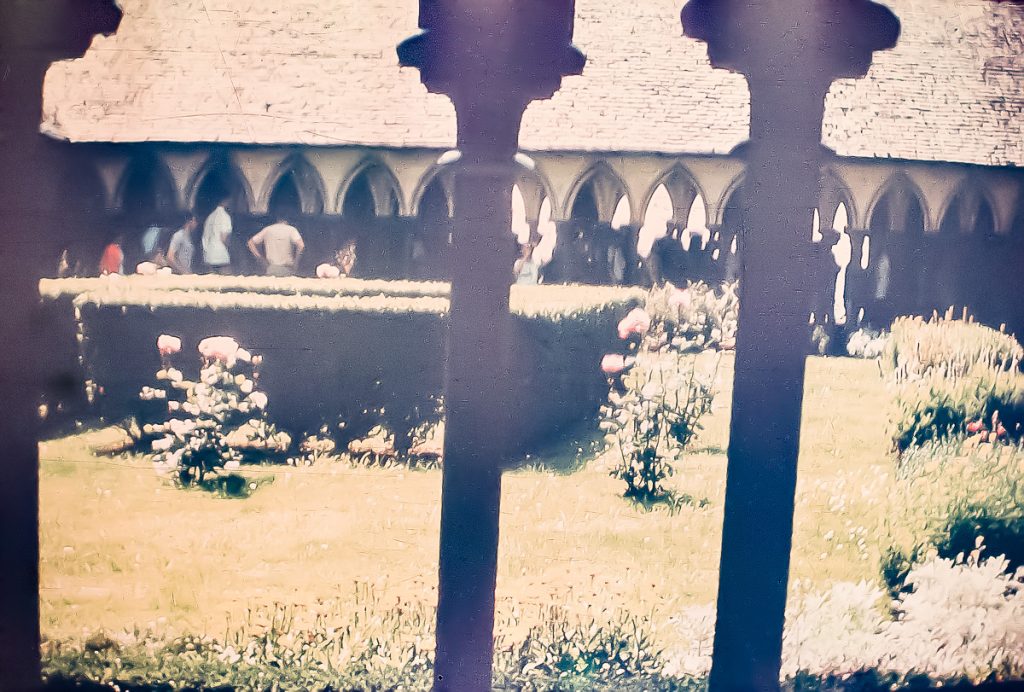
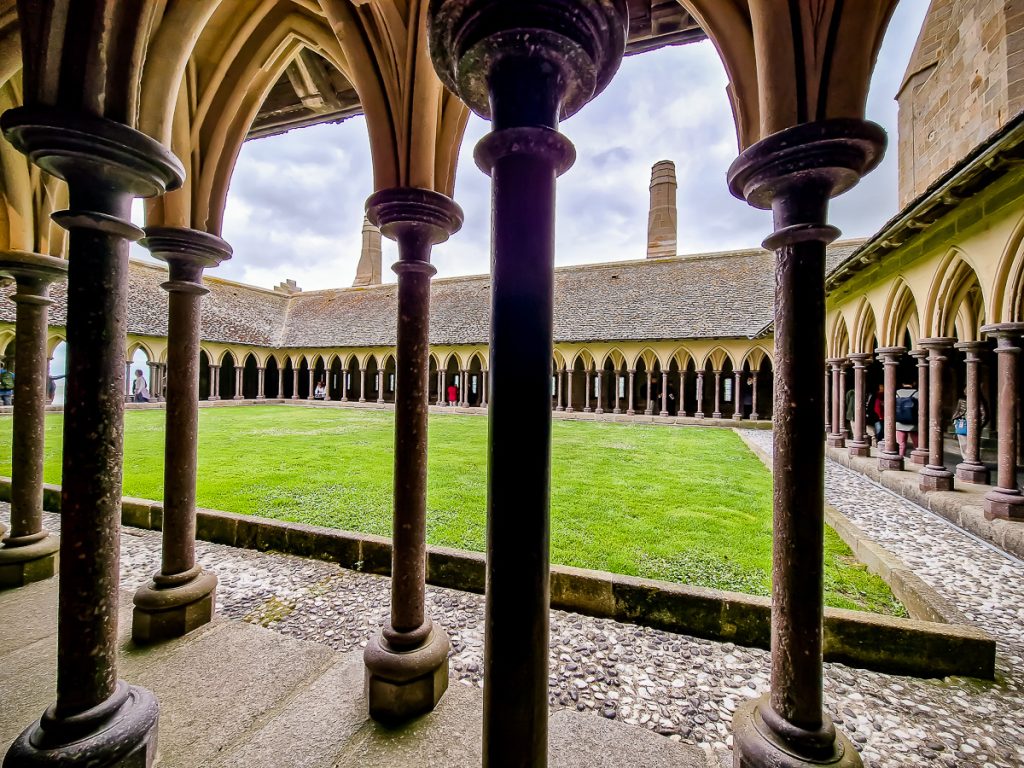
Playing the “spot the differences” game, the bushes, roses, and free access through the garden are gone. Now you can only stand behind the columns and take as many pictures as you want.
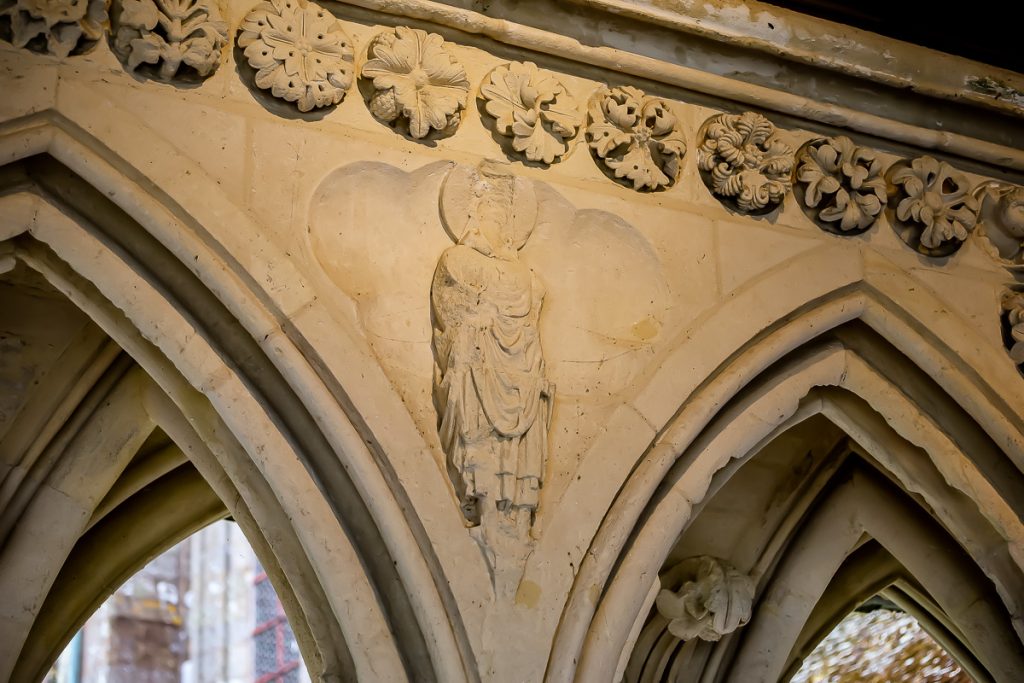
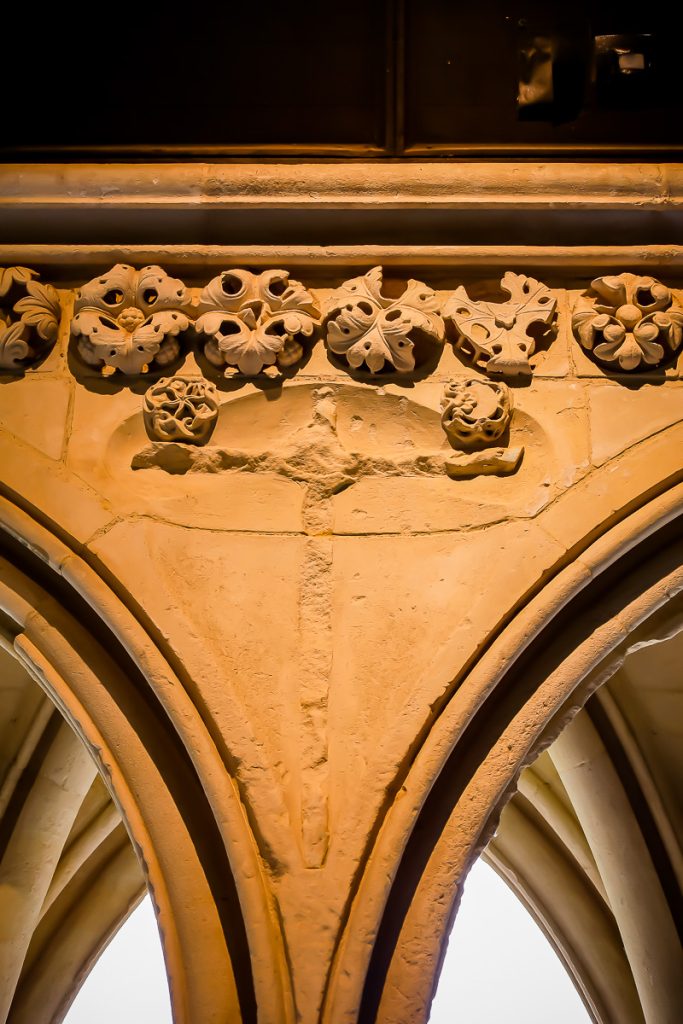
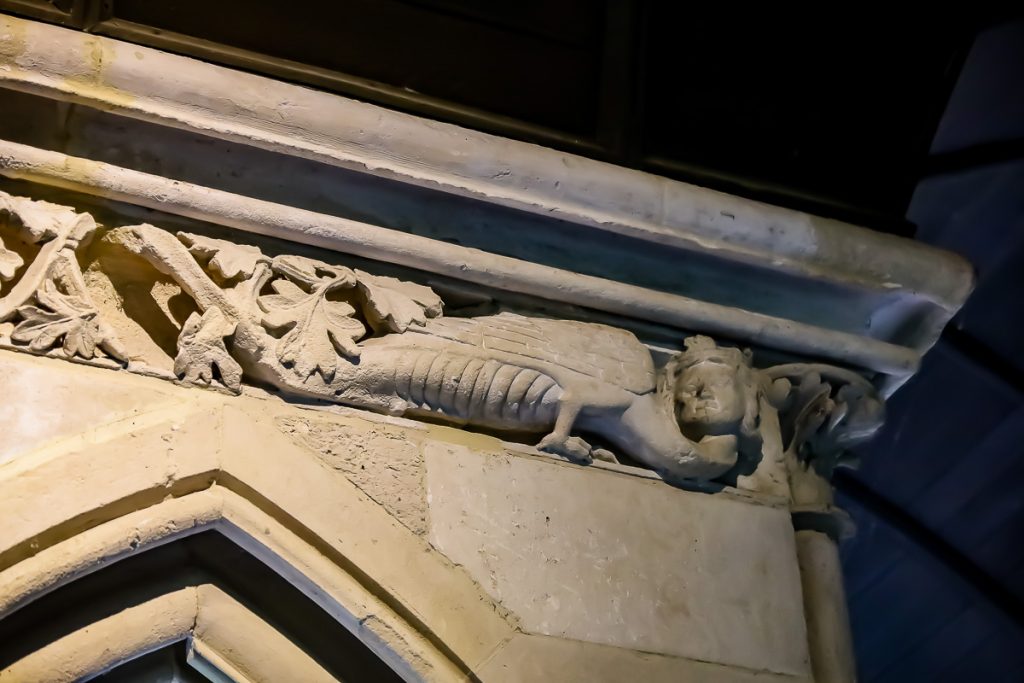
This Abbey was one of the greatest pilgrimage sites of Christianity in the Middle Ages!
It ranked in the Top 4, right after Bethlehem, St. Peter’s in Rome, and Santiago de Compostela in Spain! How cool is that??
Apparently, they had a stone here bearing the footprint of Archangel Michael, brought from Italy. I never found out what happened to it. Hopefully, no kid decided to “test their luck” by skipping the stone into the sea…
Seven kings of France visited this place as pilgrims at least once in their lifetime. That’s why they built a reception hall for them and the nobles.
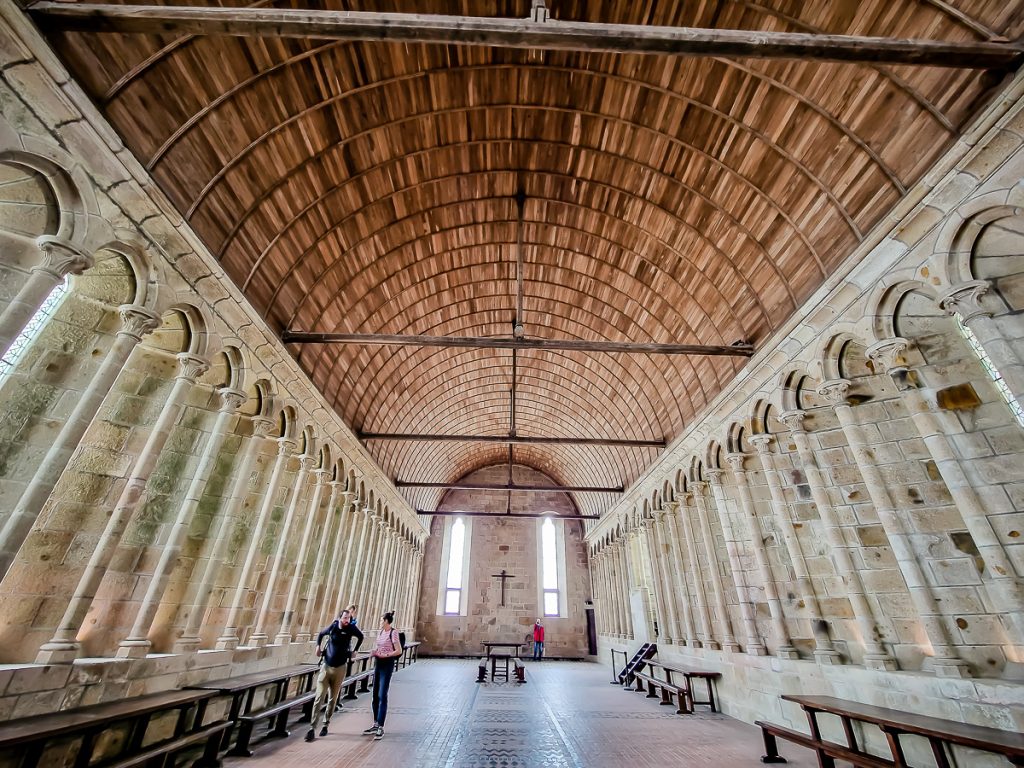
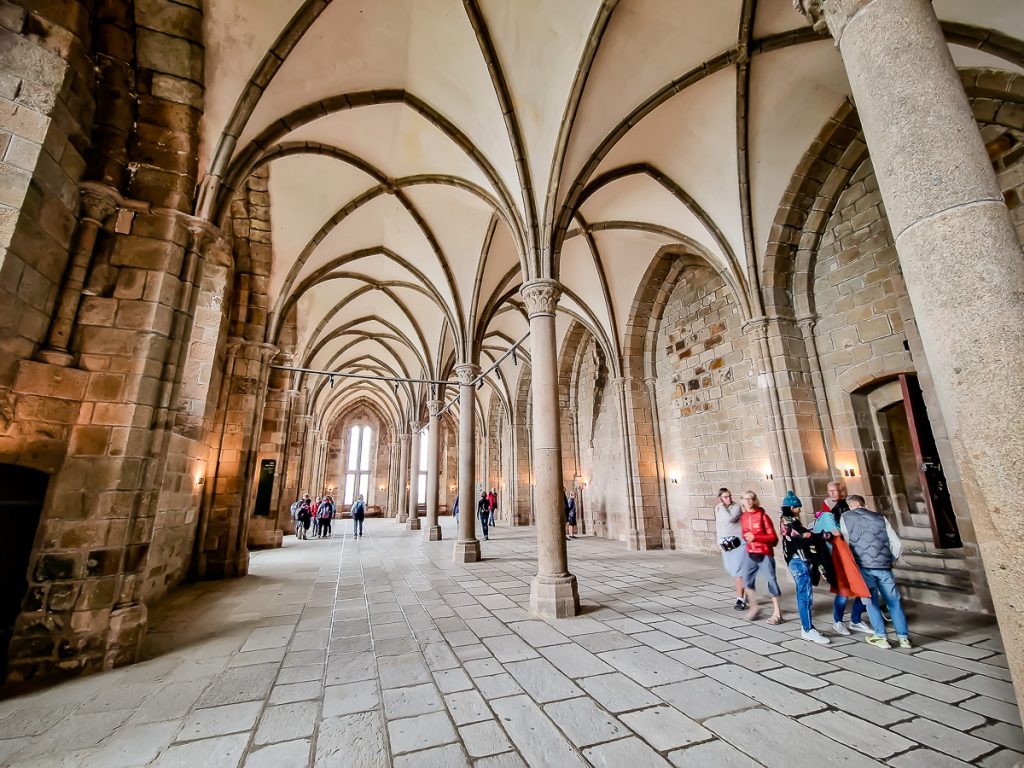
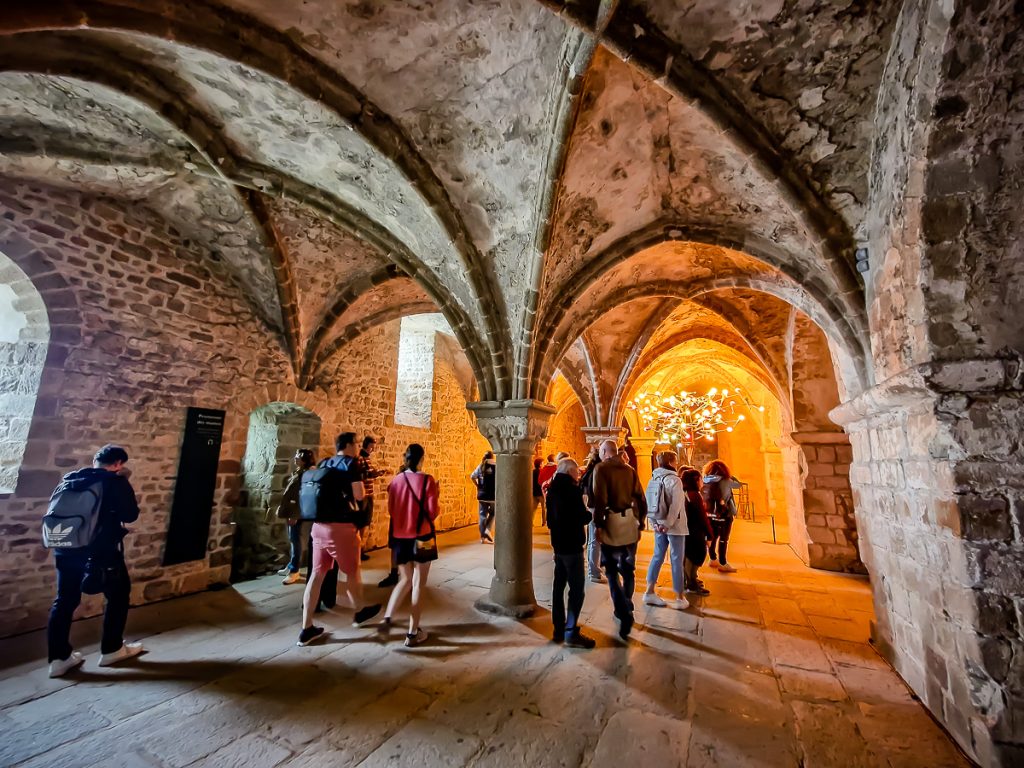
We move smoothly along a route that I’m not sure I could navigate on my own. We see the hall where the monks used to gather for meals, then crypts, chapels, the Guest Hall with two large fireplaces – would’ve been nice to have a fire in them, included in the ticket price :), next, we pass through the corridor meant for walking and reflection, where monks could stroll in peace.
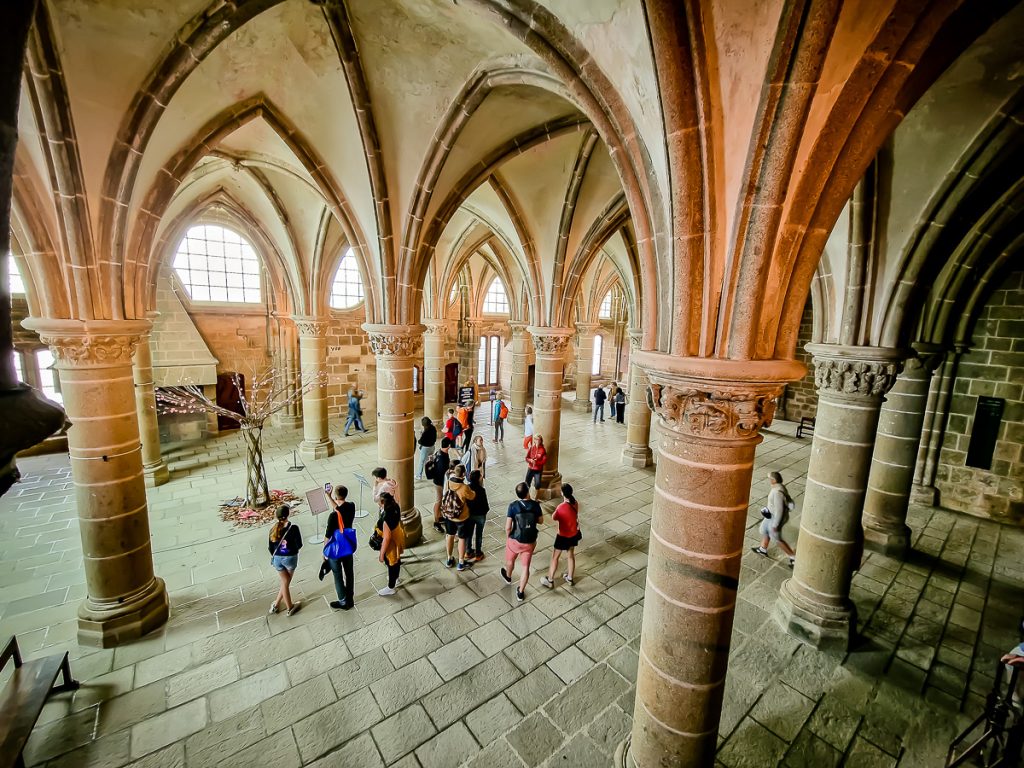
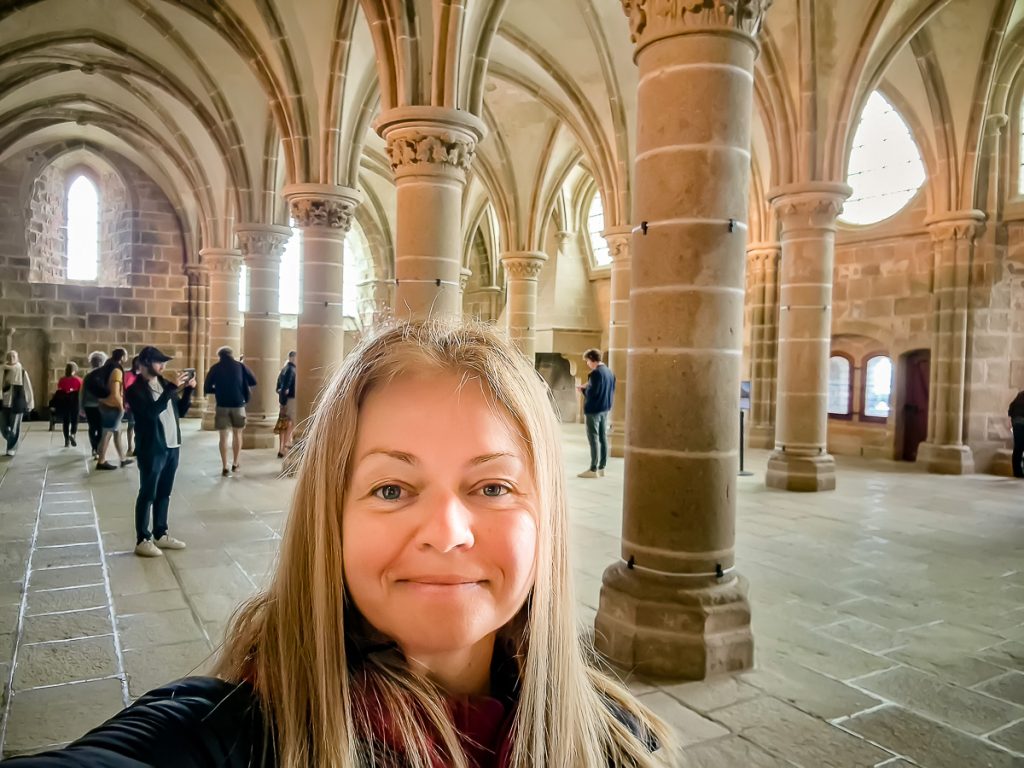
We then reach the Knights’ Hall, considered one of the most beautiful Gothic halls in French architecture.
Here, in 1469, the Order of the Knights of Saint Michael was established.
And now I get what that “bobsled track” I saw from the outside is about. Remember it? Look, I’ve taken a clearer picture of it here:
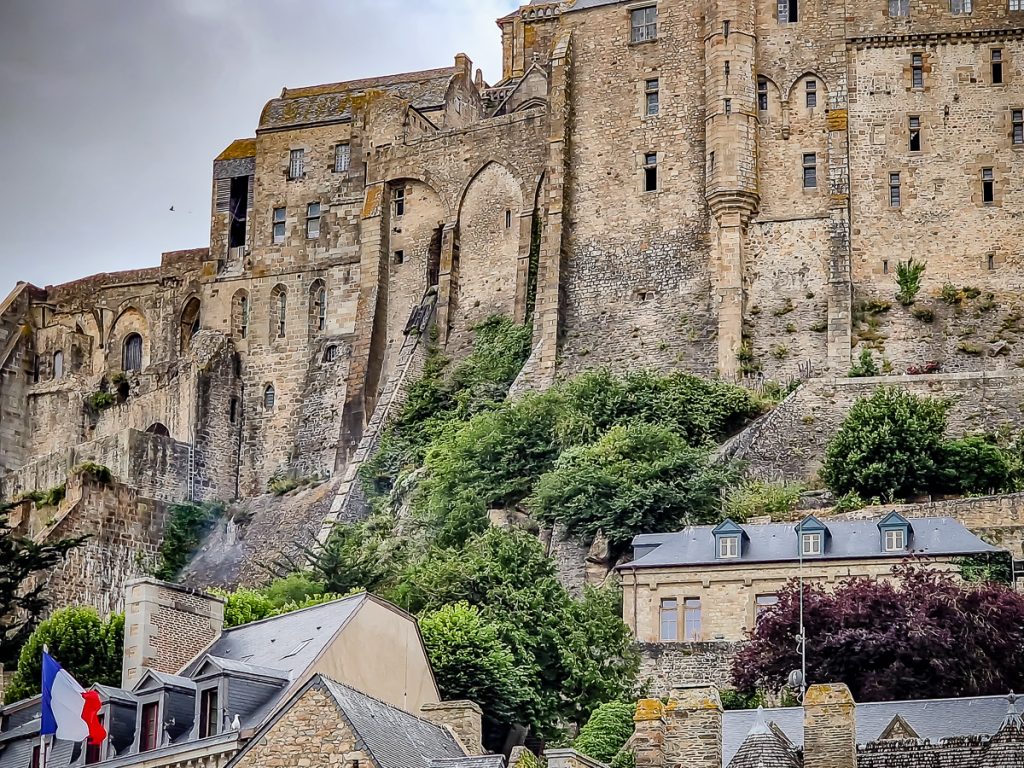
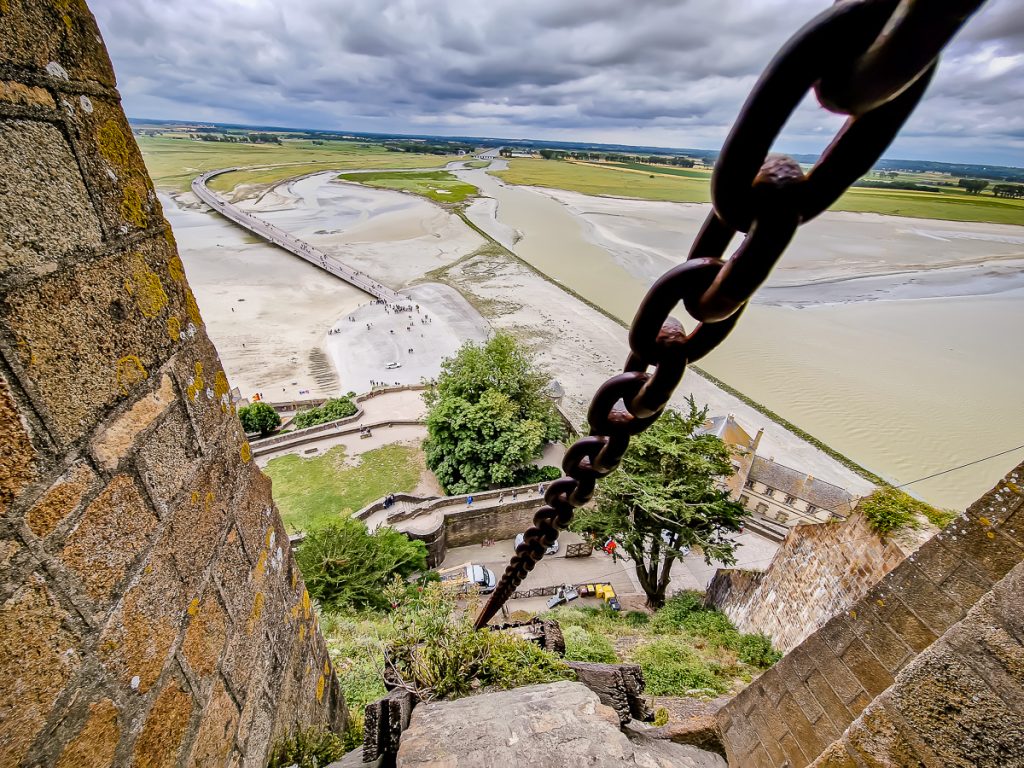
The abbey was also a prison for a time! In the 18th century, Napoleon I closed the abbey, the monks left, and the place became a state prison, where thousands of citizens who opposed the regime were incarcerated. It was called the “Bastille of the West”, because the tides and shifting sands made escape impossible.
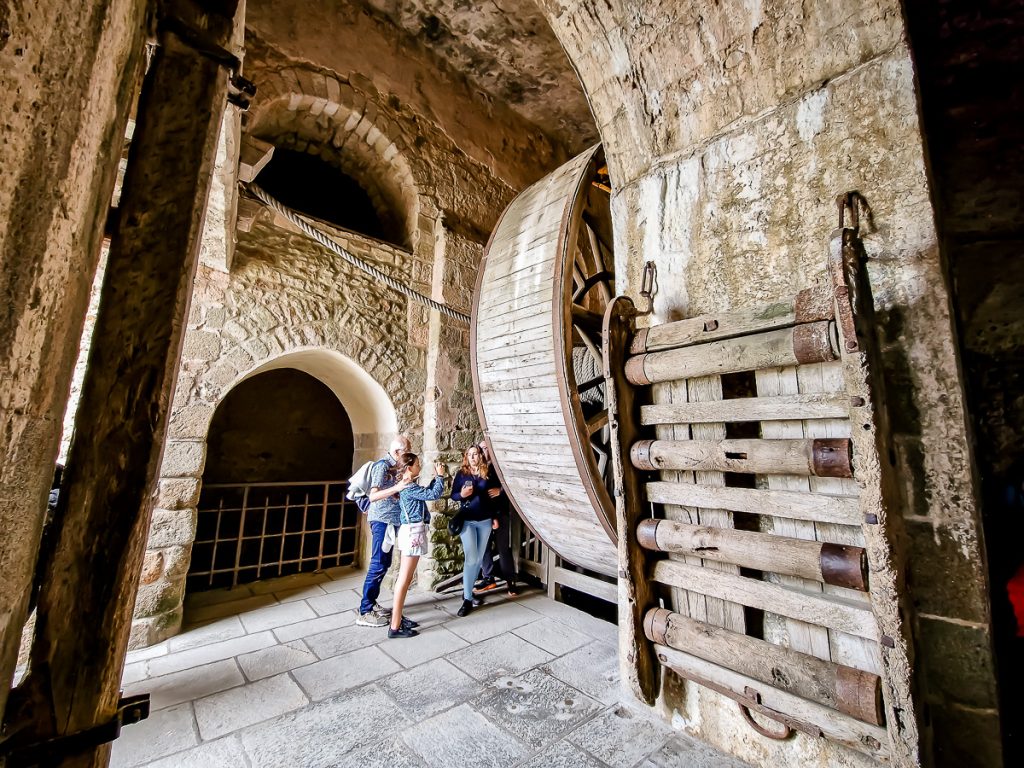
Inside the massive wheel mounted in this hall, the prisoners would enter. They would kick their legs, spinning the wheel, just like the little mice you see kicking their paws inside a small spinning wheel.
They did this to raise and lower a cart of goods on that “track”. Whenever a delivery from Glovo or Fedex with food or materials arrived, they hurried to receive it.
This ensured that they couldn’t escape when going to pick up the package at the gate 🙂
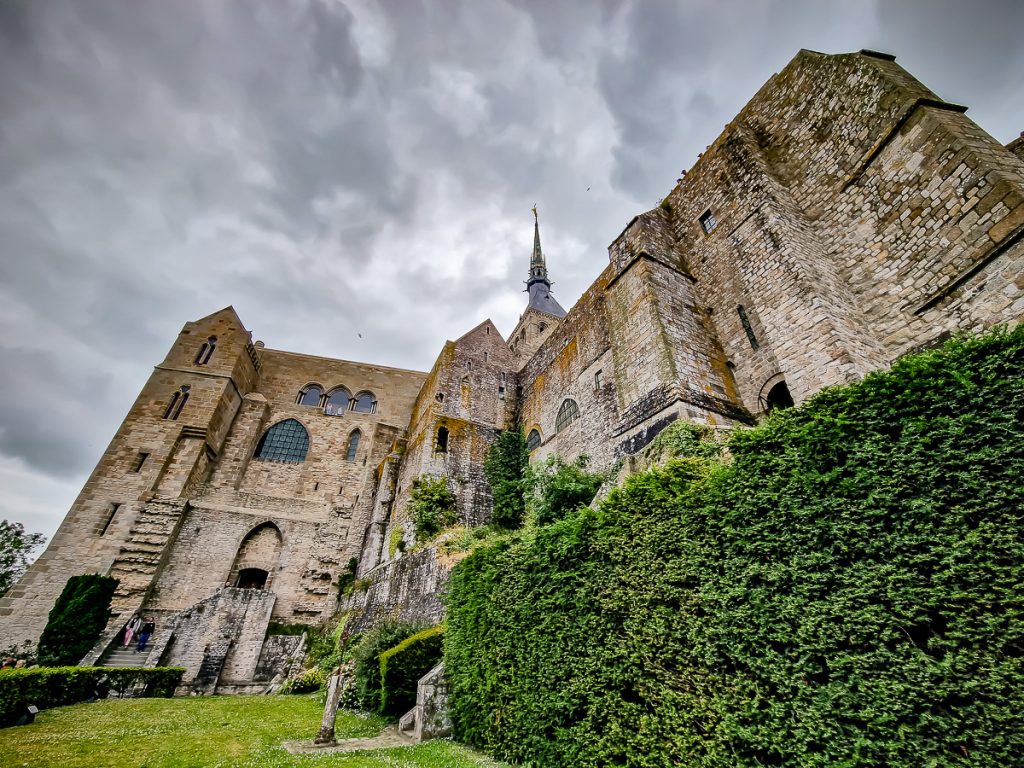
In 1874, it became a historical monument, was restored, and opened to the public.
I left the abbey somewhere at its base and remembered how I kept taking pictures of the spike, with Archangel Michael at the top – the leader of the heavenly hosts in Catholic tradition, the protector of the Catholic Church and of Normandy.
THE STATUE OF ARCHANGEL MICHAEL
Created in 1897 to be placed at the top of the new 32-meter-high bell tower, the statue stands 4.5 meters tall and weighs 450 kilograms, dominating the bay from 156 meters above sea level!
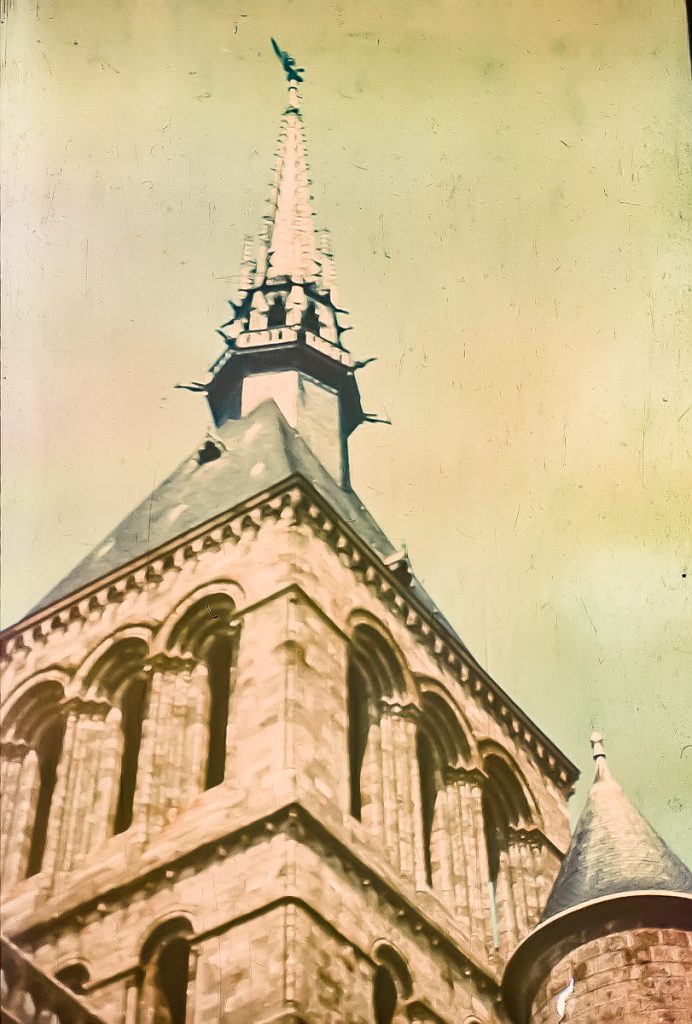
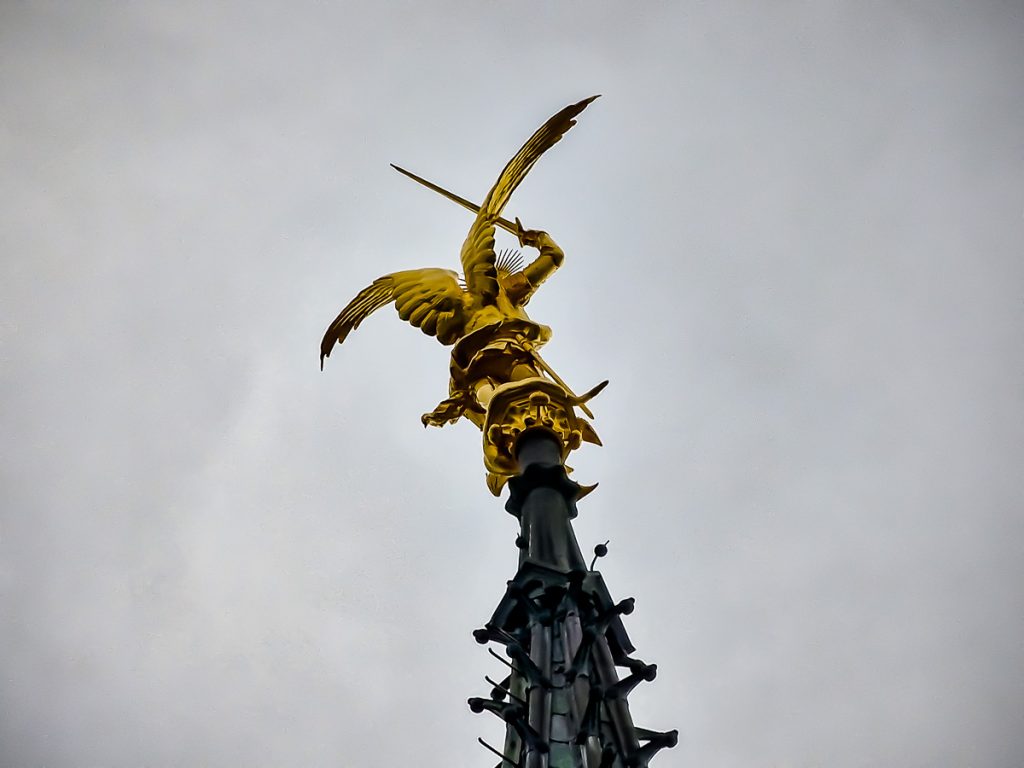
I took a photo of it in 1986, and it doesn’t seem like it was golden back then, right?…
The information I’m reading confirms it immediately: the only restoration took place in 1987, exactly one year after I saw it for the first time.
The statue has an iron structure and is covered with copper sheets and a thin layer of gold leaf. The cool part: it’s not just decorative but serves an essential function for Mont Saint-Michel: it is the mountain’s main lightning rod, ever since its creation! The tip of the sword and the wings are “receptive” to lightning…
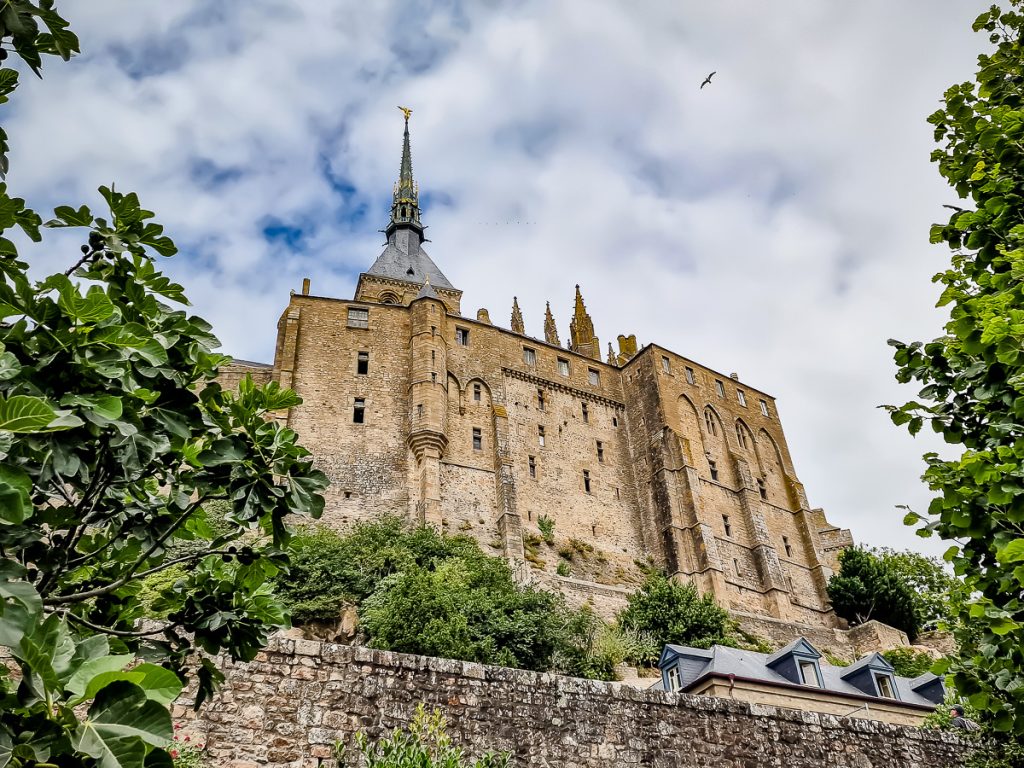
Okay, we visit, we cultivate, but… when do we actually eat? My stomach is seriously sending signals that I’ve abandoned it.
I start to head down and, contrary to the advice I received, I decide to stop somewhere to have a quick bite.
WHERE TO EAT AT MONT SAINT-MICHEL
“Not in the rock”, several people told me. Meaning, not inside the fortress, even though it’s the most convenient place when visiting Mont Saint-Michel.
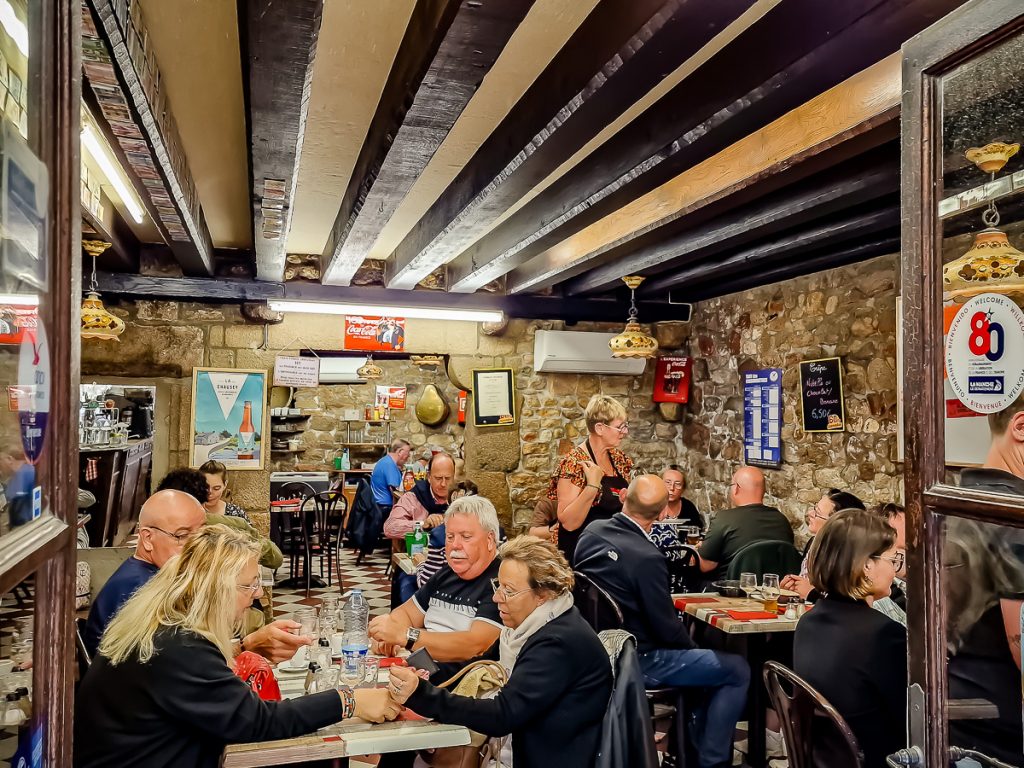
What do you expect, it’s a tourist spot, high turnover, here’s the bill, we don’t have a suggestion or complaint book, bye bye, see you again…
Despite this, I stop, starving, at one of the restaurants with double entrances – one from Grande Rue and one from the fortress wall.
I played it “safe”: a ham and cheese crepe, nothing special, nothing too tasty, but it filled my stomach.
I read about Mrs. Annette Boutiaut, who arrived at Mont Saint-Michel in 1872 as a maid. After marrying Mr. Victor Poulard, they bought an inn (at the current site of the Post Office) and began preparing something simple for the pilgrims: a fluffy omelet.
It worked out great for them, they moved in 1888 to another building, and guess what? It’s still there today! Along with the omelet!
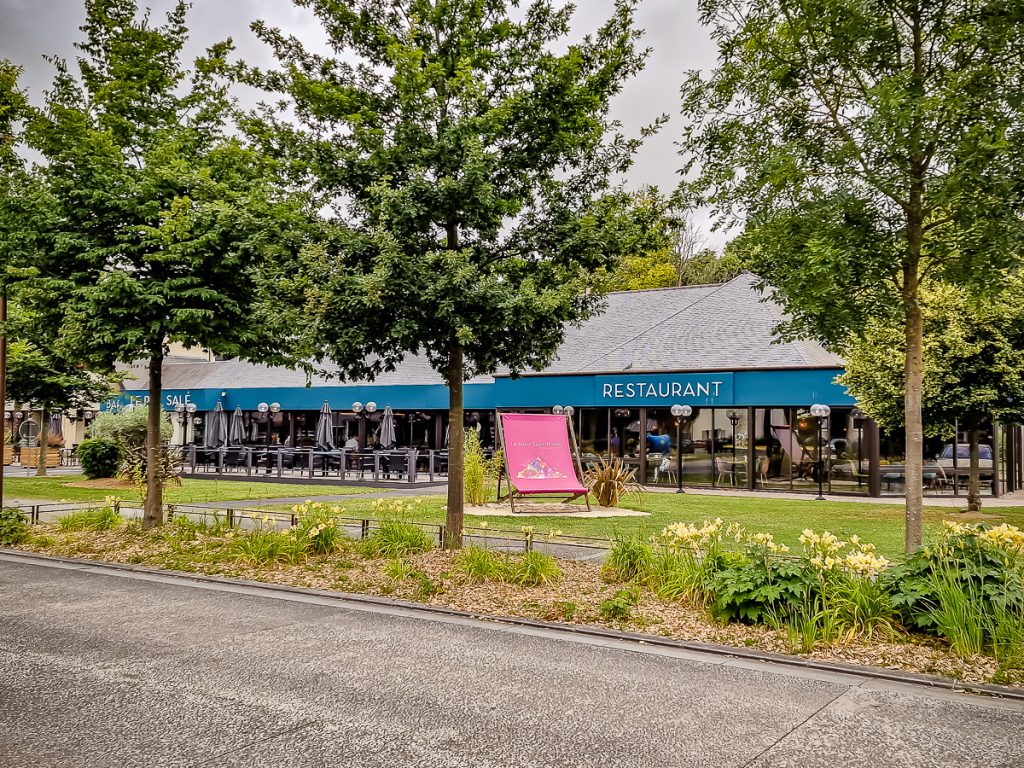
In the area with limited access across the bridge, about 2 km from the Mountain, you can eat well at any of the restaurants, but reservations are required, even if you’re staying at the hotel affiliated with the restaurant. Otherwise, it’s a matter of luck: you might find an available table, or you might not…
There are also some good options a bit further away, in the nearby villages, at farms, etc.
I had two dinners at my hotel’s restaurant. (One after the other, not at the same time…)
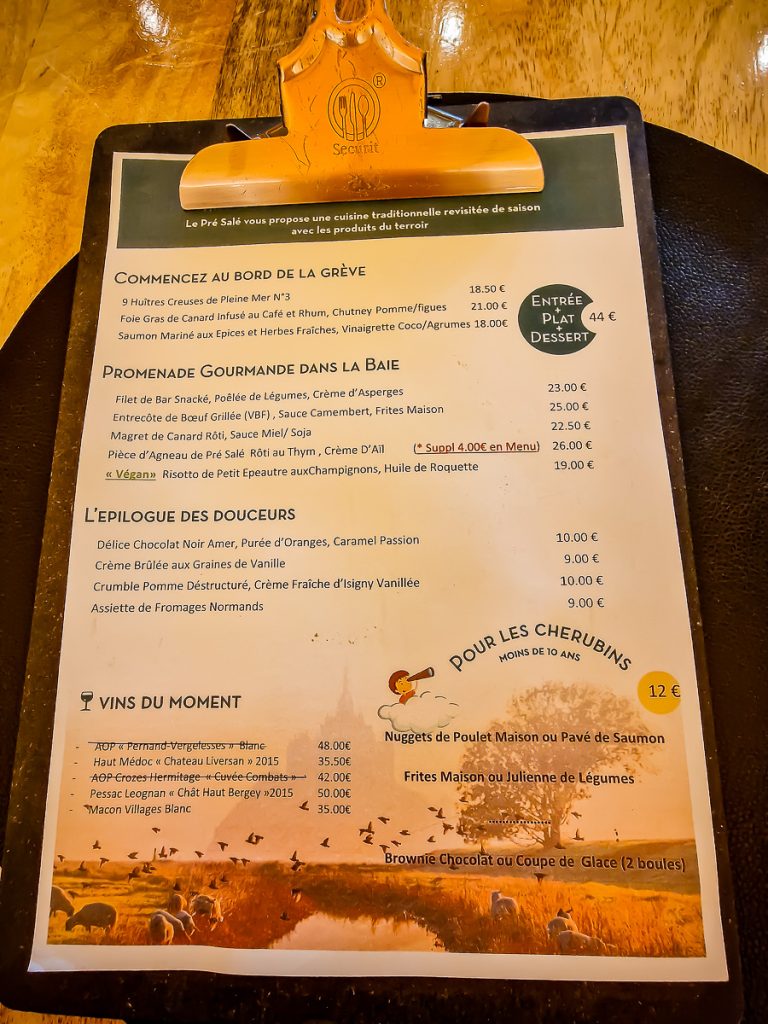
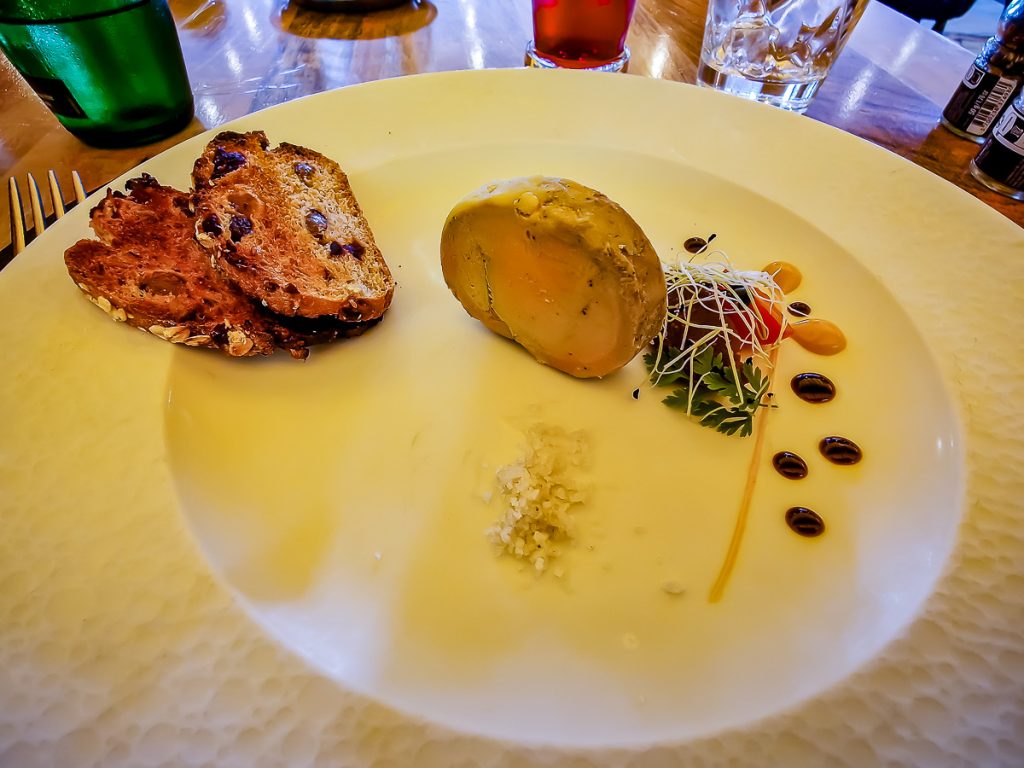
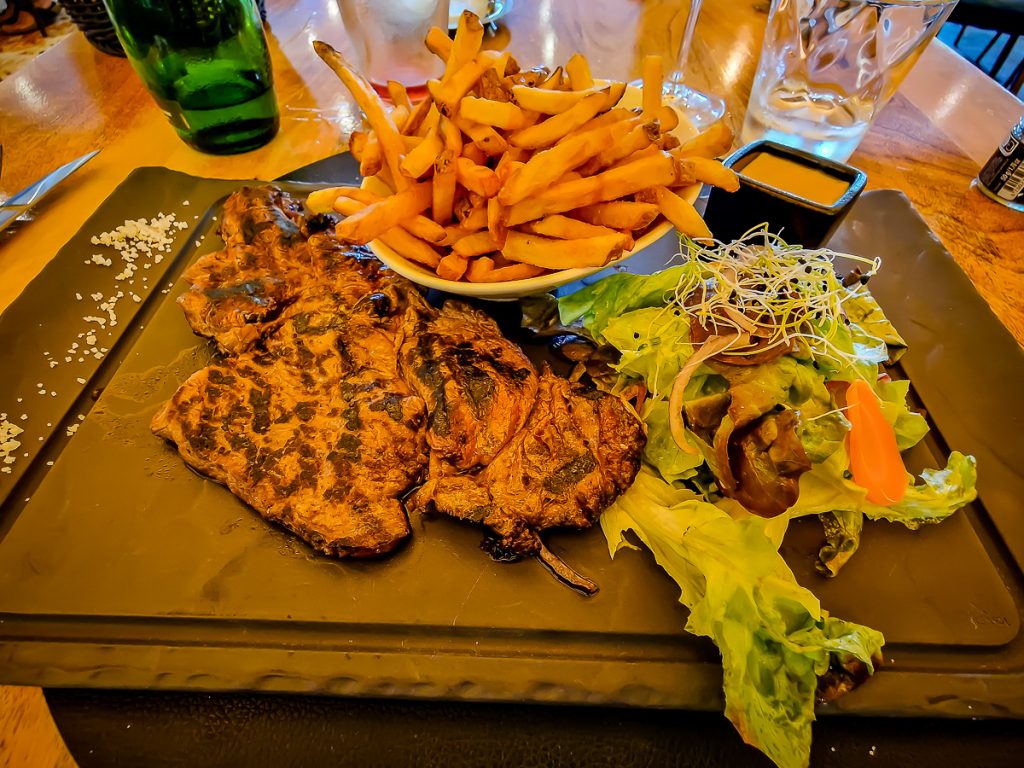
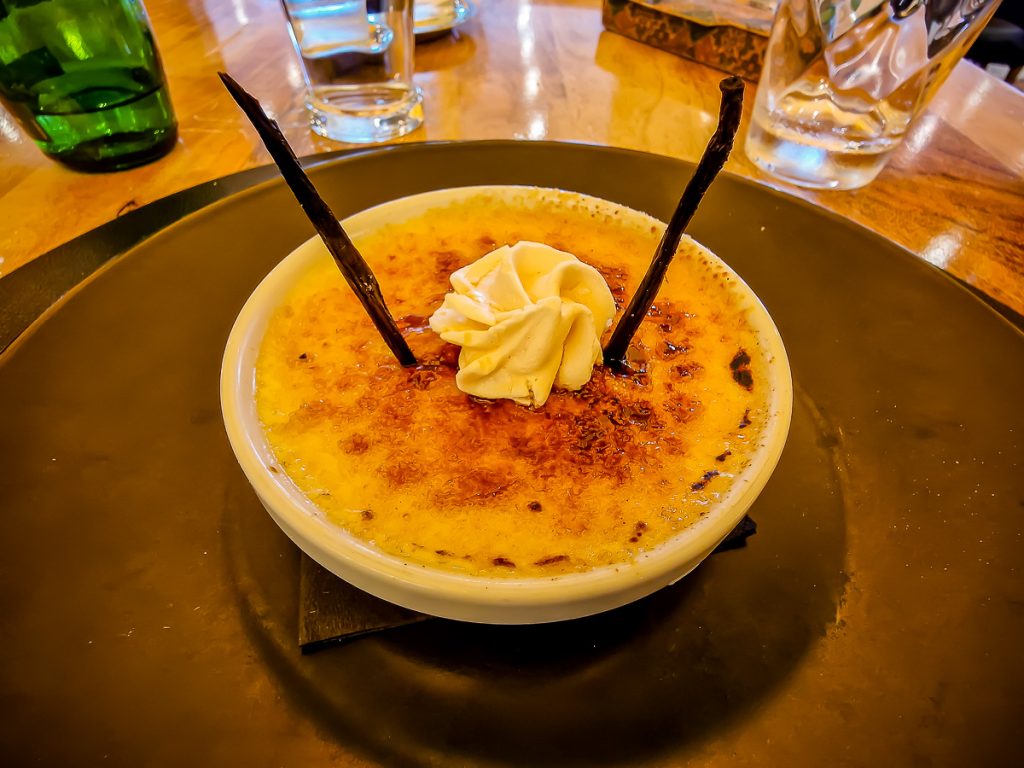
I ordered a menu: foie gras, followed by beef and a crème brûlée. All were good.
With a full stomach, as evening fell, what do you think? Did I go into my room to relax and watch a movie from the comfort of my bed??
Well, nooo. I went back to Mont Saint-Michel to see it in the dark.
MONT SAINT-MICHEL AT NIGHT
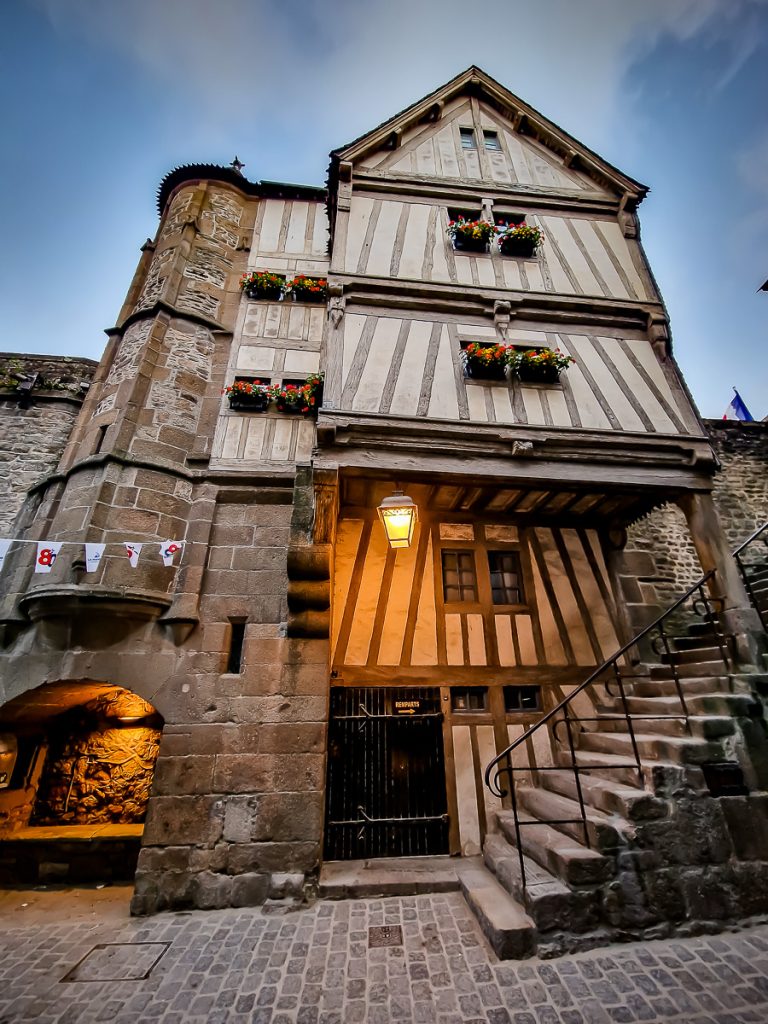
In the evening, it’s wonderful! It’s almost deserted, there’s a silence that scares me at first as I walk down the little streets. But, as I get used to it, everything seems to have a special charm.
What I love is that I can see the entire expanse of sea and sand around me disappearing into the night, and then I realize that… I need to turn on my phone’s flashlight, just to make sure I don’t trip on some steps.
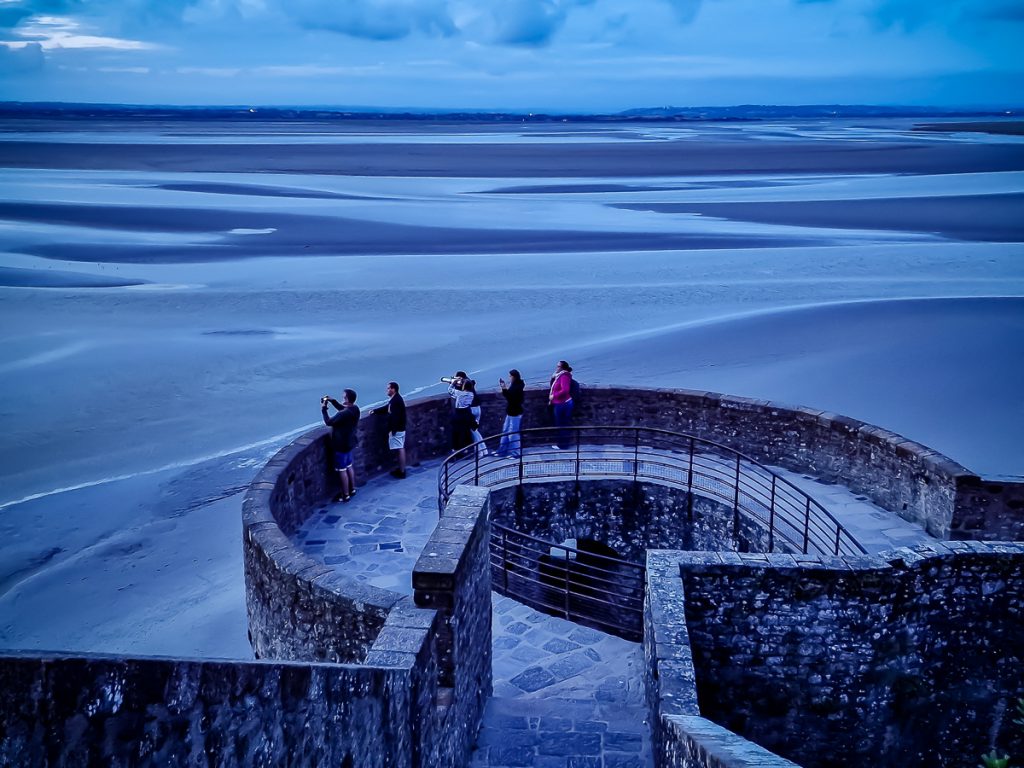
I walk along the main streets, and once I reach one of the observation points, I am amazed to see something far, far away on the horizon:
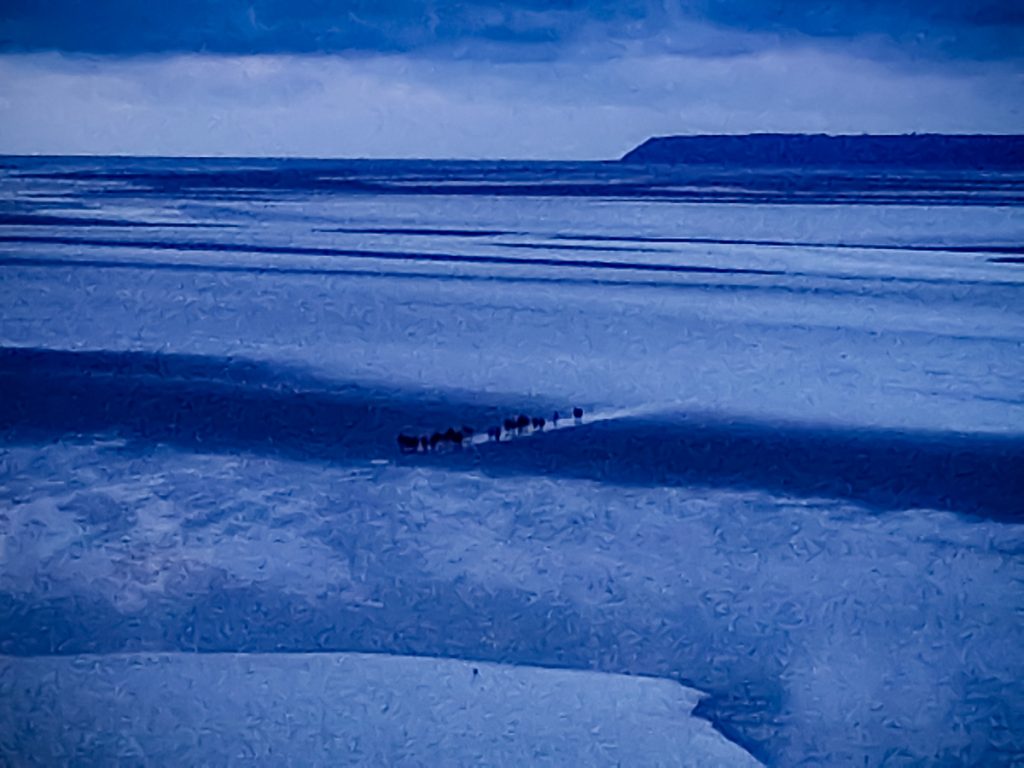
A group of people walking through the sand. Coming “from across the waters”.
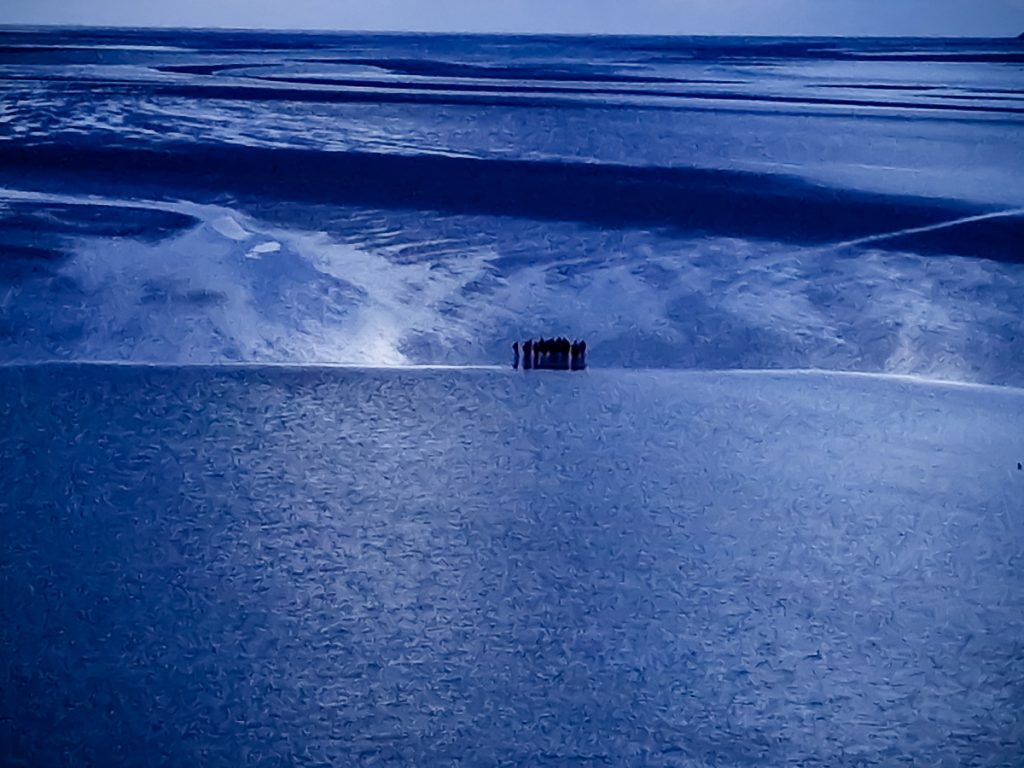
I stop and watch them, fascinated!
Arriving in an area with high water, I see them analyzing the “terrain”. Only when they are sure (I deduce) that it’s safe to cross the narrowest part of the water, they start walking in a single file:
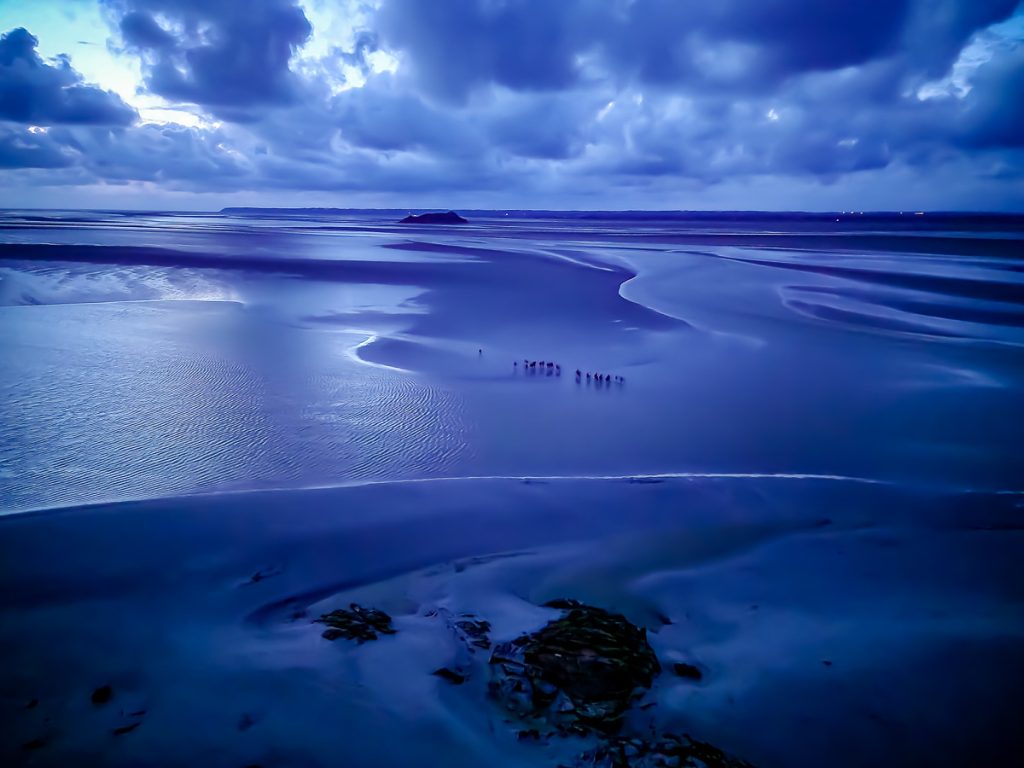
I even filmed them, as much as I could with my phone:
The next day, I would learn that this tour is a 6-hour, 14 km walk through sand and water, back and forth. It’s not a straight path, but winding, around an island, all the way to the opposite side on land.
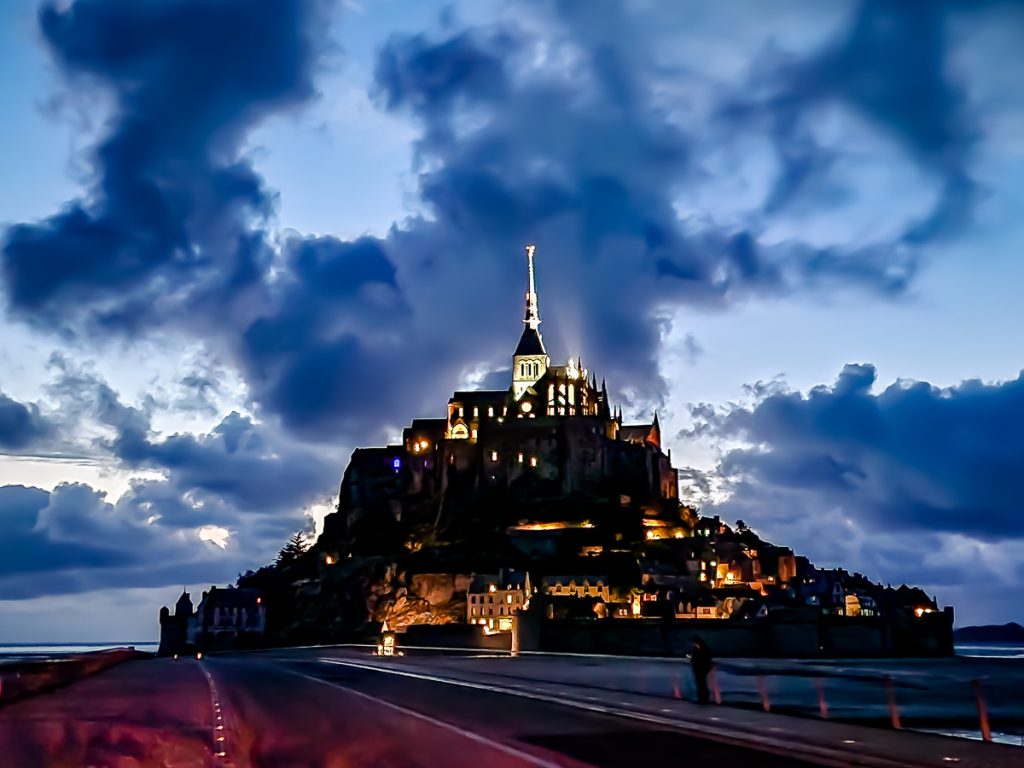
As I leave for the hotel, watching these brave souls reach the gates of Mont Saint-Michel, alive and unscathed, I think to myself that I wouldn’t venture on such a tour where I might get caught by nightfall at sea. I wouldn’t have the courage. But maybe there are tours for cowards like me.
GUIDED TOUR AT MONT SAINT-MICHEL
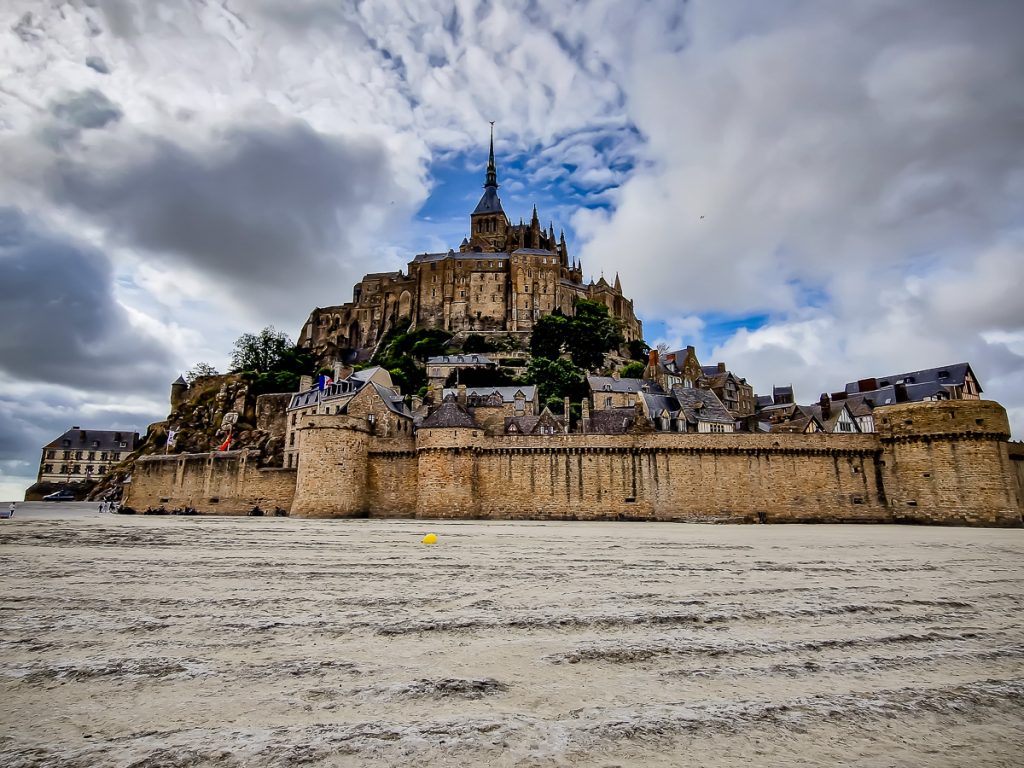
When I took this photo, I didn’t think I would find a tour that would bring me back here, to the sand, and even further, to places where my curious woman’s foot had never stepped.
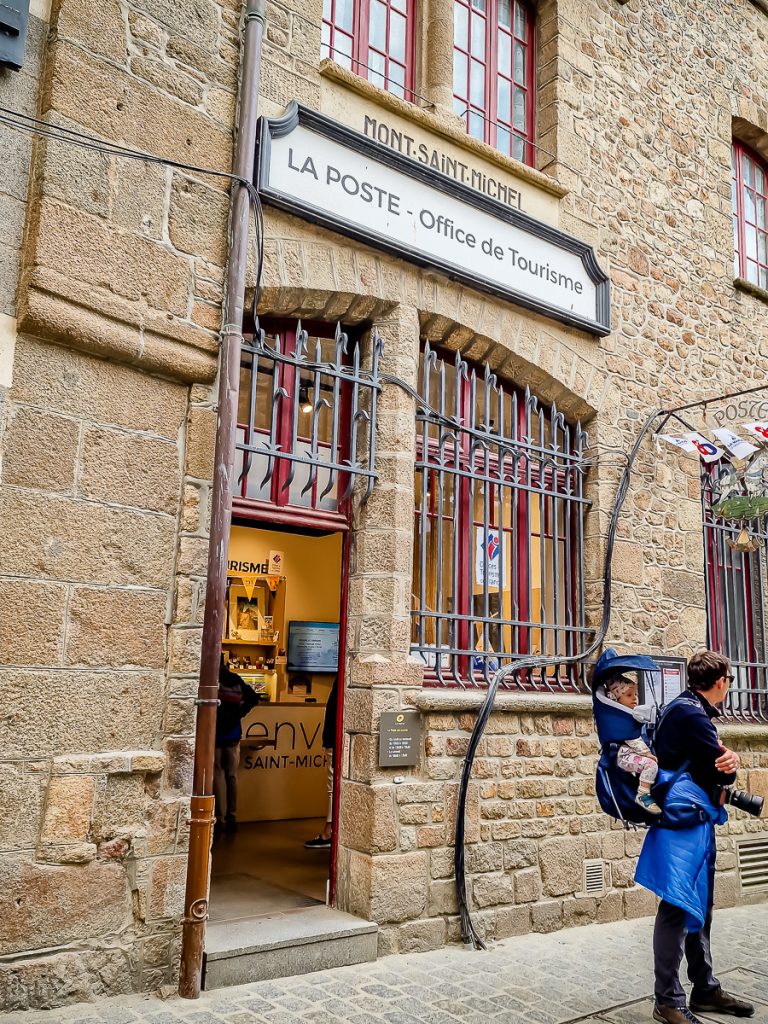
I enter the Tourist Office just because the post office is also in the same building, and I need stamps for my postcards. But, while waiting behind a client, who’s also a tourist, I start reading what’s on the walls.
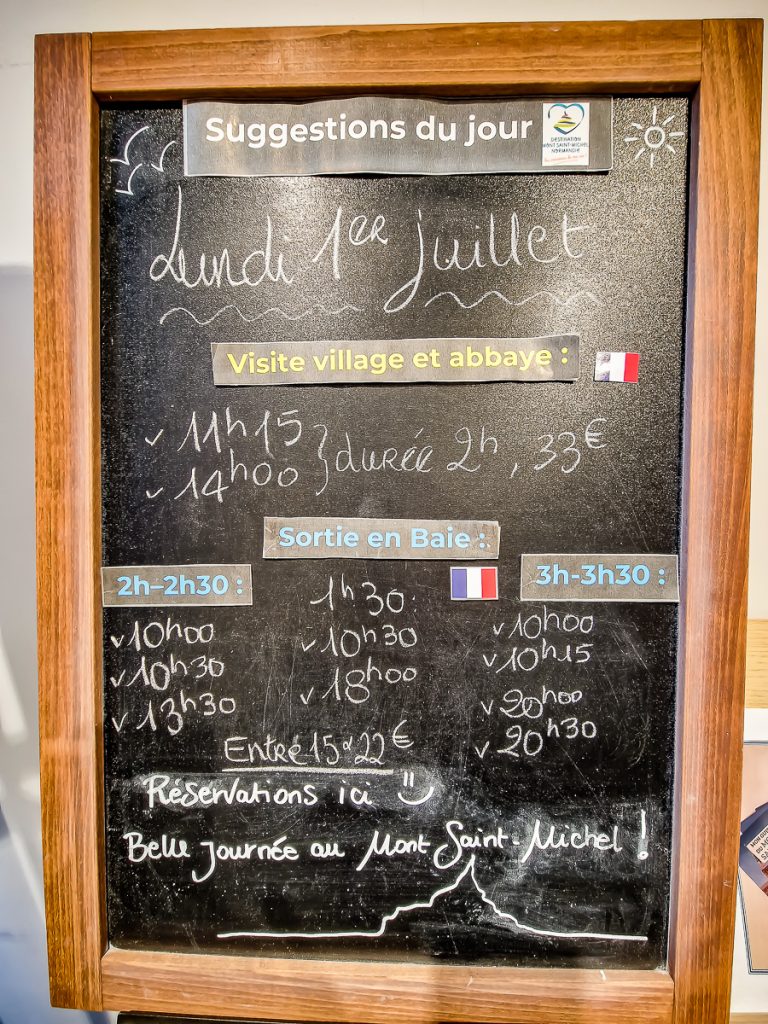
And there I am, paying for a tour. At 6:30 PM, I have to show up at the entrance to Mont Saint-Michel for a 1.5-hour tour through the sand.
I have no idea how I ended up with it, because it wasn’t even on the board, haha.
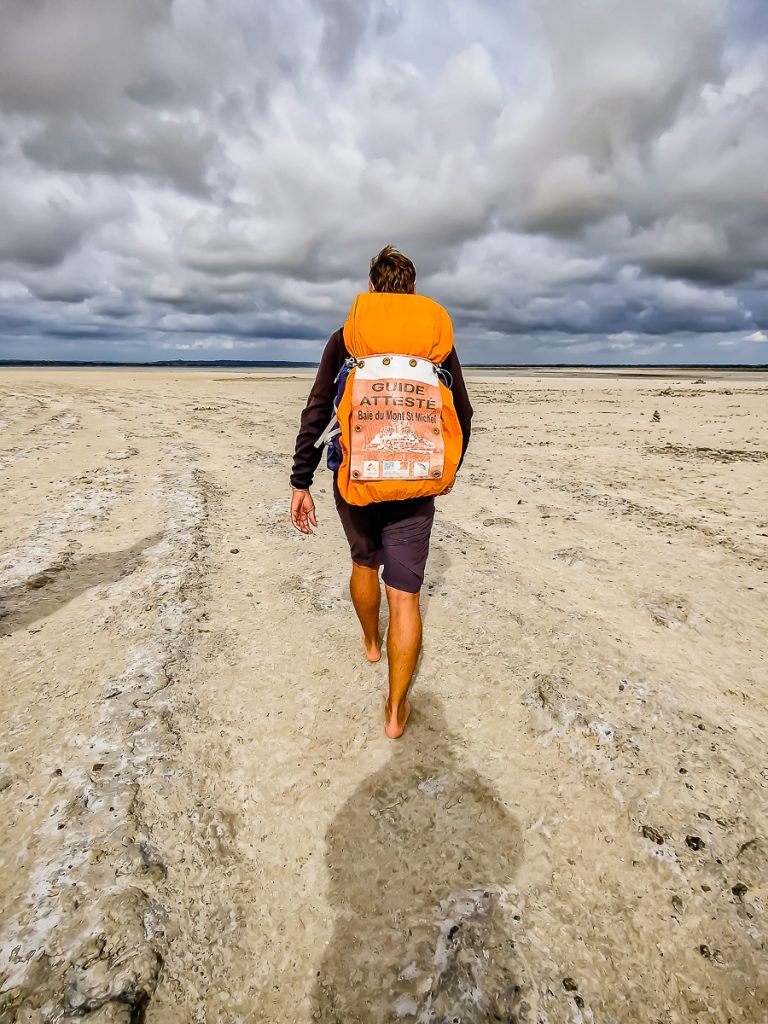
The guide picks us all up – him barefoot, us bare of wit – and leads us along, telling us everything about this place, from the moon to the stars.
For now, we walk on a surface as hard as stone. But we were warned from the start that, on this tour, we will walk through sand, and also through water.
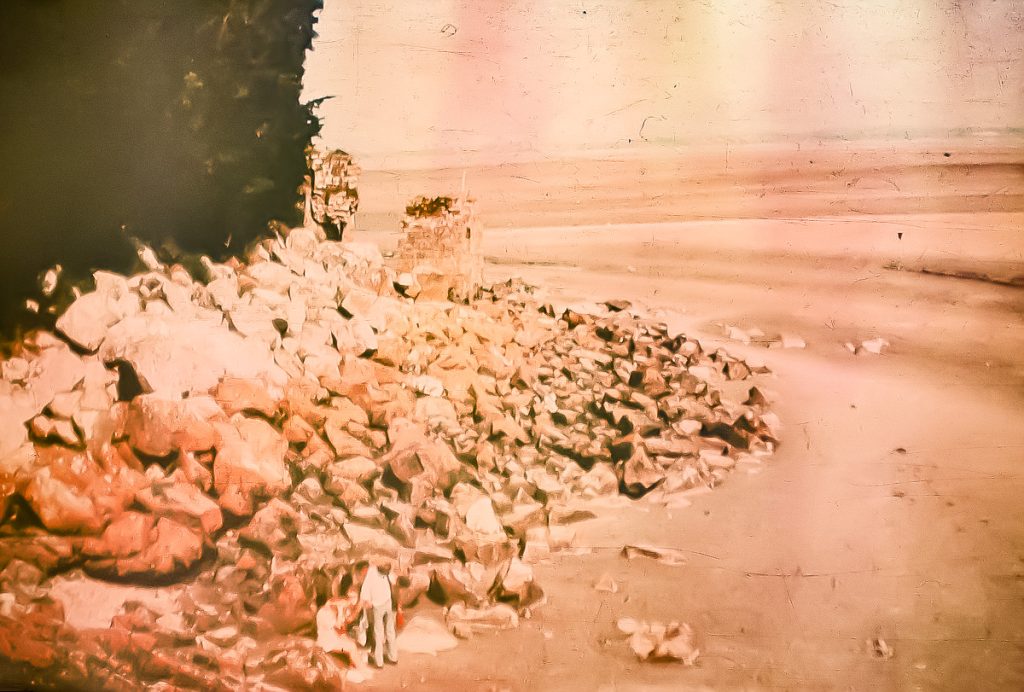
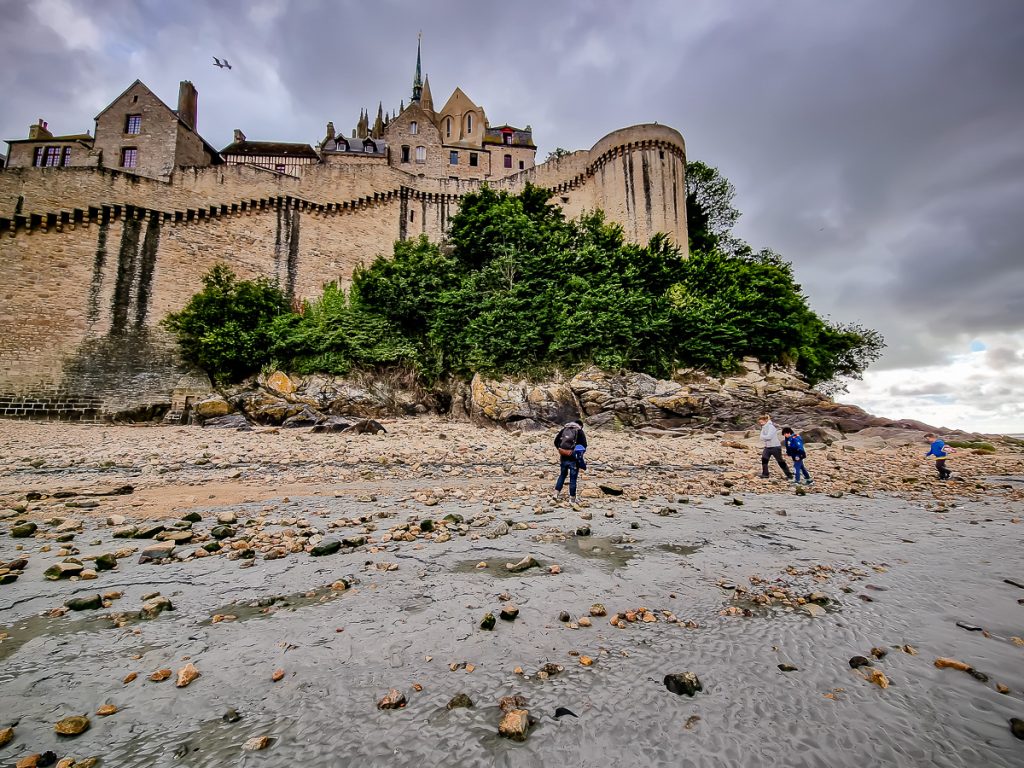
I try to compare it to what I photographed in 1986. Even the boulders aren’t what they used to be…
However, the warning remains the same: it’s dangerous to venture through the area alone, especially because of the shifting sands!
The tides are so fast and powerful on some days that the sand becomes unstable. A super dangerous trap!
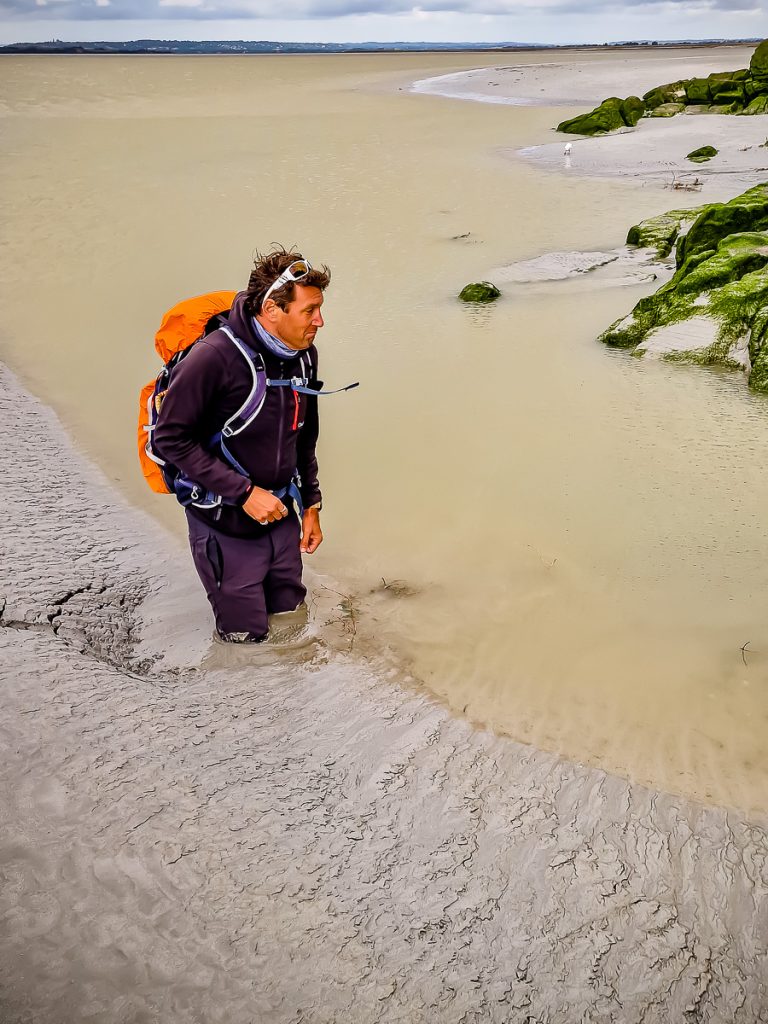
The guide even demonstrates how you can sink and get stuck (or, if you struggle, sink even deeper). Just watching him gives me goosebumps!
And what does he do next? He asks for volunteers, and a few even offer to test escaping from the quicksand.
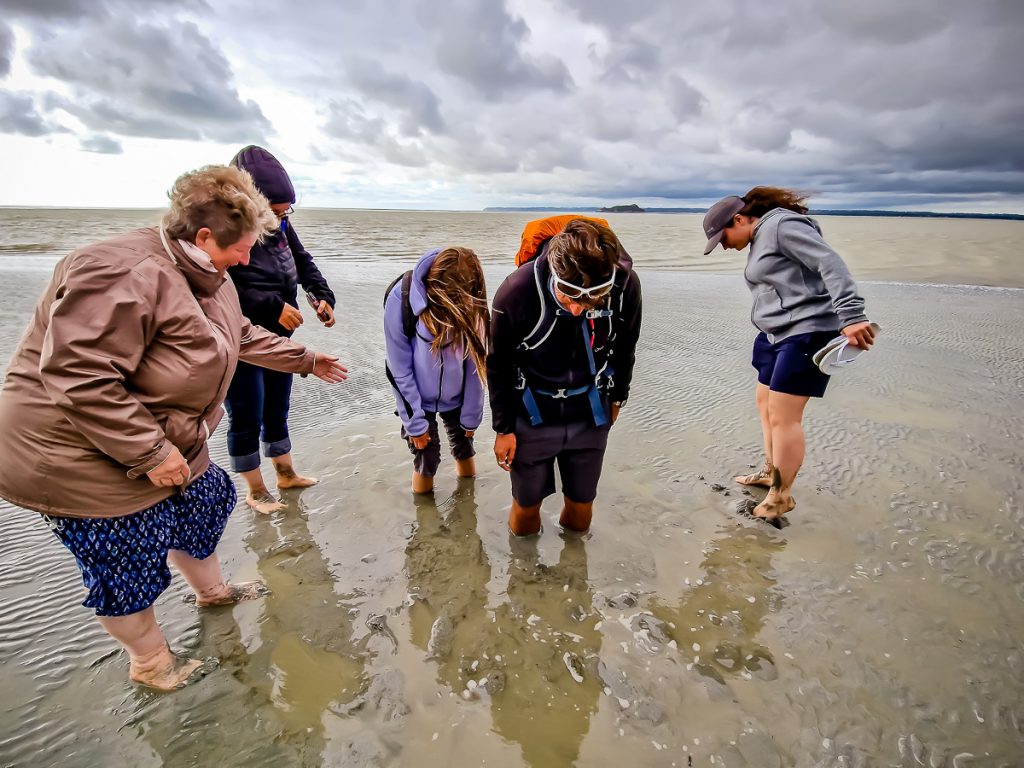
I’m all ears and eyes because, where there’s no head, woe to the feet, right? Apparently, if you’re stuck in the sand, you should move only one of your trapped feet, back and forth gently, until water starts to seep in and creates a space. Then, you remove the foot by twisting your foot, because if you pull it vertically, it won’t work – you’re caught like in a vice!
After you kneel on the sand with the saved foot and start doing the same movements with the other foot.
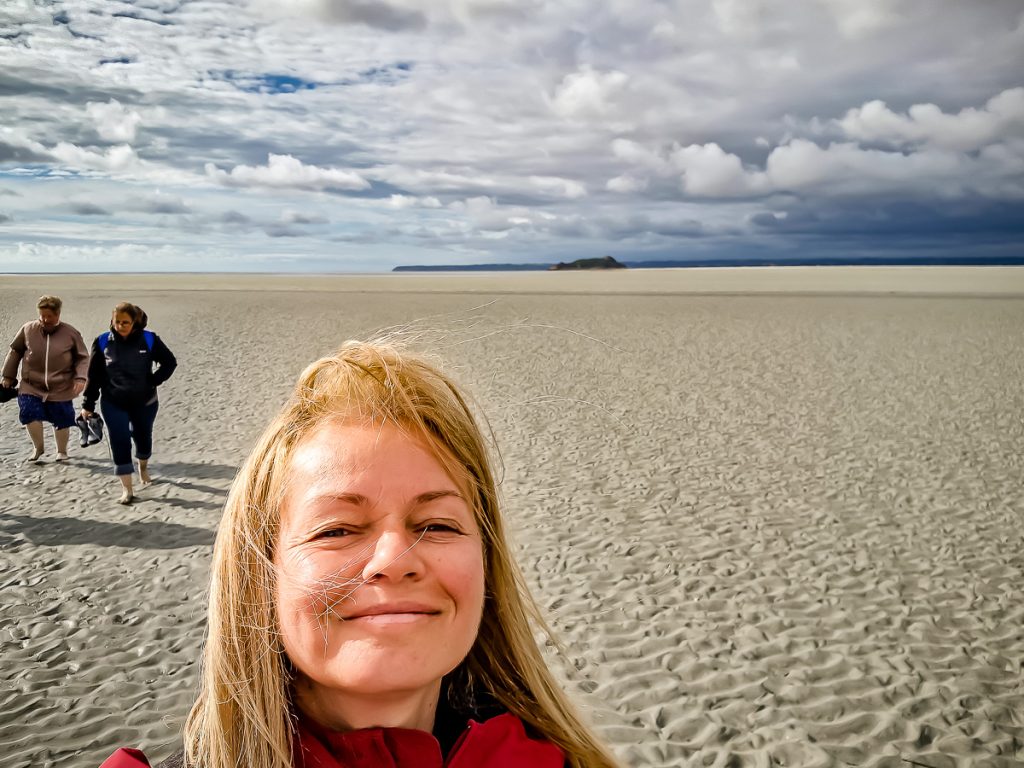
Well, I’ve learned something new! Even so, walking barefoot, I don’t feel like lingering too long in one spot, because I can feel my feet sinking in, brrrr.
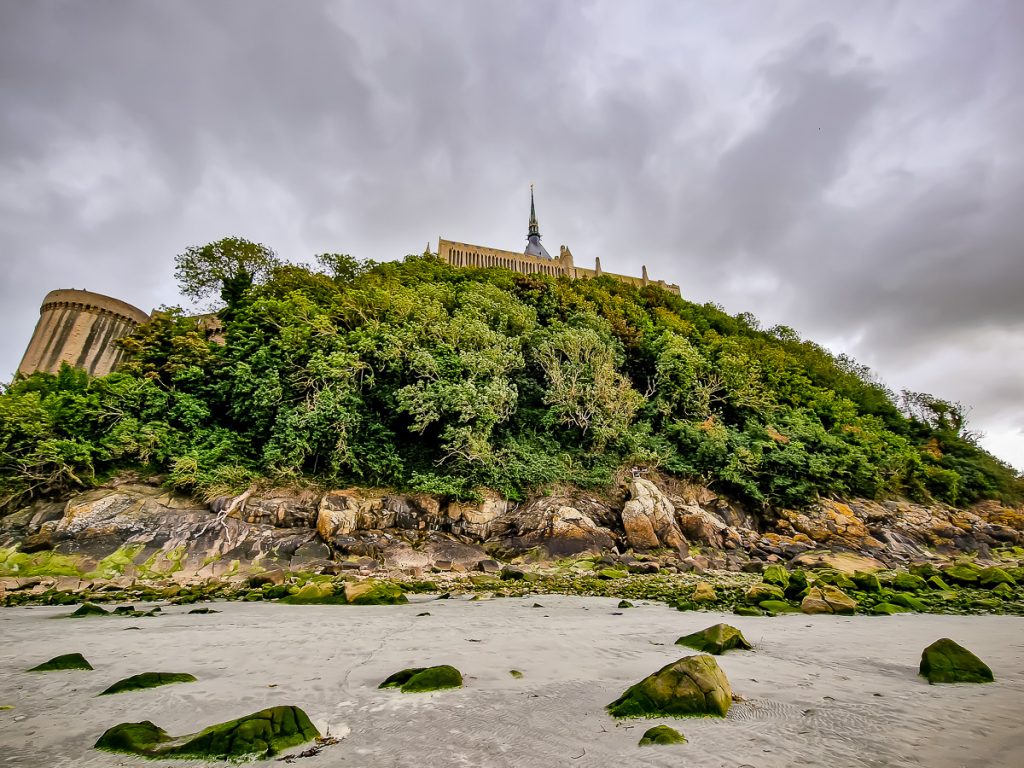
We don’t make the full loop around the island, as I had thought. The guide says it’s difficult to walk through the northern part. I remember that back in 1986, I took a photo of something there without knowing what it was:
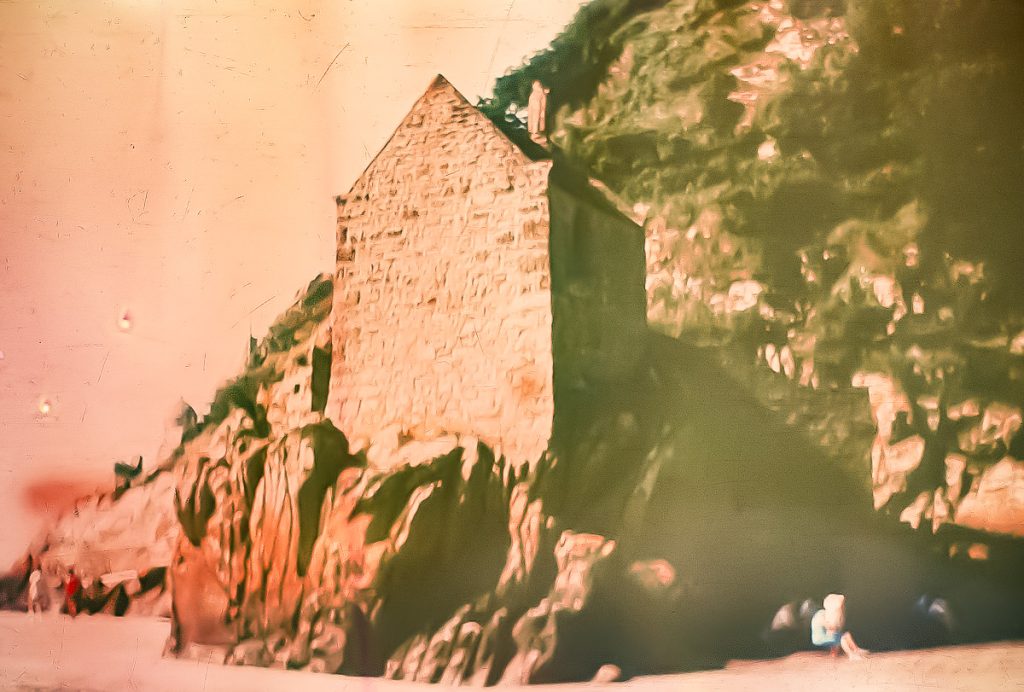
Only now do I read about it: it’s a small chapel dating back to the 12th century. It was built on a rock above the sea in honor of Bishop Aubert – one of the founders of the town.
It’s considered a “secret” spot of Mont Saint-Michel! Perhaps because of its location, situated beyond the fortress walls.
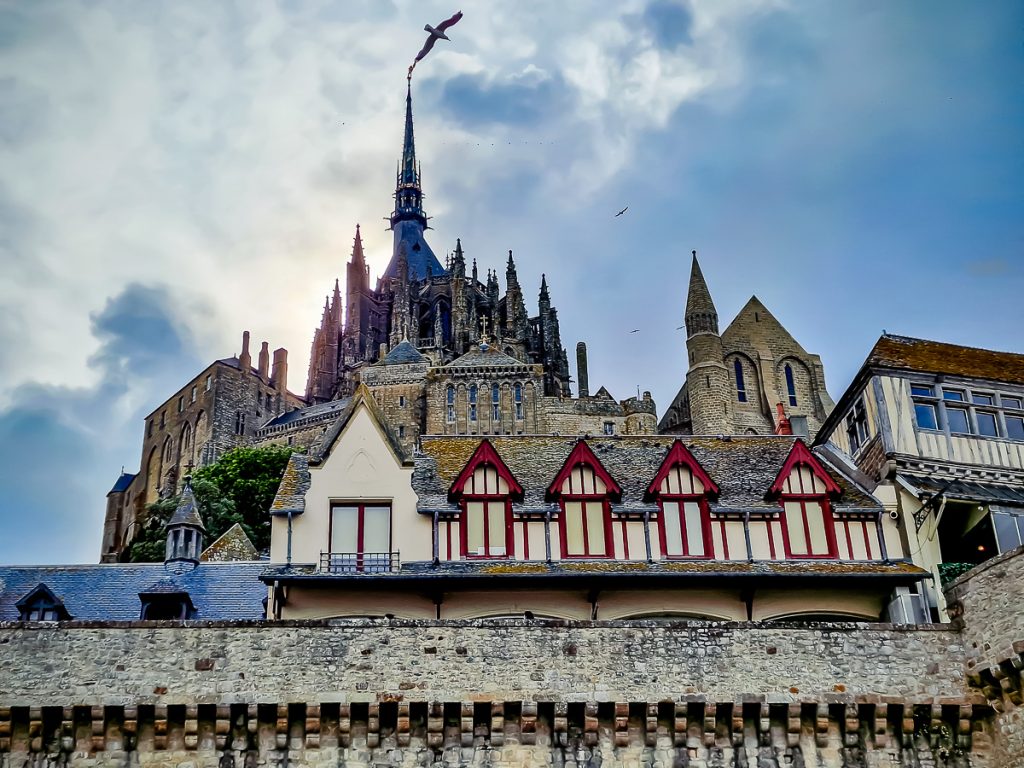
We return, sometimes on the sand, sometimes through the water, toward the main entrance of Mont Saint-Michel.
The whole walk took us about 2 hours. With stories, questions, experiences, and mud on us.
I wash my feet at the fountain and leave. At the end of the bridge, I stop at a spectacular dam, which I had seen repeatedly from the bus.
THE DAM OVER THE COUESNON RIVER
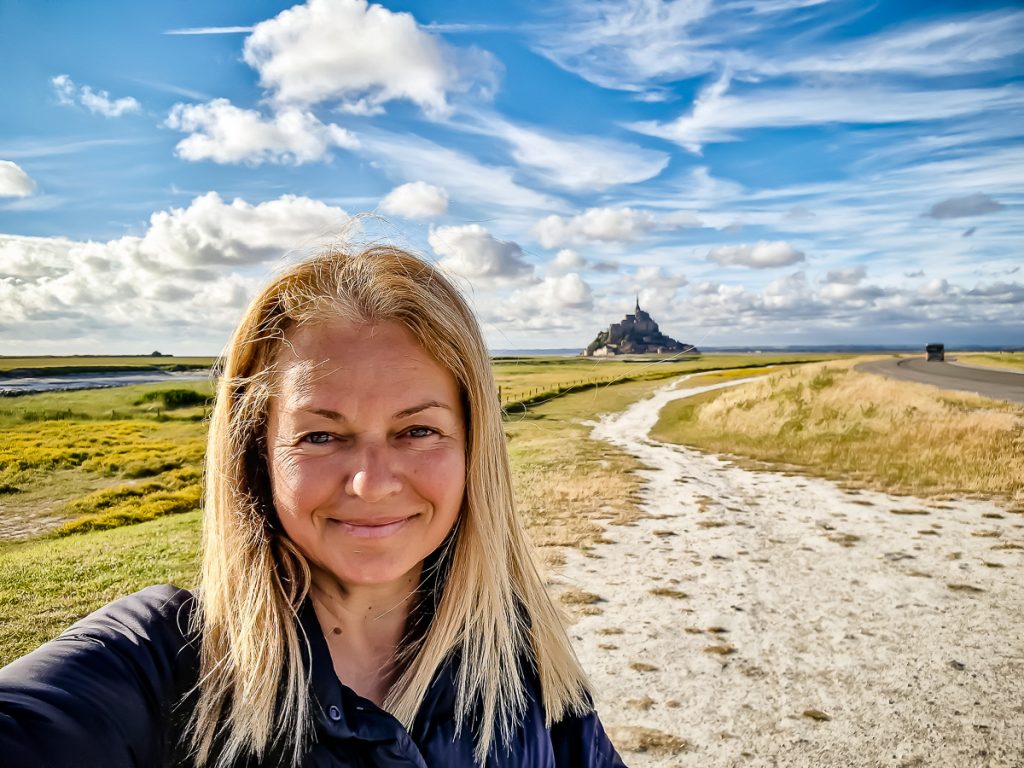
The dam is impressive, but I started with selfies haha. Mont Saint-Michel looks so amazing from here (too)!!!
Beyond the paved road to Mont, there’s also a path you can take. A road along the river, kind of like in the countryside. I mostly saw cyclists on it.
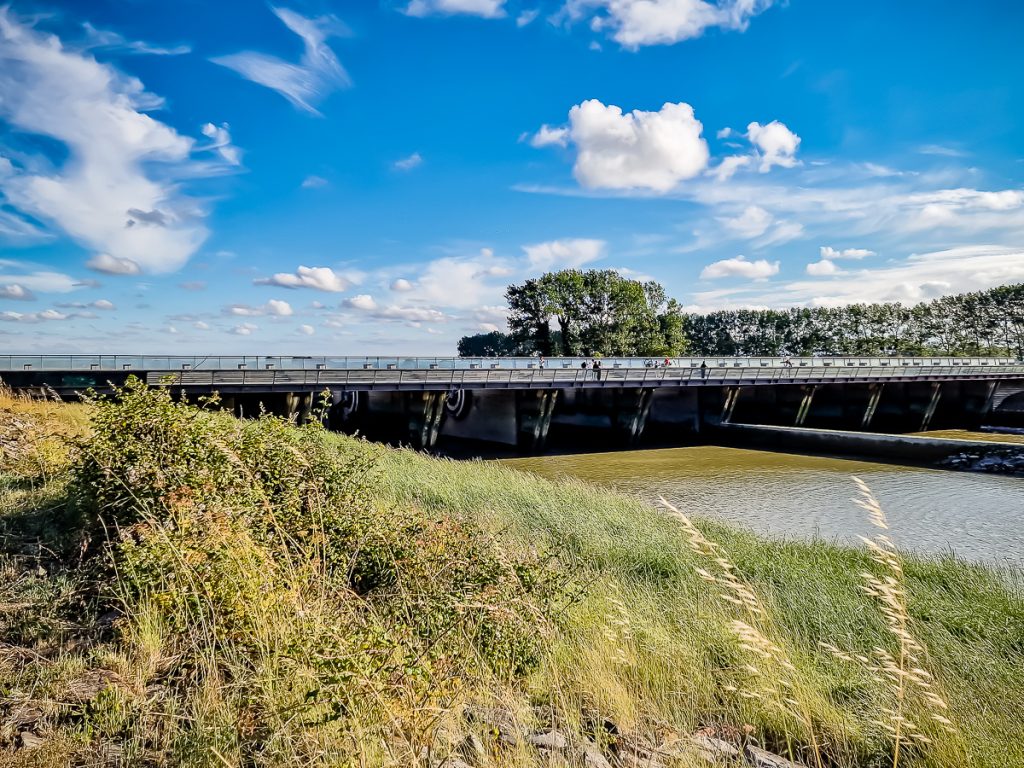
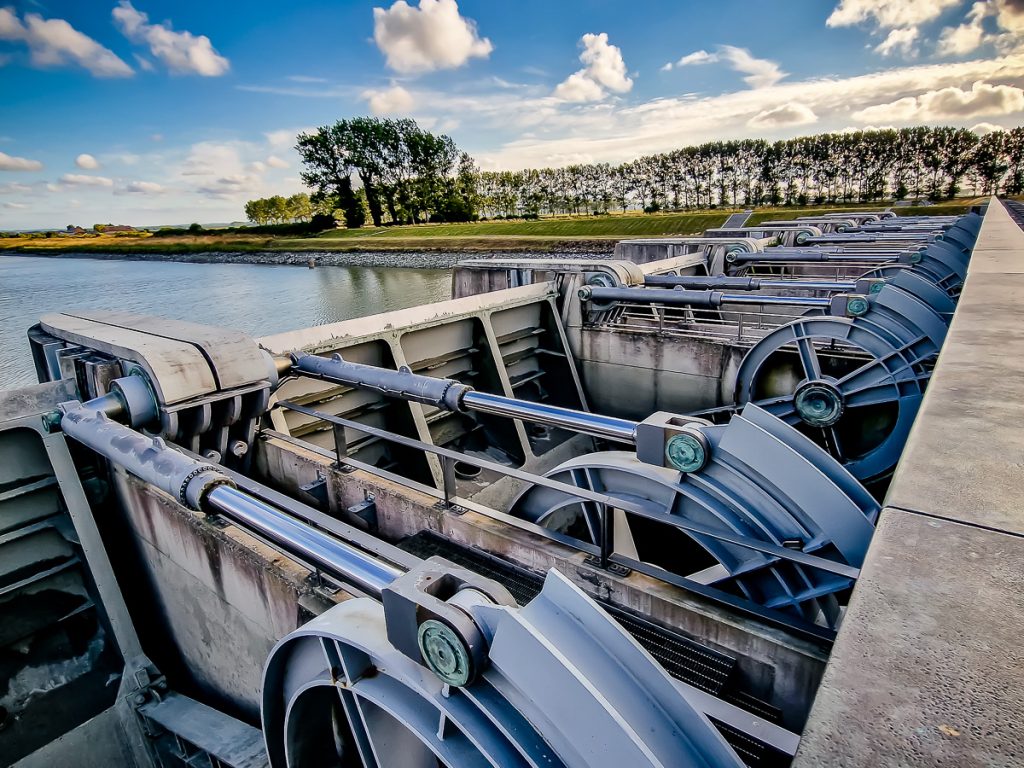
Well, let’s get back to the dam.
This dam is famous because it regulates the water flow to Mont, and it’s said to be proof of impressive engineering! I look at the mechanism like a cat staring at a calendar, say “wow”, and then enjoy how they built the bridge over the dam:
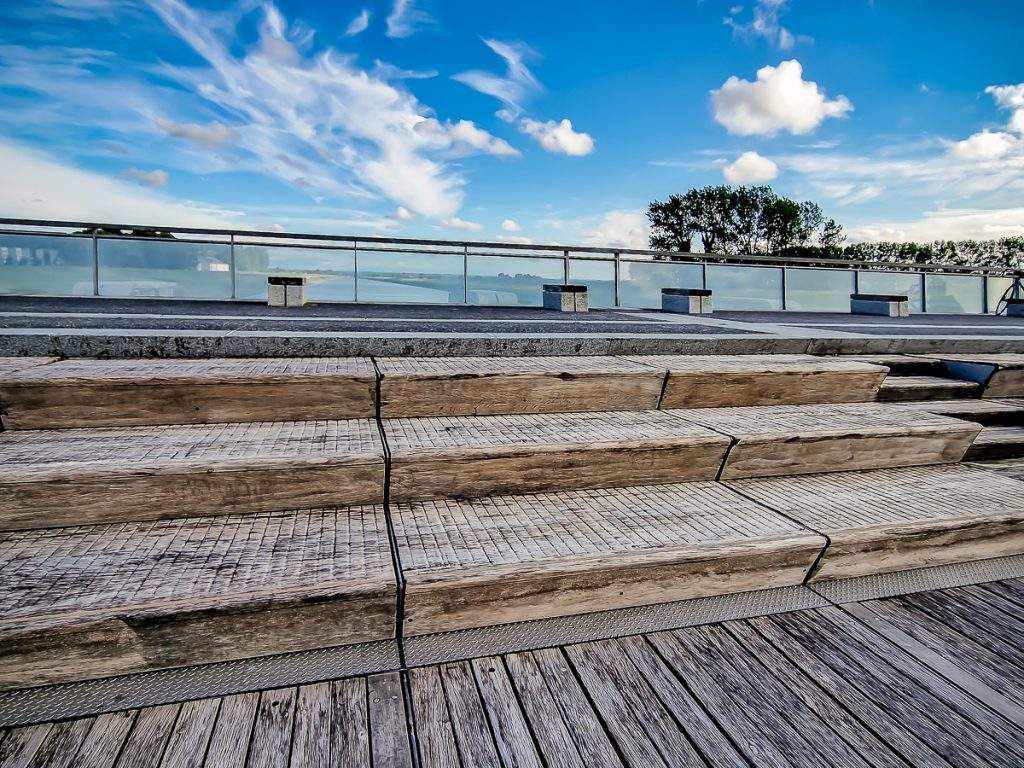
There are wide wooden steps, like benches, where you can sit and contemplate as long as you want. These steps, at sunset, are filled with people!
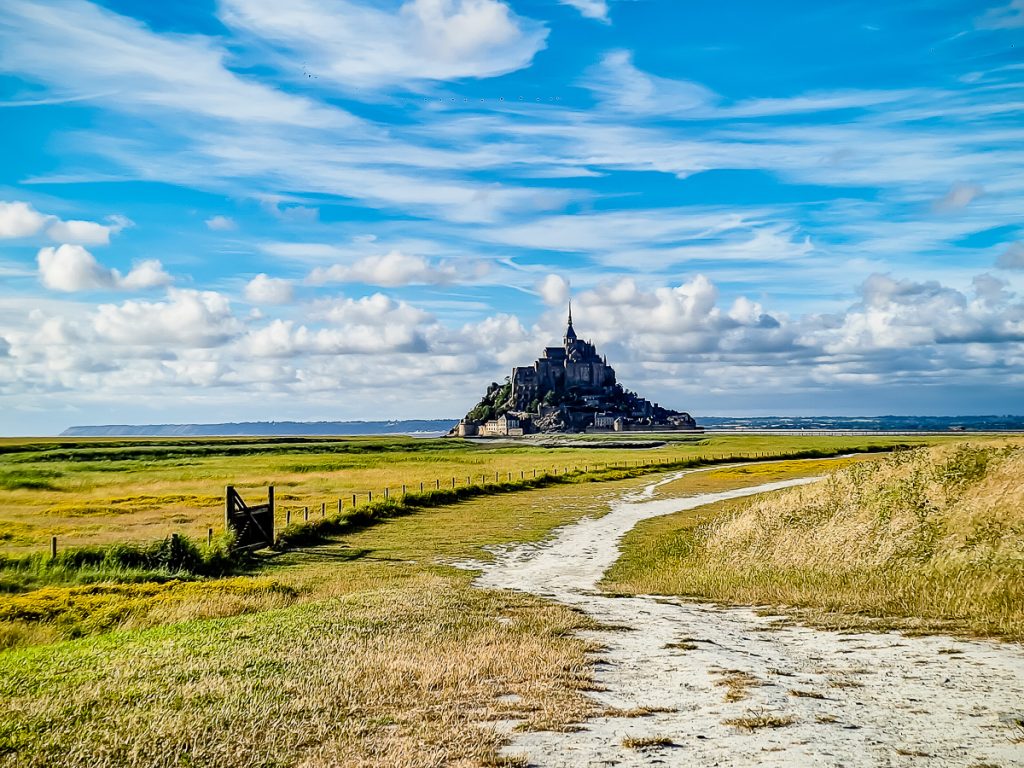
I sit down and let my eyes feast on the daytime view; I take advantage of a passerby who appears and ask them to take a picture of me because my smile is sore from so many selfies…
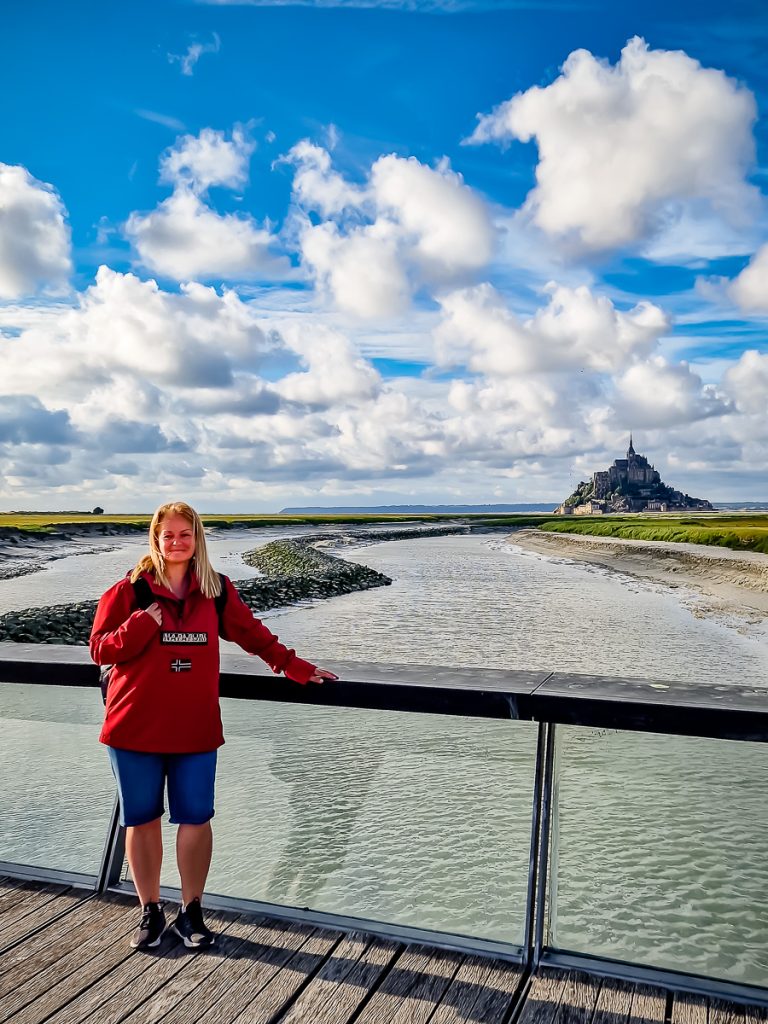
And speaking of selfies, I must confess, pay attention: in just one full day + one evening spent here, I took no more, no less than……… 214 selfies!!!!!!!
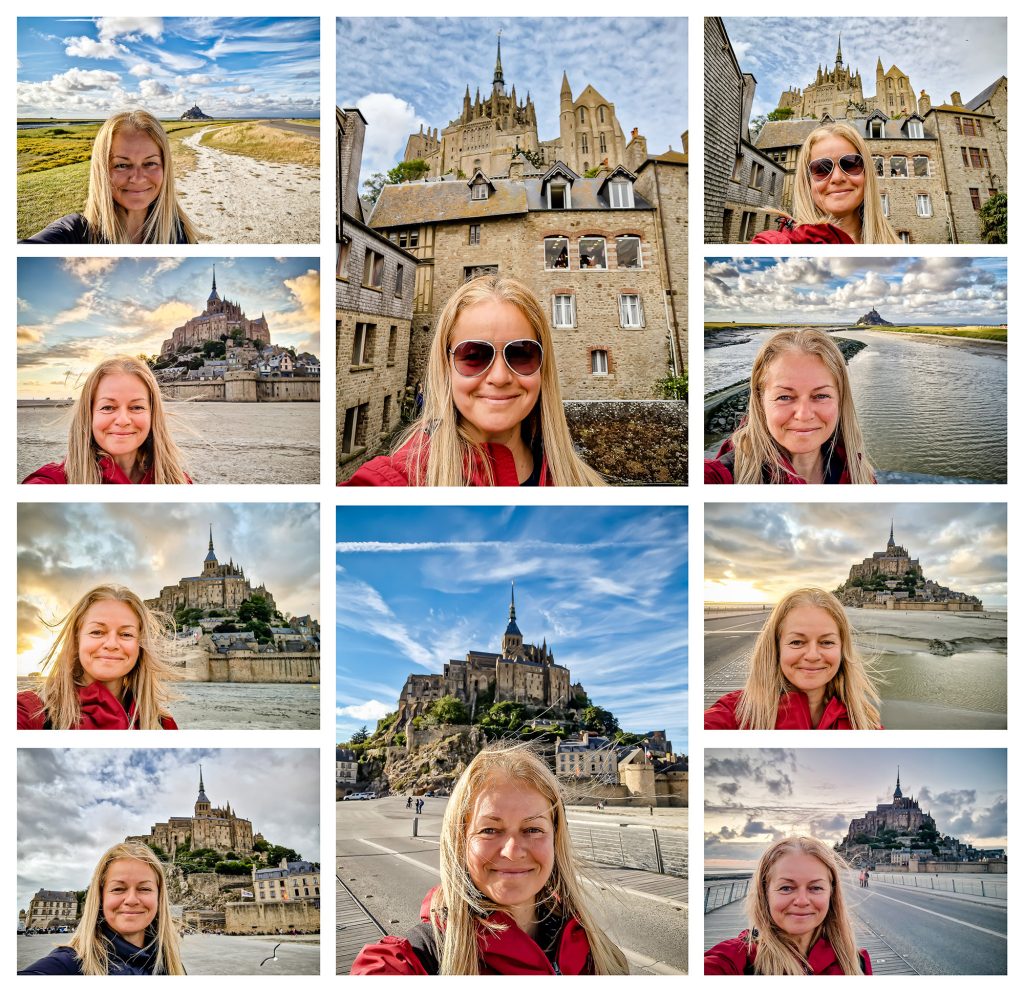
Ok, ok, I’m going to take my pills now 🙂
To wrap up, I can’t wait to show you my journey through Normandy, all the way to Mont Saint-Michel. Until then, here’s my first stop of this vacation, in a real paradise! And here, how I brought Romanian brined cheese to a Michelin-starred restaurant in Normandy…
